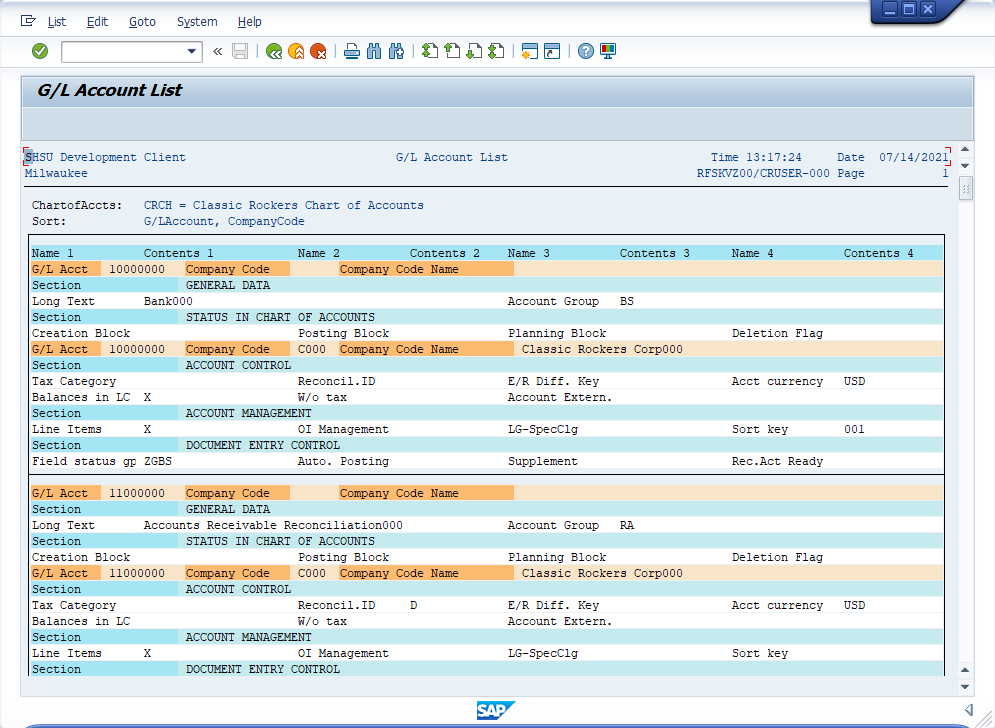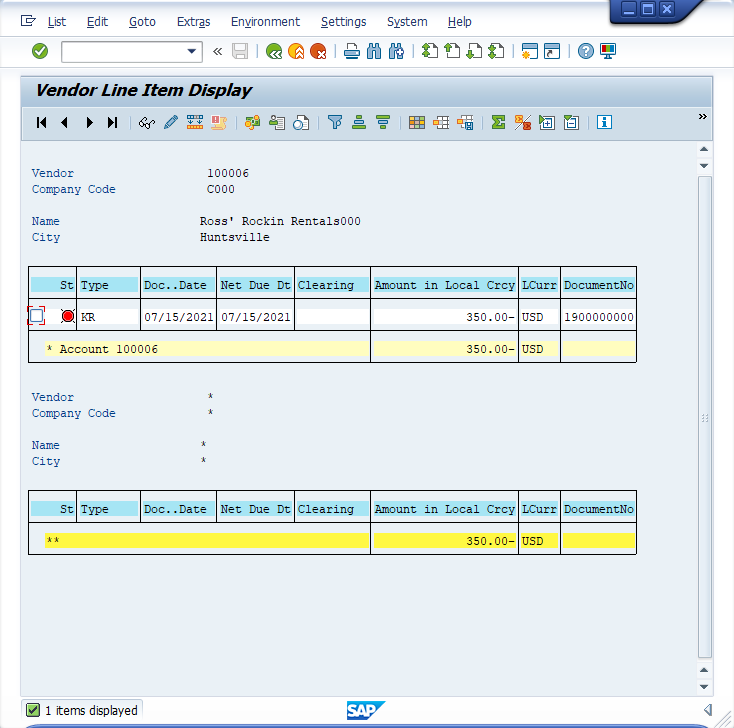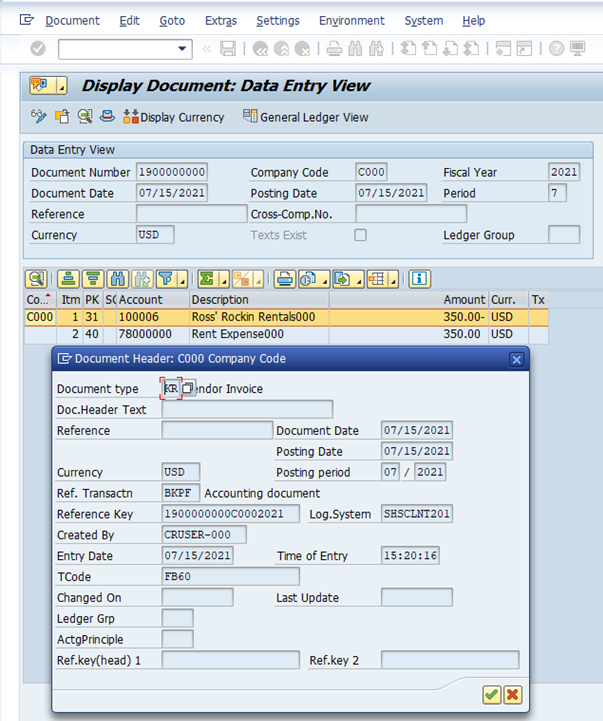Information systems ⇒ general report selection ⇒ financial accounting ⇒ general ledger reports ⇒ master data ⇒ g/l account list ⇒ sap minimal variant
Classic Rockers Case
Processing Transactions through the
Logistics and Support Processes of SAP with an Emphasis on Internal Control
09/01/2021
Sam Houston State University
Exercise 1: Setup parameter ID
System ⇒ User Profile ⇒ User Data
Maintain User Profile
Select the Parameters TAB
Enter the PID and Parameter values in ALL CAPITAL LETTERS as these entries are case sensitive!
| Set/Get Parameter ID | Parameter value | Short Description (displays after selecting Enter below) |
| C_ _ _ | Company code | |
| C_ _ _ | Controlling area | |
| C_ _ _ | Purchasing organization | |
| 20yy (current year) | Fiscal year | |
|
C_ _ _ | Plant |
|
C_ _ _ | Sales organization |
Exercise 2: Post Statistical Key Figure
At the end of the month, the total rent expense posted in cost center A060 (in exercise FI/CO10) must be distributed to the various cost centers (in exercise FI/CO15) that use the building that has been leased. This distribution is based on the number of square feet that each cost center occupies in the building. In this exercise you set up the statistical key figure “square feet” and the quantity of square feet for each cost center that will receive part of the rent expense charge when it is distributed.
Accounting ⇒ Controlling ⇒ Cost Center Accounting ⇒ Actual Postings ⇒ Statistical Key Figures ⇒ Enter
Postg Date: Today
Select Scrn Var: Cost center
In this exercise you set the fixed and variable costs for planned production activity (production will be performed in the PP exercises).
Accounting ⇒ Controlling ⇒ Cost Center Accounting ⇒ Planning ⇒ Activity Output/Prices ⇒ Change
Version: Plan/Act - Version Value: ____________
From period: 1 (January) Value: ____________
Check Entry: Free
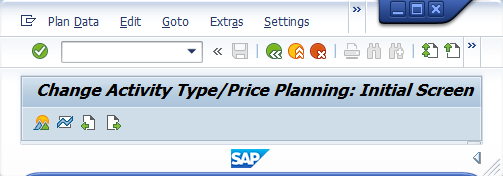 (OVERVIEW)
(OVERVIEW)
(NEXT or PREVIOUS)
Cost Center P020
Plan activity: 500000 hours
Variable price: $6.00
Exercise MM01: Create General Ledger Reconciliation Account (Accounts Payable)
A sub-ledger account is used wherever there is a high volume of transactions. The information is summarized for the general ledger into a reconciliation account. The sub ledger can be an Accounts Receivable or Accounts Payable account. The reconciliation account for Accounts Payable must be created before business can be carried out with vendors.
Type/Description TAB:
G/L Account Type: Balance Sheet Account
Account currency: United States Dollar Value: ______________
Recon. Account for Acct Type: Vendors

Exercise MM02: Create business Partner (Gen.) MAster
Create in BP role: Business Partner (Gen.)
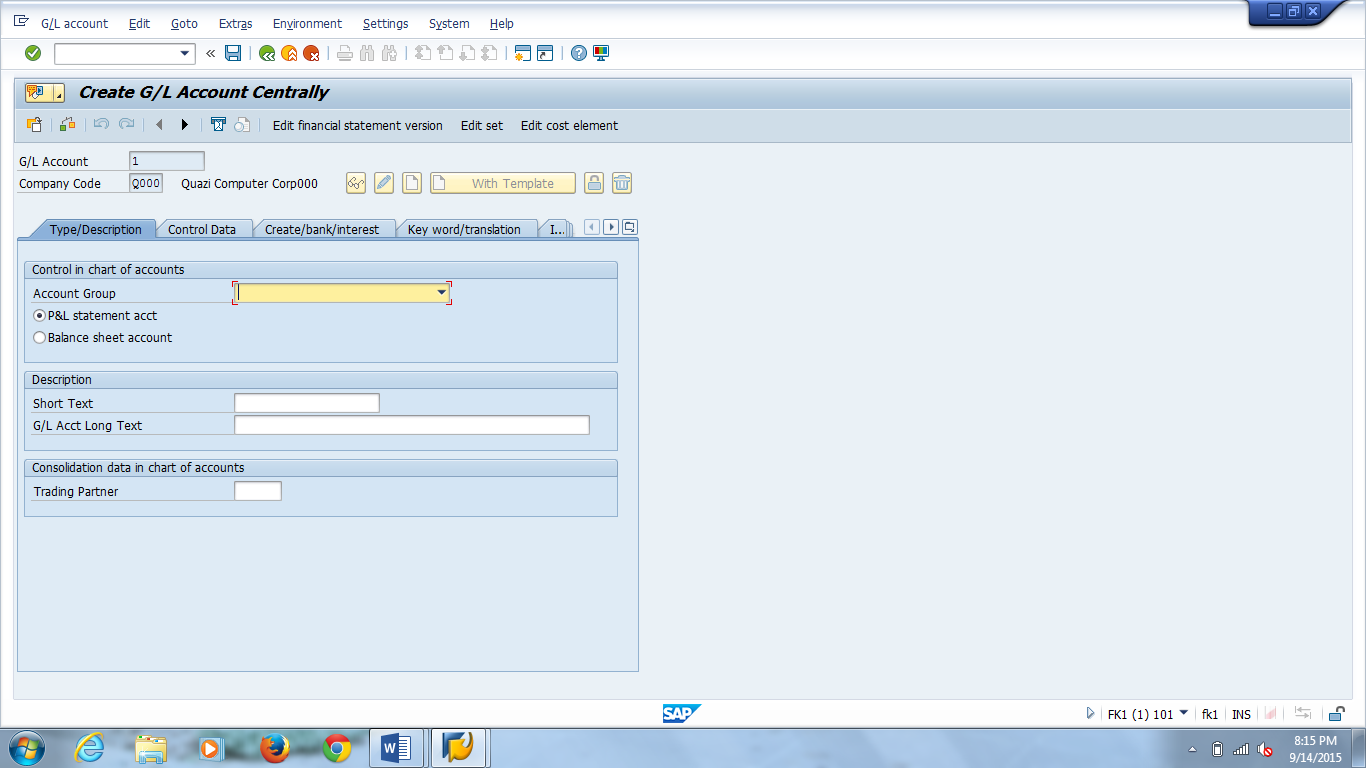 (ENTER)
(ENTER)
City: ______________ (your own creation)
Country: USA Value: ______________
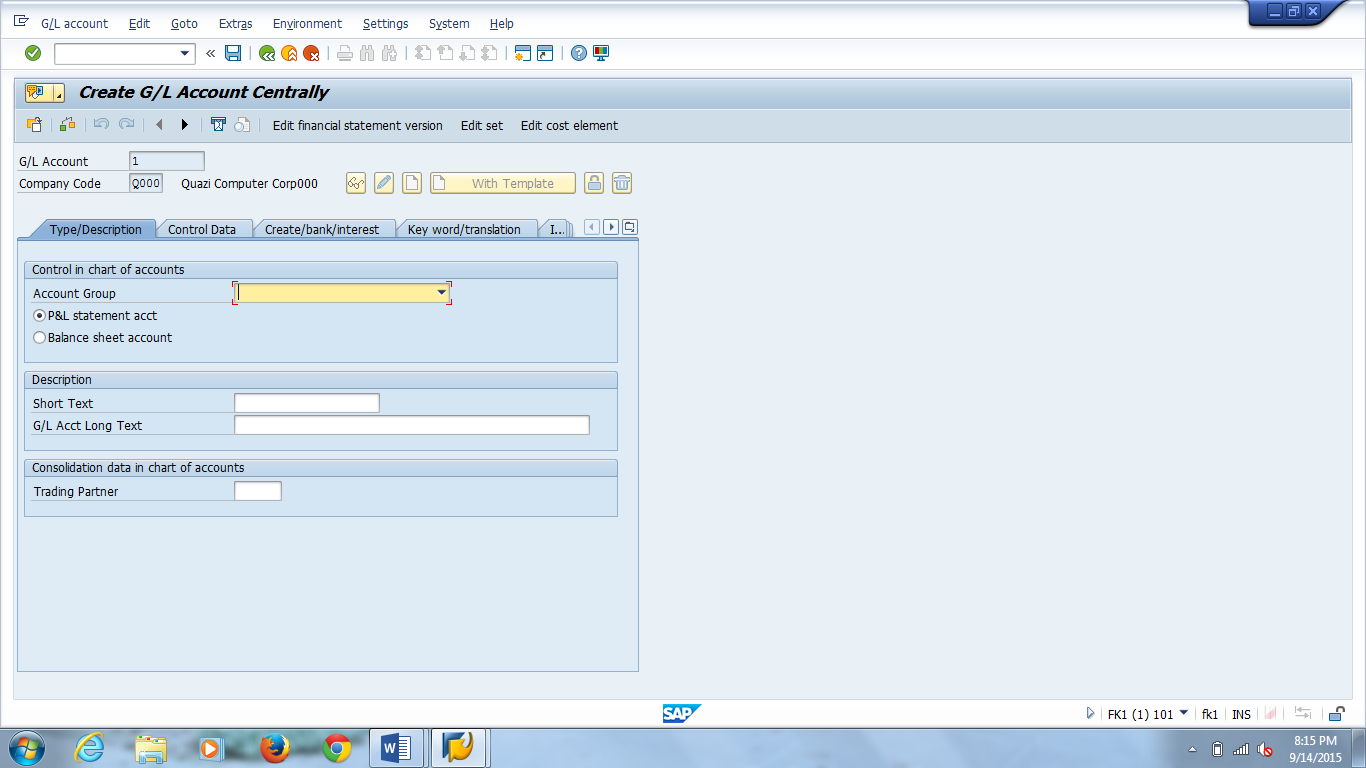 (ENTER)
(ENTER)(SAVE)
Logistics ⇒ Advanced Planning ⇒ Master Data ⇒ Resource ⇒ Processor ⇒ Maintain Business Partner
If your Business Partner from MM02 is not showing, click on and input your Business Partner number recorded in MM02
Reconciliation acct: Your Accounts Payable Recon. Account Value: ______________
Vendor: Payment Transactions TAB:
Exercise MM04: Create business partner Master – vendor Purchasing Role
In this exercise you create purchasing views for the previously created business partner of type vendor.
Select
Purchasing Data TAB:
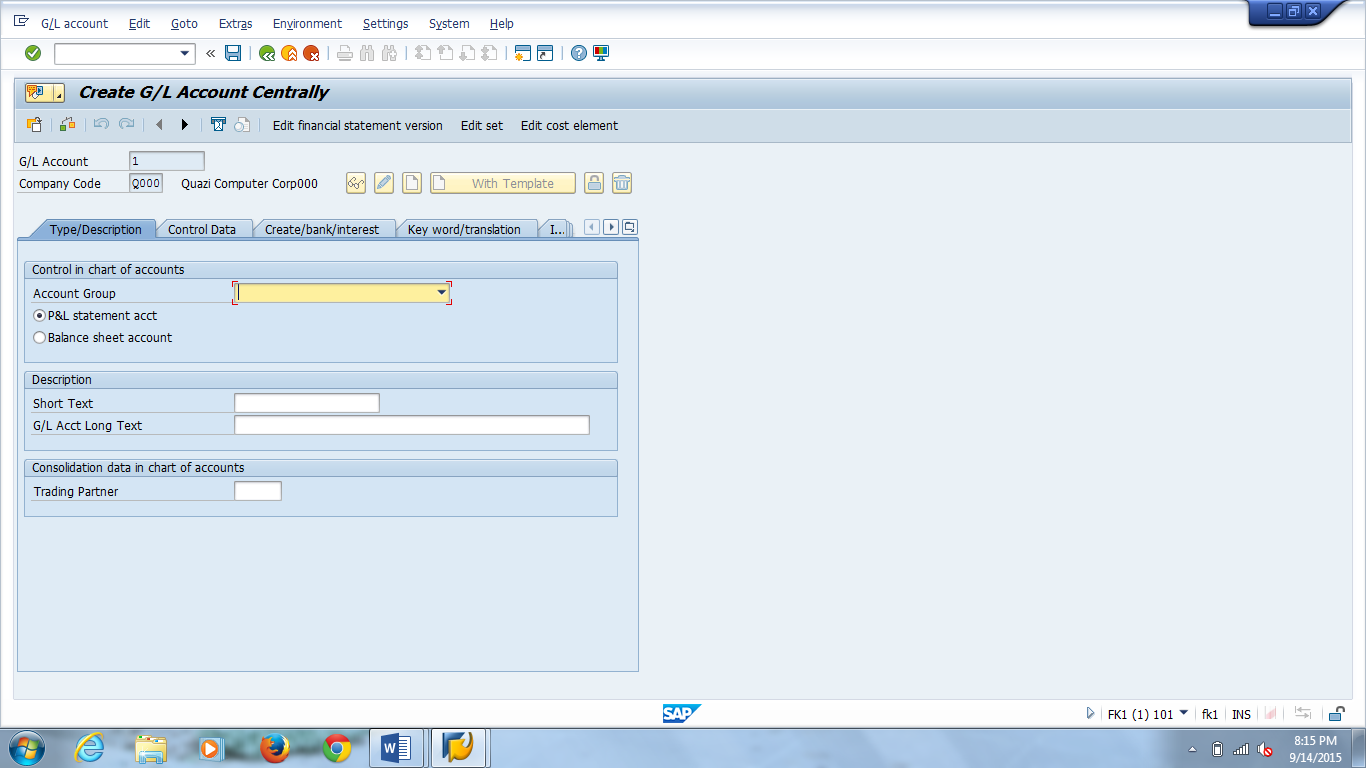 Back to SAP Easy Access
Menu
Back to SAP Easy Access
Menu

Material: Wood Kit_ _ _
Industry sector: Retail
Purchasing
General Plant Data / Storage 1
Defaults⇒ Organizational Levels
Enter Plant C_ _ _ in both the Plant field and the “Copy from” field.
Make sure Wood Kit_ _ _ is entered in the Material field (step 1 of this exercise)
Press the button to bring up the Basic Data 1 view
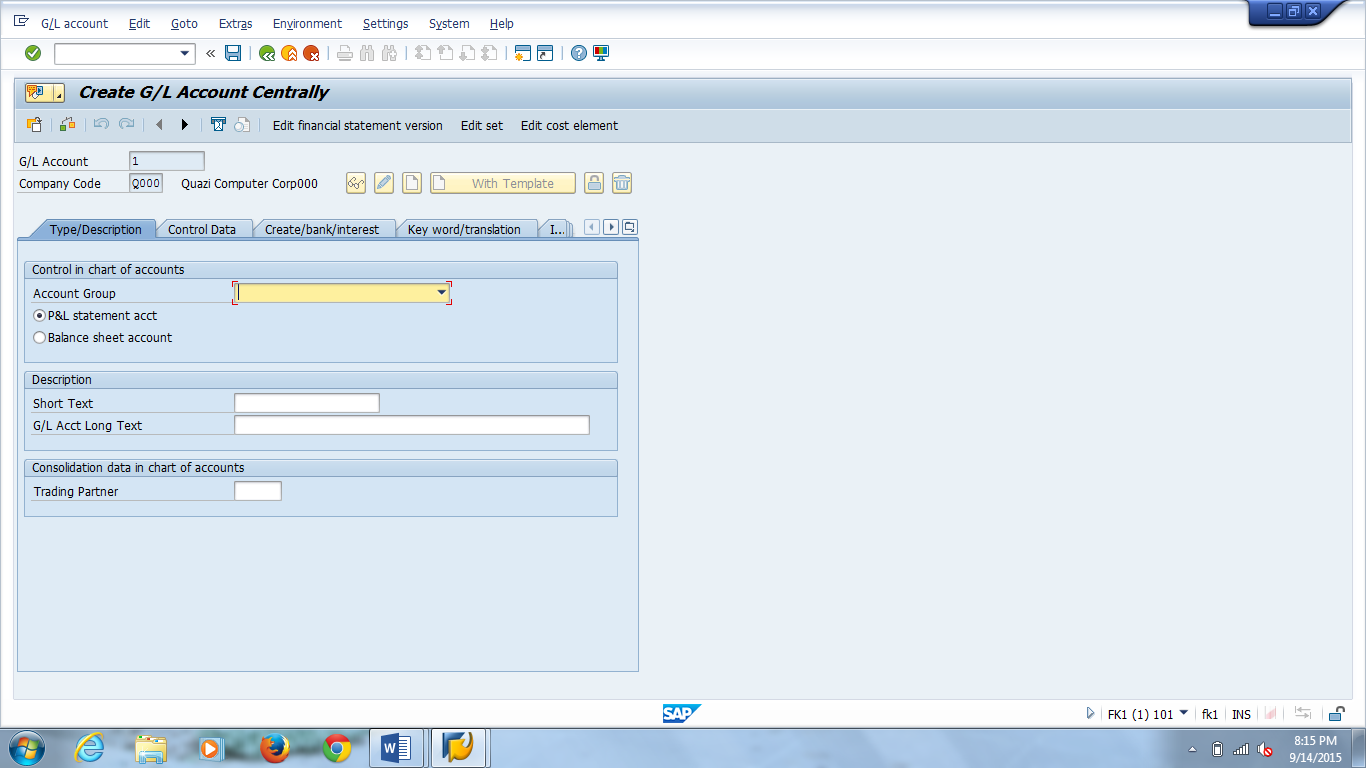 (ENTER) to bypass the
General Plant Data / Storage 1 view (no entries
required)
(ENTER) to bypass the
General Plant Data / Storage 1 view (no entries
required)Insert information below for the material in the Accounting 1 view
| TABs => | Basic Data 1 | Purchasing | Accounting 1 | Costing 1 | |||||||
|---|---|---|---|---|---|---|---|---|---|---|---|
|
|
|
|
|
|
||||||
| Wood Kit_ _ _ | Wood Kit_ _ _ | each | Raw & Op Supp | 25 | 25 | Pound | CPG | 3000 | $35.00 | ||
read entire exercise before starting your input
Logistics ⇒ Materials Management ⇒ Material Master ⇒ Material ⇒ Create (Special) ⇒ Trading Goods
Defaults⇒ Views
Select ONLY the following views: Basic Data 1
Select Create views selected ()
(ENTER)
Continued on next page
The following steps refer to data from the table shown after the last step
Insert information in the table for the material in the Purchasing view
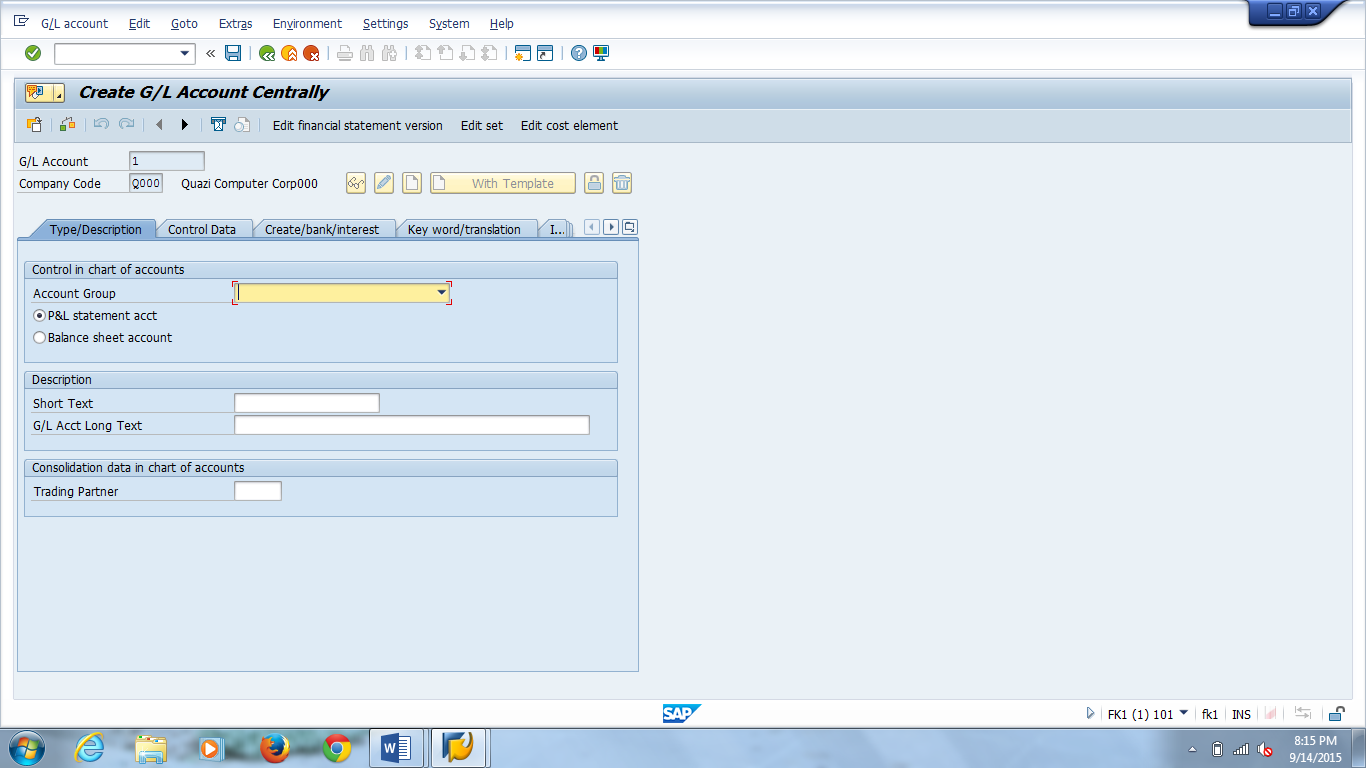 (ENTER)
(ENTER)
Insert information below for the material in the Costing 1 view
(SAVE) [You will be taken to the Create Trading Goods Initial Screen]
Exercise MM07: Create Material Master for Finished PRoducts
This exercise creates the finished products master record. Each view created contains relevant data for employees performing certain duties within an organization. As a reminder, finished products are produced (in the production cycle) through the purchase and use of raw materials and trade goods.
Industry sector: Retail
Defaults⇒ Views
NOTE: If the Organizational levels screen appears, press to bypass
Continued on next page
| TABs => | Basic Data 1 | Accounting 1 | Costing 1 | |||||||
|---|---|---|---|---|---|---|---|---|---|---|
|
|
|
|
|||||||
| Rocker_ _ _ | Rocker_ _ _ | each | Trading & Finished | 30 | 30 | Pound | 7920 | $50.00 | ||
Click
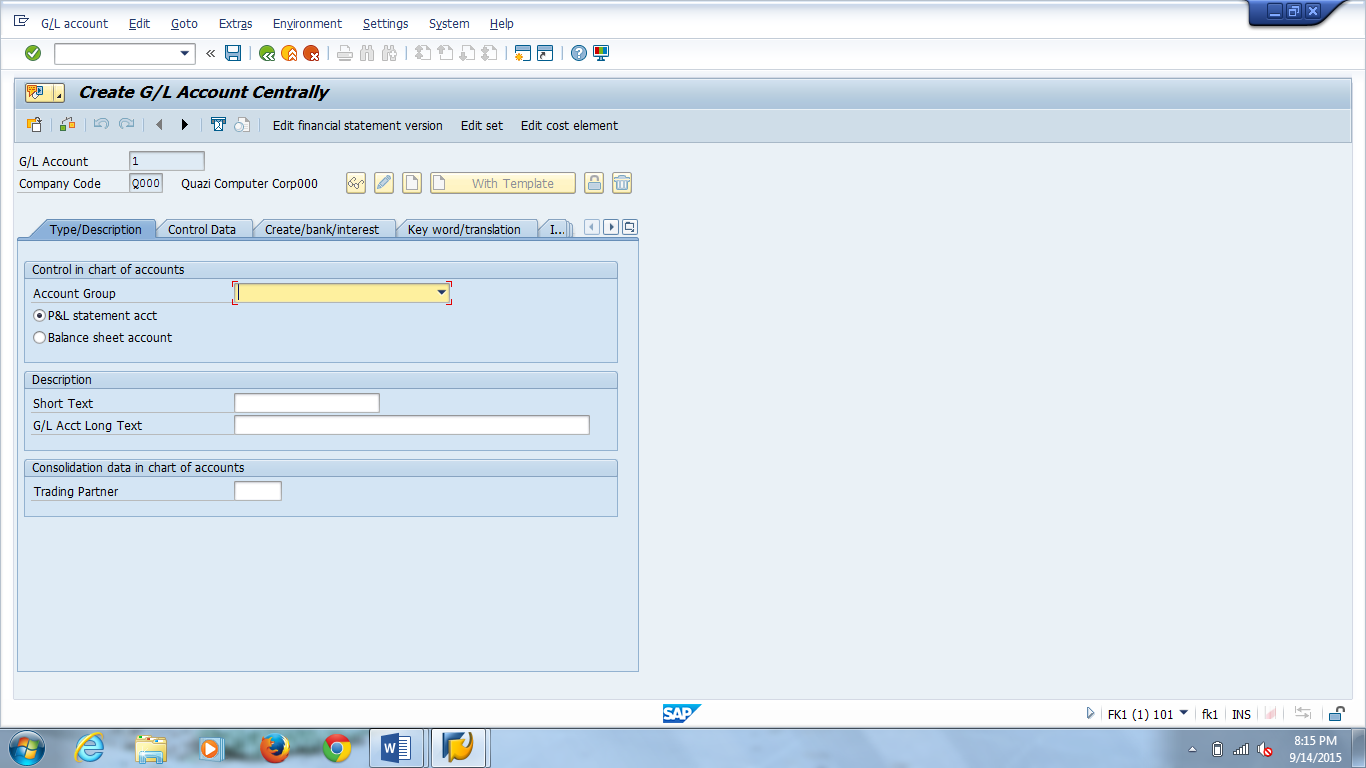 (ENTER) to bypass any
message about “Local currency converted to other currencies using
current exchange rate”.
(ENTER) to bypass any
message about “Local currency converted to other currencies using
current exchange rate”.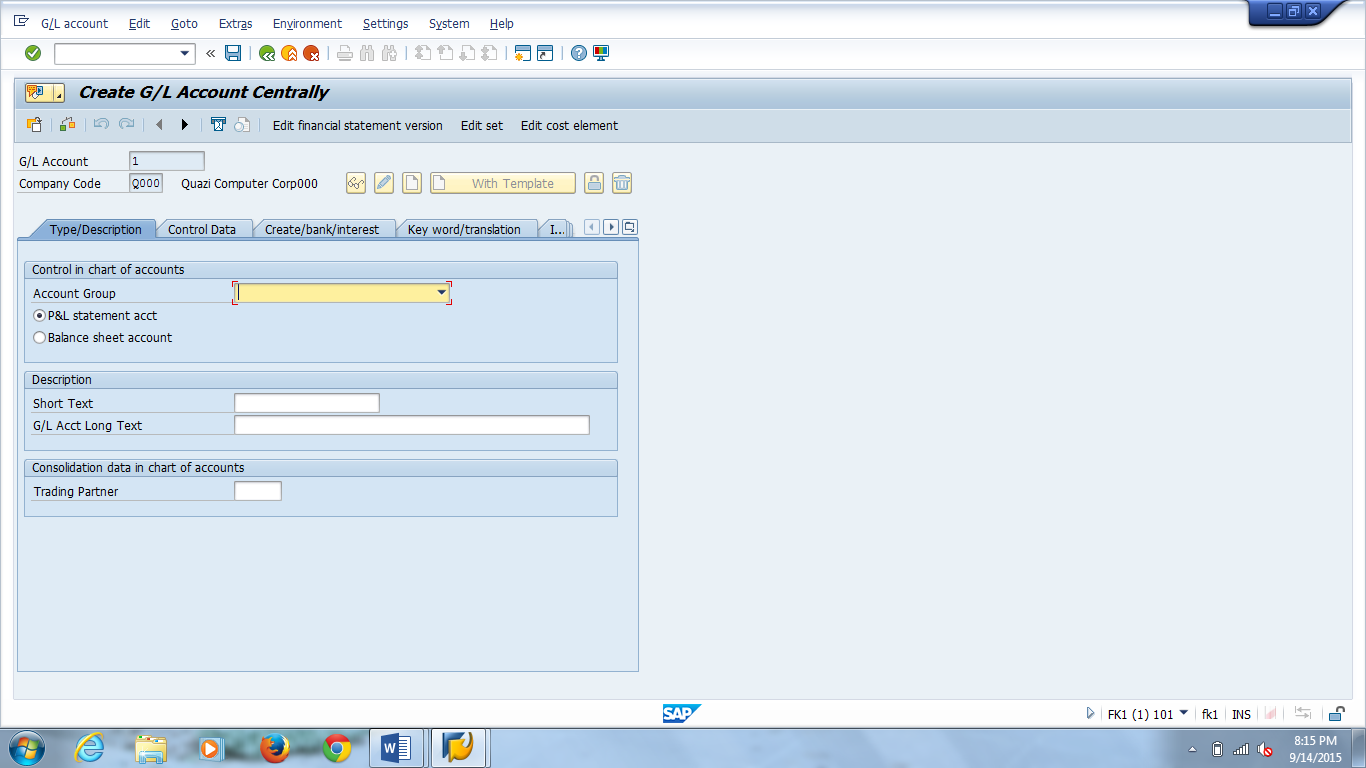 Back to SAP Easy Access
Menu
Back to SAP Easy Access
Menu
Vendor: Happy Bottoms_ _ _ Value: ______________
Material: Material name from table below (use lookup button to find)
Select then input data for that material from table below
NOTE: After entering and saving the data for the first material, you will be returned to the Create Info Record Initial Screen where you input the second material name for step 2 above and related data for this step.
Create a request for an initial supply of stock items.
Logistics ⇒ Materials Management ⇒ Purchasing ⇒ Purchase Requisition ⇒ Create
| Material | Quantity | Delivery Date | Stor. Loc. |
| Cushion_ _ _ | 1000 | (Future date, such as a week from today) | Shipping |
| Wood Kit_ _ _ | 1000 | (Future date, such as a week from today) | Warehouse |
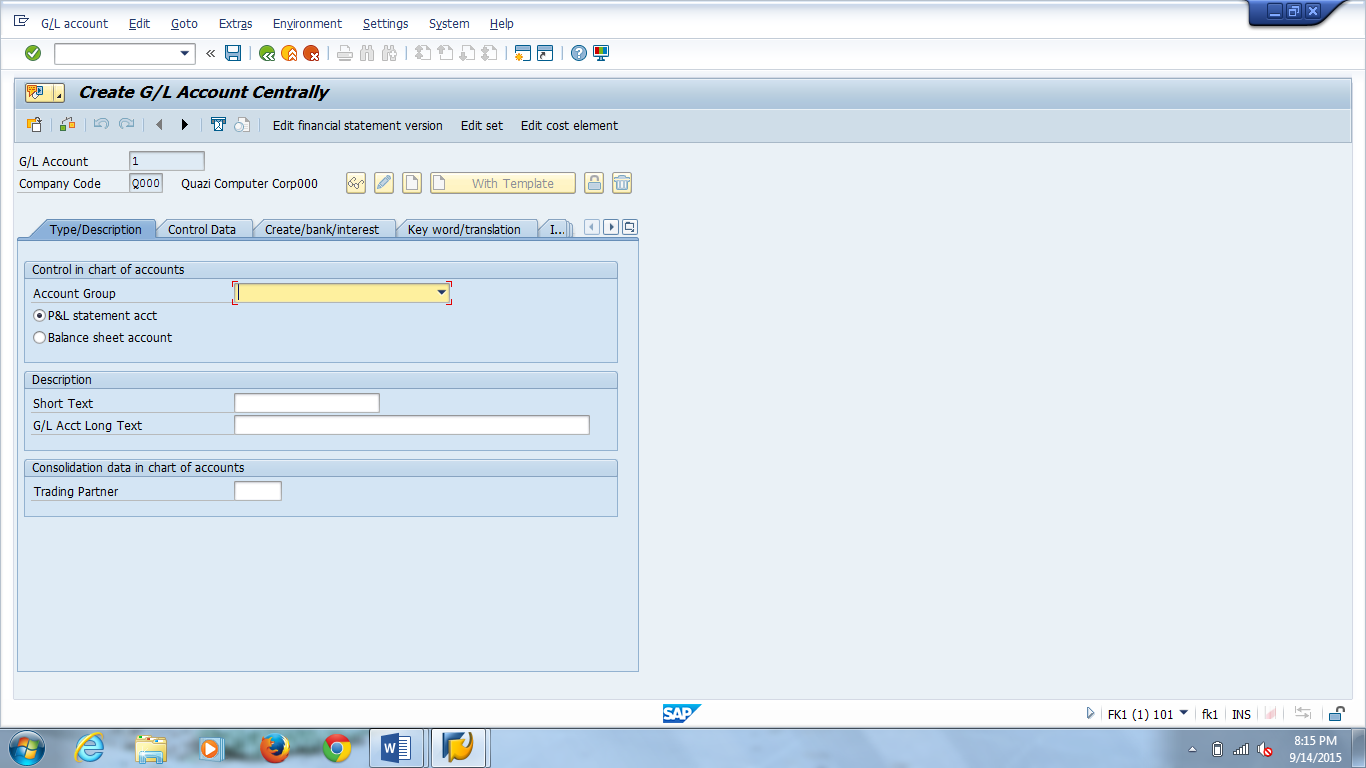 (ENTER)
(ENTER)
Review the information pulled from the Master Data. If receiving a message at the bottom of the screen as to whether the delivery date can be met, ignore it and proceed with the exercise.
Record the new purchase requisition number ____________________
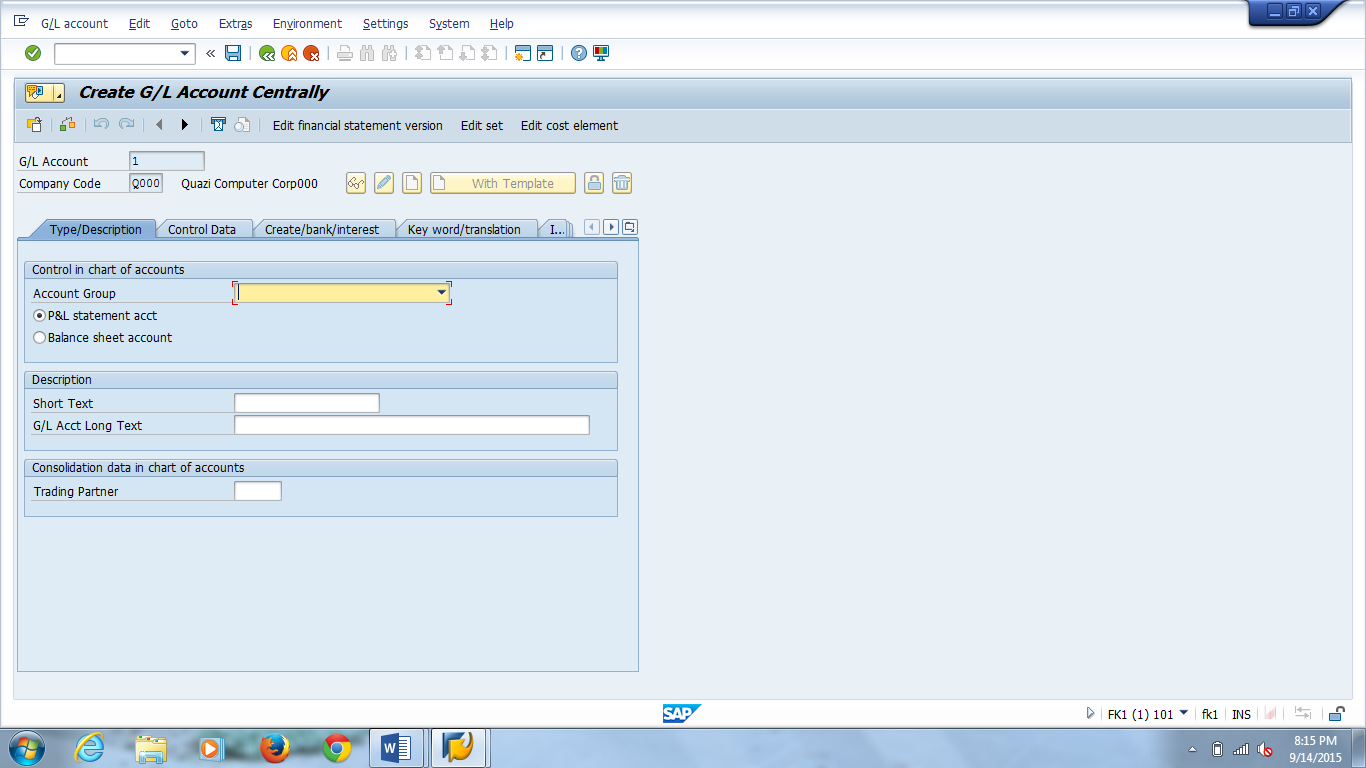 Back to SAP Easy Access
Menu
Back to SAP Easy Access
Menu
Create PO with Source Determination
Order Type: Standard PO Value: ______________
Click on the green select all
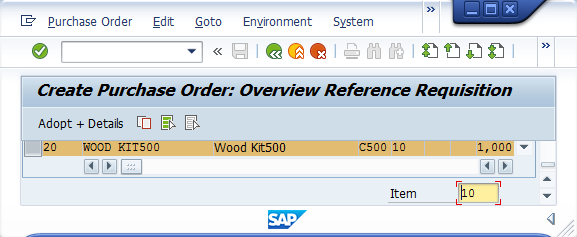 button
buttonClick on the
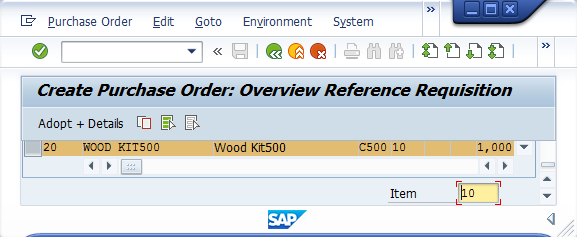 button to copy the details
from the purchase requisition into your new purchase order
button to copy the details
from the purchase requisition into your new purchase orderIf a warning about existing sources will be lost appears, click on (ENTER)
Click on the green select all
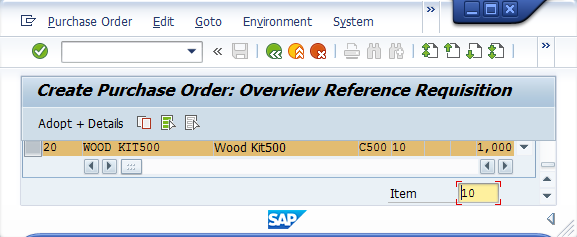 button
button
Record the order Net value ________________________
(SAVE)

EXERCISE MM11: Create a Goods Receipt
Select Propose All Items
Click to accept these values
Select or (SAVE)
Record the material document number_______________________
From the next drop-down menu to the right, select Material Document
Continued on next page
Click

Double-click
 . The resulting screen shows the
accounting document view of the transaction just recorded. Note the
positive entries (debits) to inventory accounts and similar negative
entries (credits) to account 31000000 – GR/IR-000. The total of the
debits (credits) should equal the amount entered for step 14 of MM10.
Compare and make sure they agree.
. The resulting screen shows the
accounting document view of the transaction just recorded. Note the
positive entries (debits) to inventory accounts and similar negative
entries (credits) to account 31000000 – GR/IR-000. The total of the
debits (credits) should equal the amount entered for step 14 of MM10.
Compare and make sure they agree.
In Exercise MM12, you will record the actual vendor invoice for the goods received, reclassifying the liability from this temporary account into your accounts payable reconciliation account.
Continued on next page
Click
back,
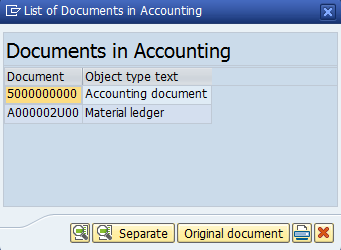 close
pop-up screen, back to SAP Easy Access
Menu
close
pop-up screen, back to SAP Easy Access
Menu
Logistics ⇒ Materials Management ⇒ Logistics Invoice Verification ⇒ Document Entry ⇒ Enter Invoice
Invoice date: Today's date
Note that the Company Code is C_ _ _
PO number: Your purchase order number from exercise MM10
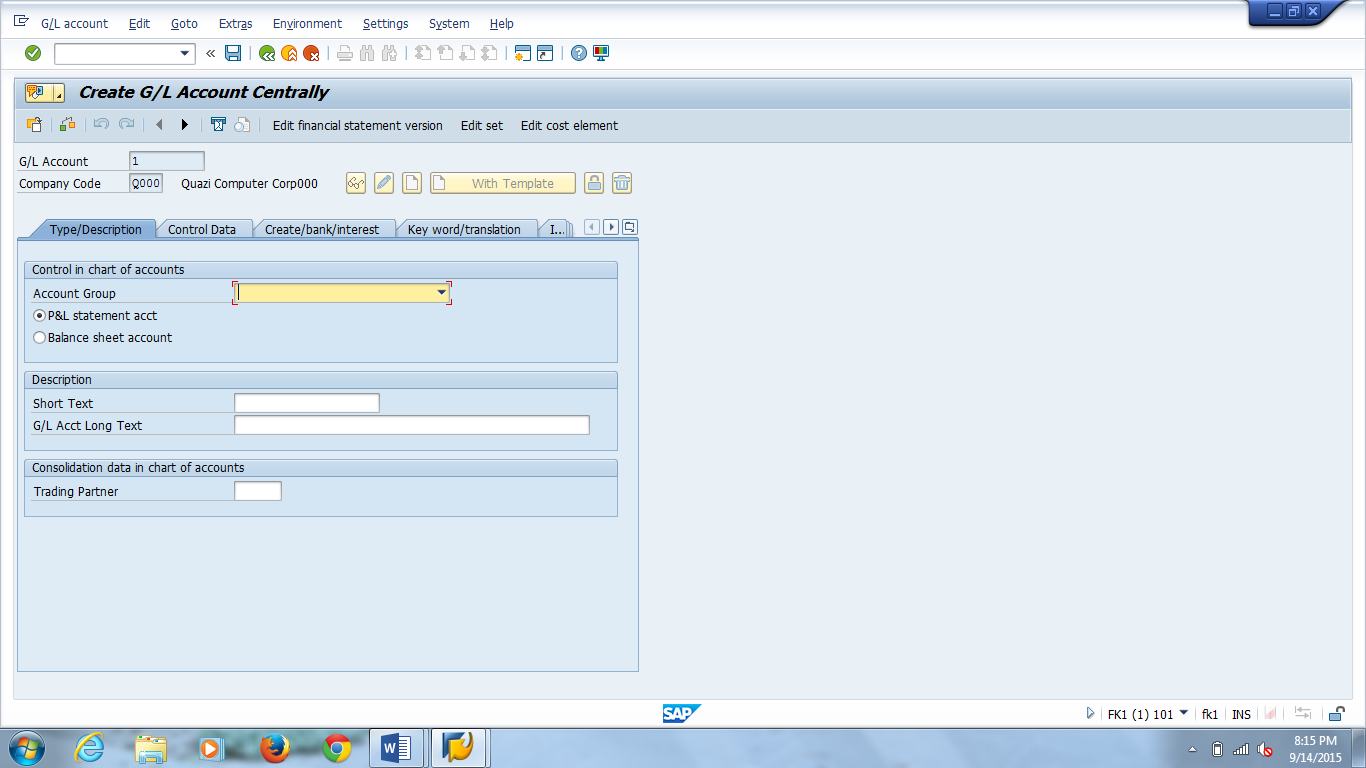 (ENTER)
(ENTER)
Continued on next page
PRINT THE SCREEN (IF REQUIRED BY YOUR INSTRUCTOR)
Continued on next page
Make the following selections:
Accounting ⇒ Financial Accounting ⇒ General Ledger ⇒ Account ⇒ Display Balances
Continued on next page
The resulting pop-up screen provides detail about this part of the entry made by you. Scroll to the bottom of the pop-up screen. Note your user name as the one who recorded the entry. Again, SAP provides an excellent audit trail for this transaction processed.
Chapter 3: Production Logistics (PP)

Exercise PP01: Create MRP Views for Raw Materials
Select Create views selected ()
(ENTER)
MRP1 view:
MRP Type: MRP Value: ______________
Planned Deliv. Time: 1
SchedMargin key: 001
(SAVE)
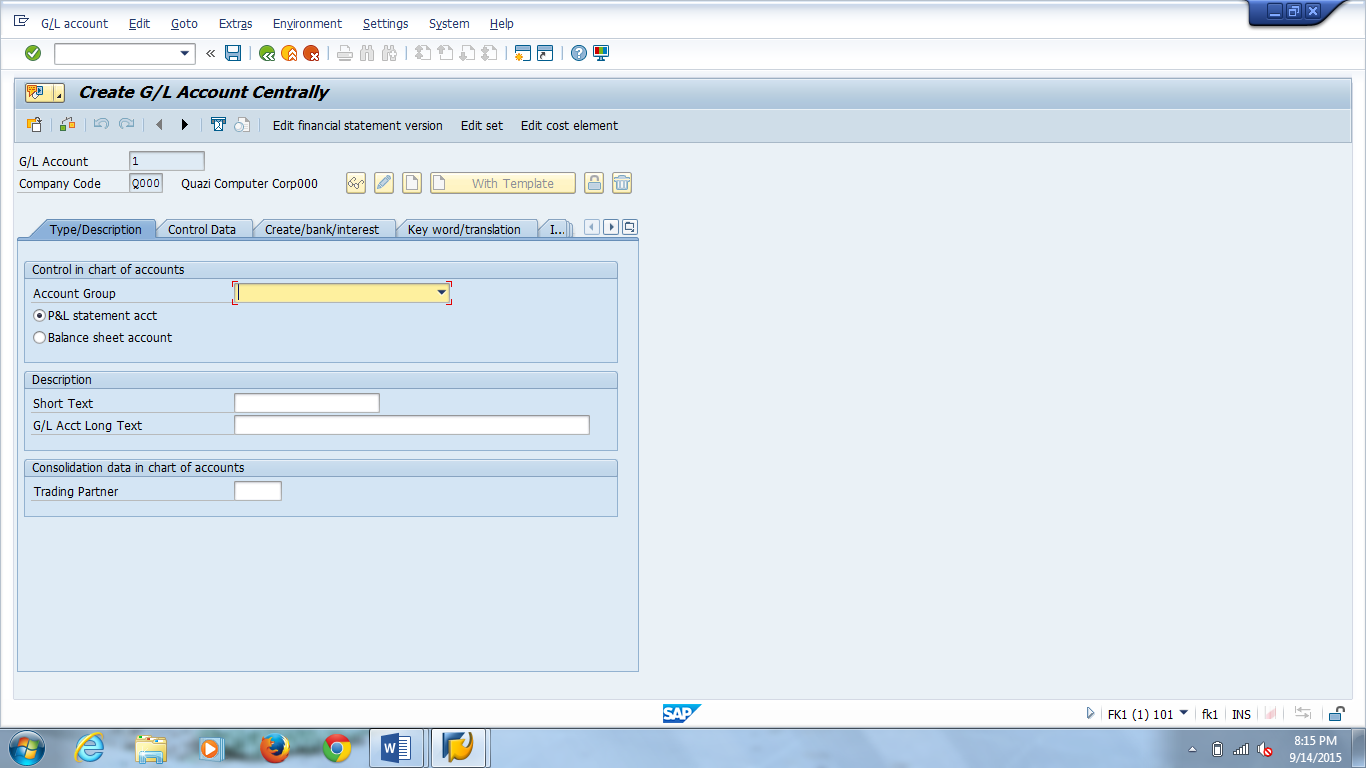 Back to SAP Easy Access
Menu
Back to SAP Easy Access
Menu
Defaults⇒ Views
Select the following views: MRP 1, 2, 3
If requested, enter manufacturing plant (Classic Rockers Manufacture Pt) but leave the StLoc blank.
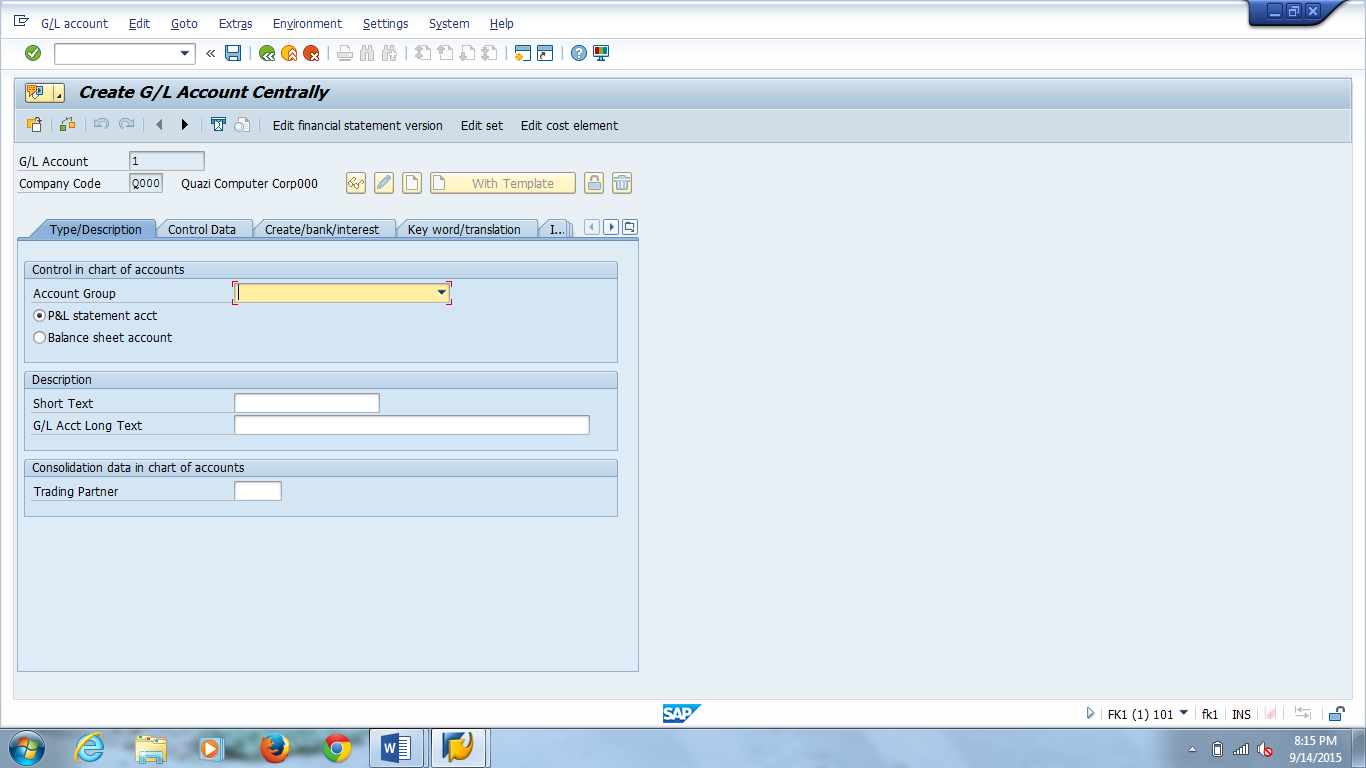 (ENTER)
(ENTER)
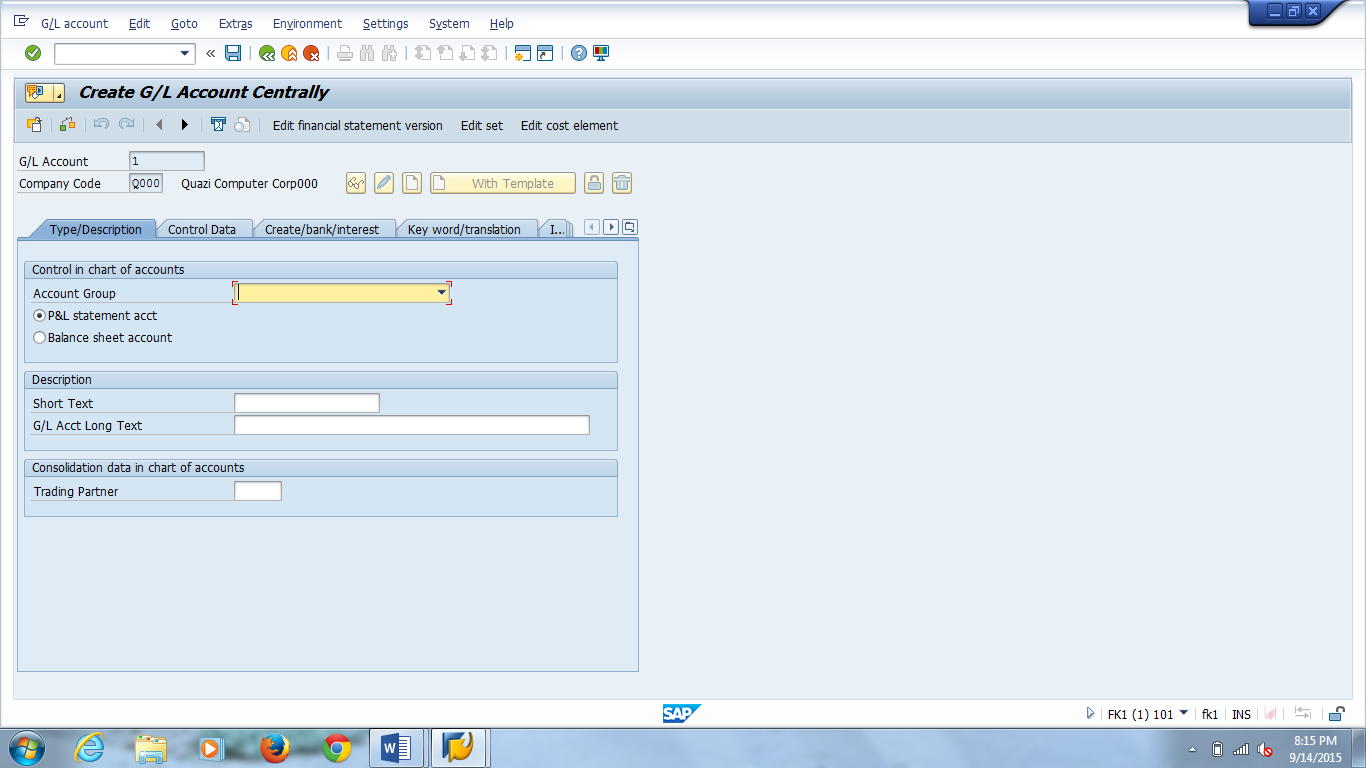 (ENTER)
(ENTER)
MRP2 view:
MRP3 view:
Availability check: Individ.requirements Value: ______________
Expand the finished products created in MM to include specific views of information required for materials requirement planning for production.
Logistics ⇒ Production ⇒ Master Data ⇒ Material Master ⇒ Material ⇒ Create (Special) ⇒ Finished Product
Lookup and select your rocker material that was created in MM
Press the button to bring up the MRP 1 view (if you get a message telling you the material exists and will be extended, click to the left of the message, then close the resulting pop-up box)
MRP Controller: CR MRP Controller Value: ______________
Lot Sizing Procedure: Lot-for-lot order quantity Value: ______________
Safety stock: 20
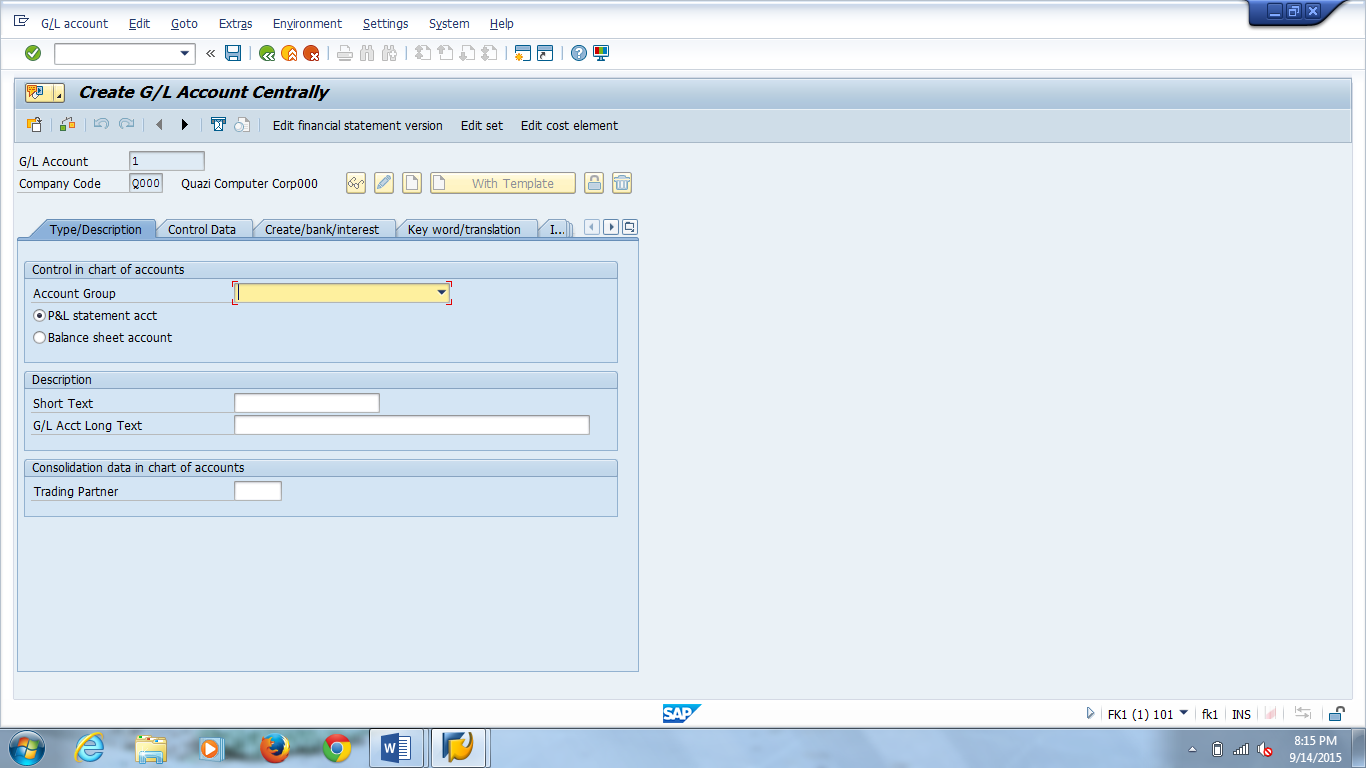 (ENTER)
(ENTER)
Continued on next page
Work scheduling view:

EXErcise PP04: Create Bills of Material
BOM Usage: Production Value: ______________
Validity
(SAVE)
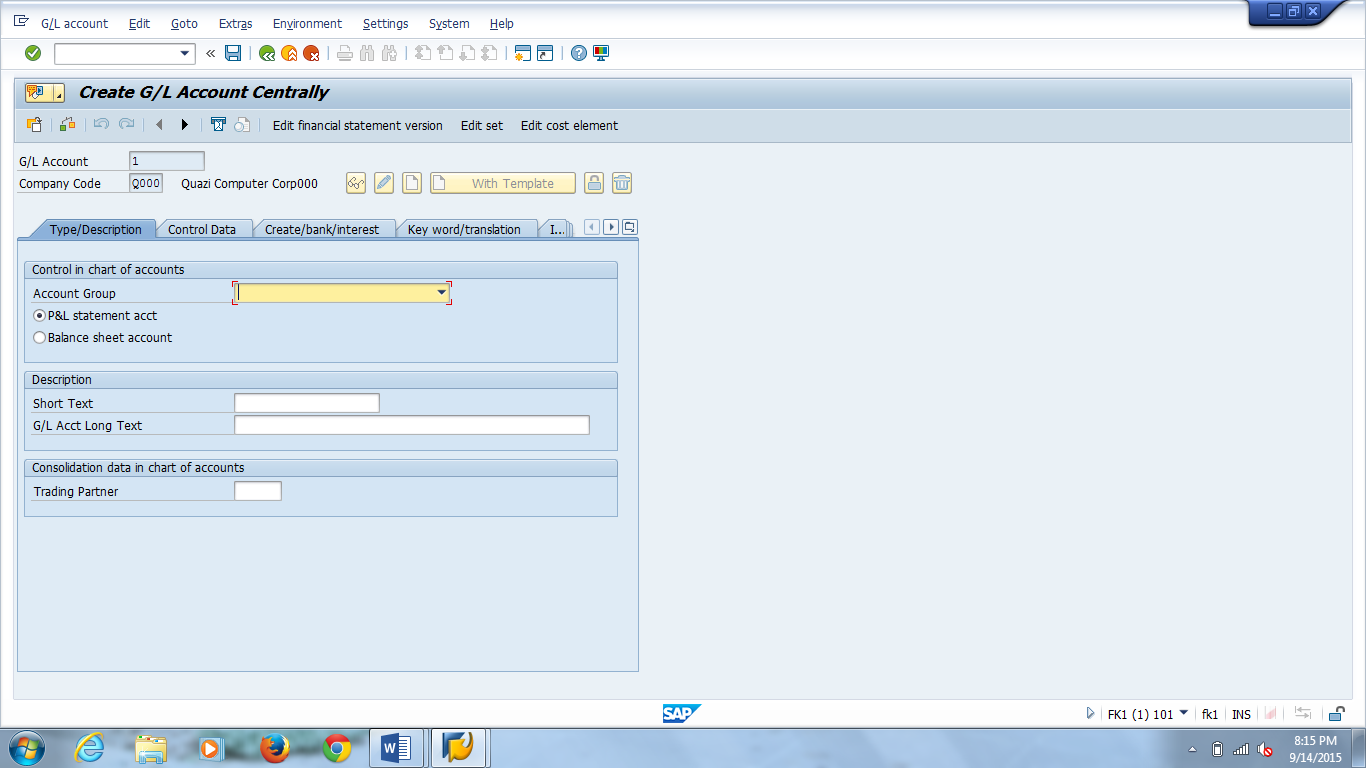 Back to SAP Easy Access
Menu
Back to SAP Easy Access
Menu
Logistics ⇒ Production ⇒ Master Data ⇒ Routings ⇒ Routings ⇒ Standard Routings ⇒ Create
Material: Rocker_ _ _
General data
Usage: Production Value: ______________
| Operat. | Work center* | Control key | Description | Enter | Setup (time in min) | Enter | Labor (time in (min) | Enter |
| 0010 | CRAREA | Routing/Ref. op set – internal proc. | Sand and clean wood | 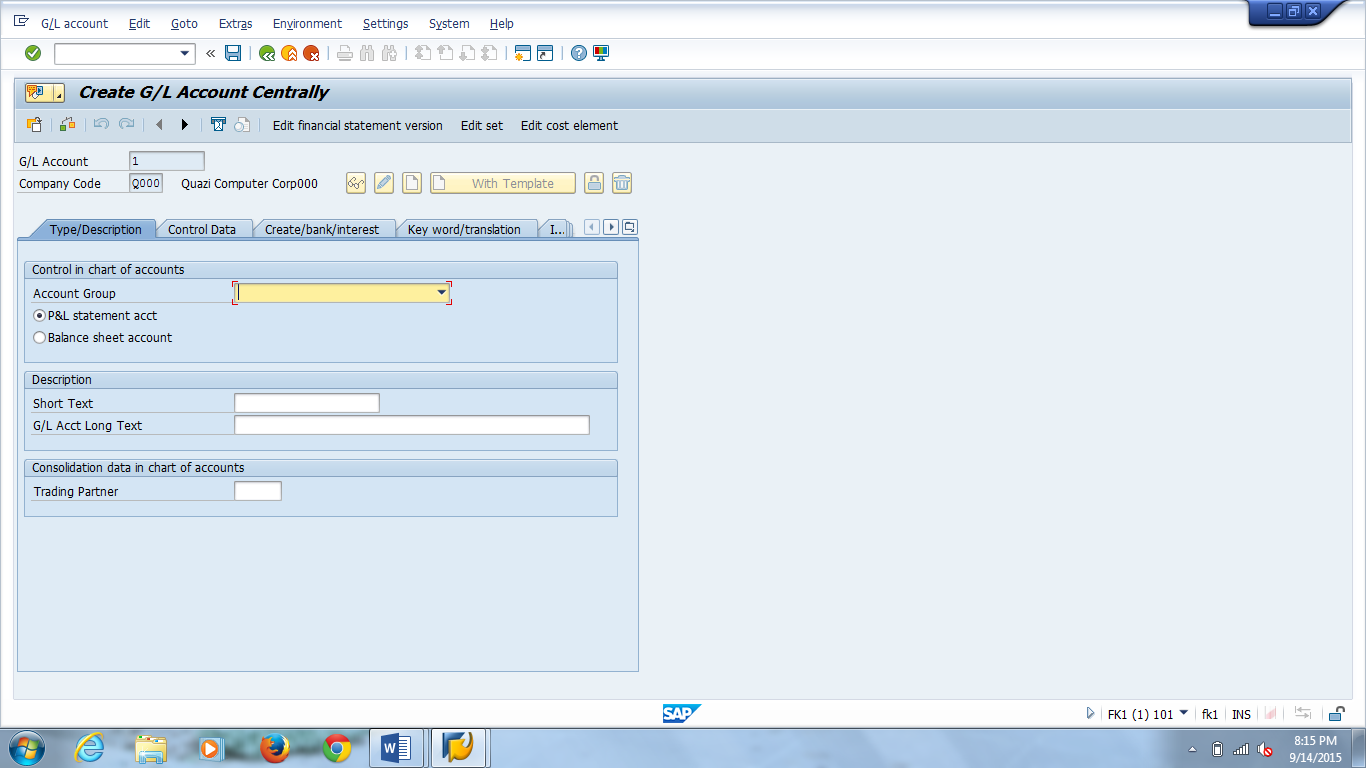 |
5 | 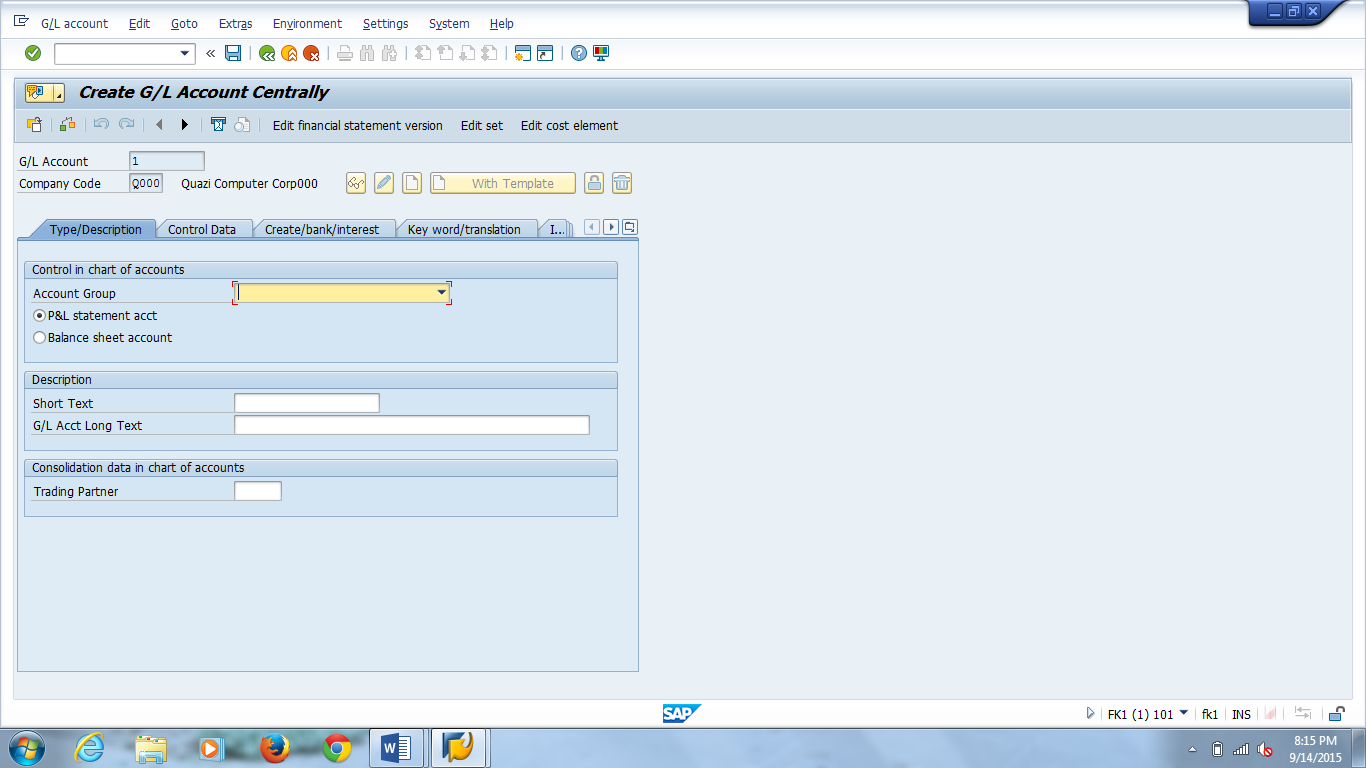 |
60 | 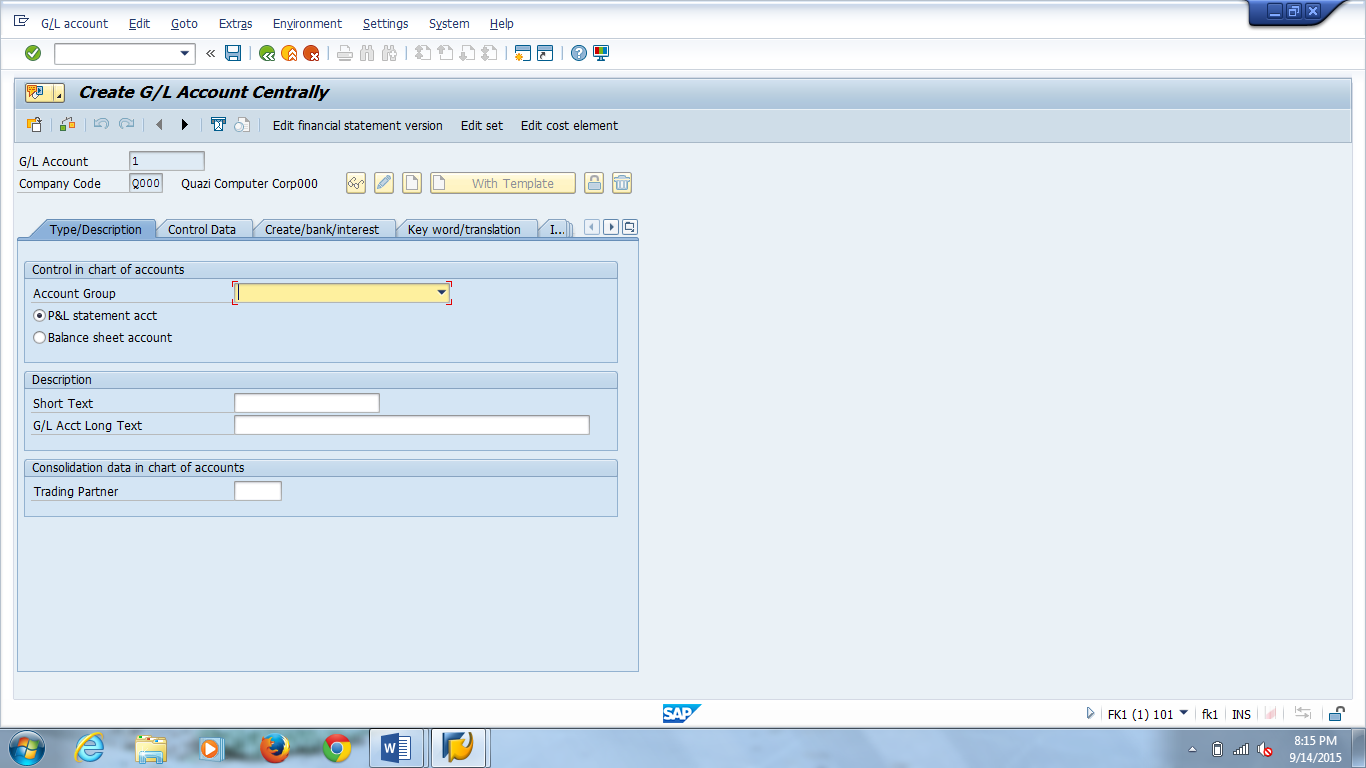 |
| 0020 | CRAREA | Routing/Ref. op set – internal proc. | Glue wood kit together | 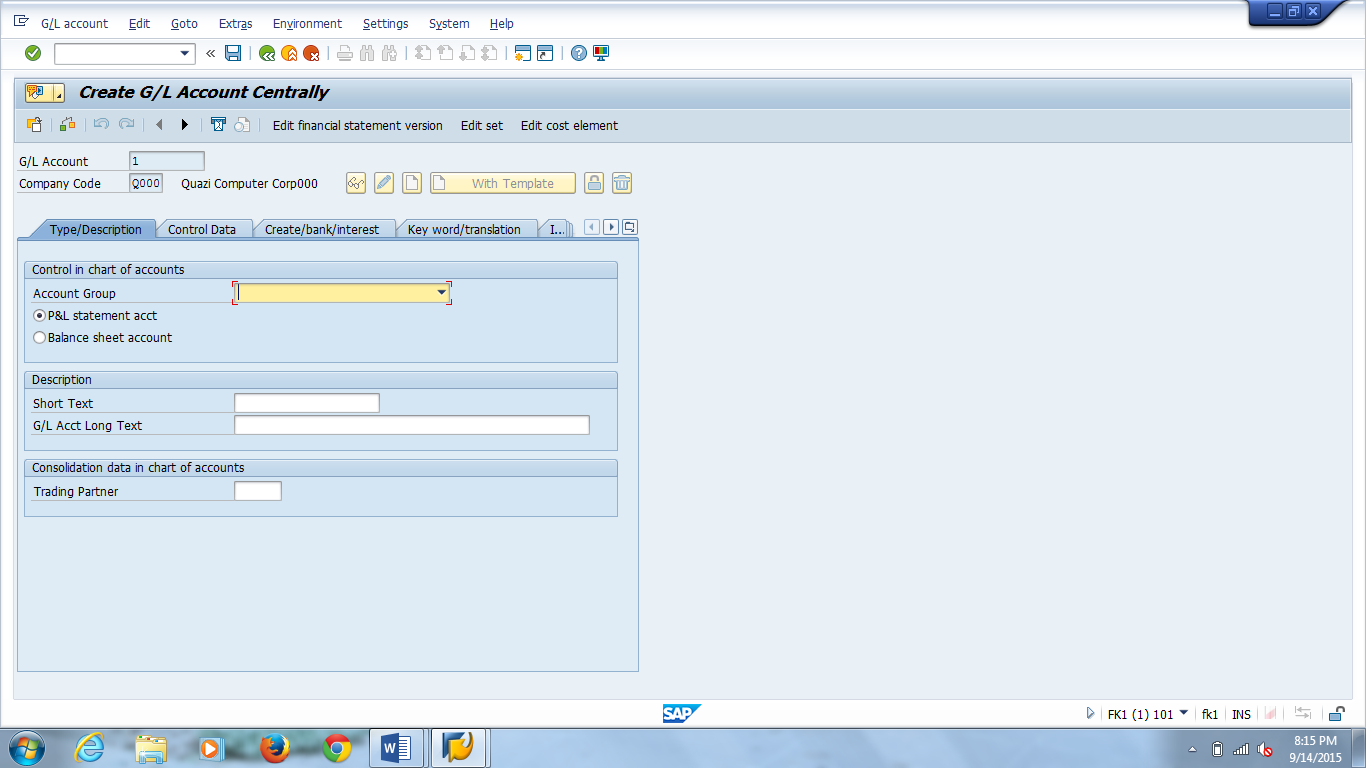 |
5 | 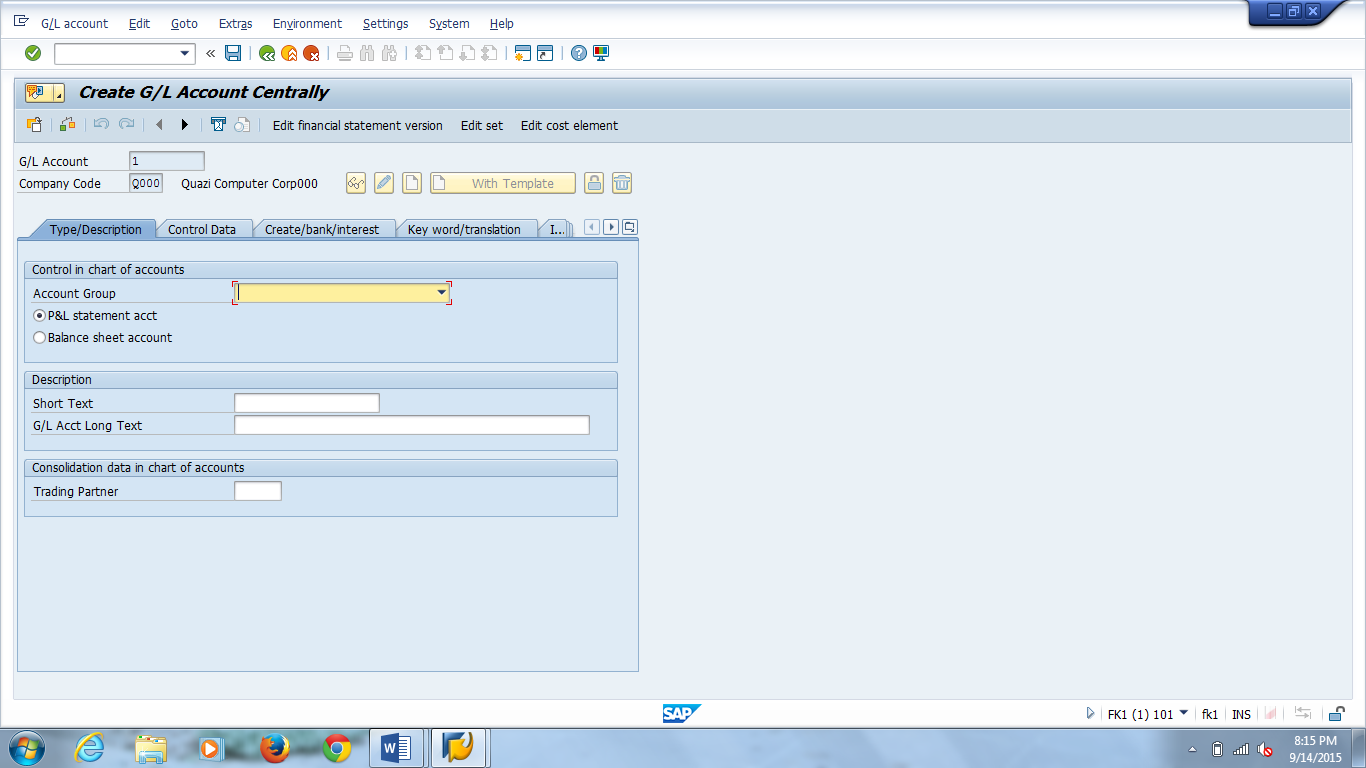 |
60 | 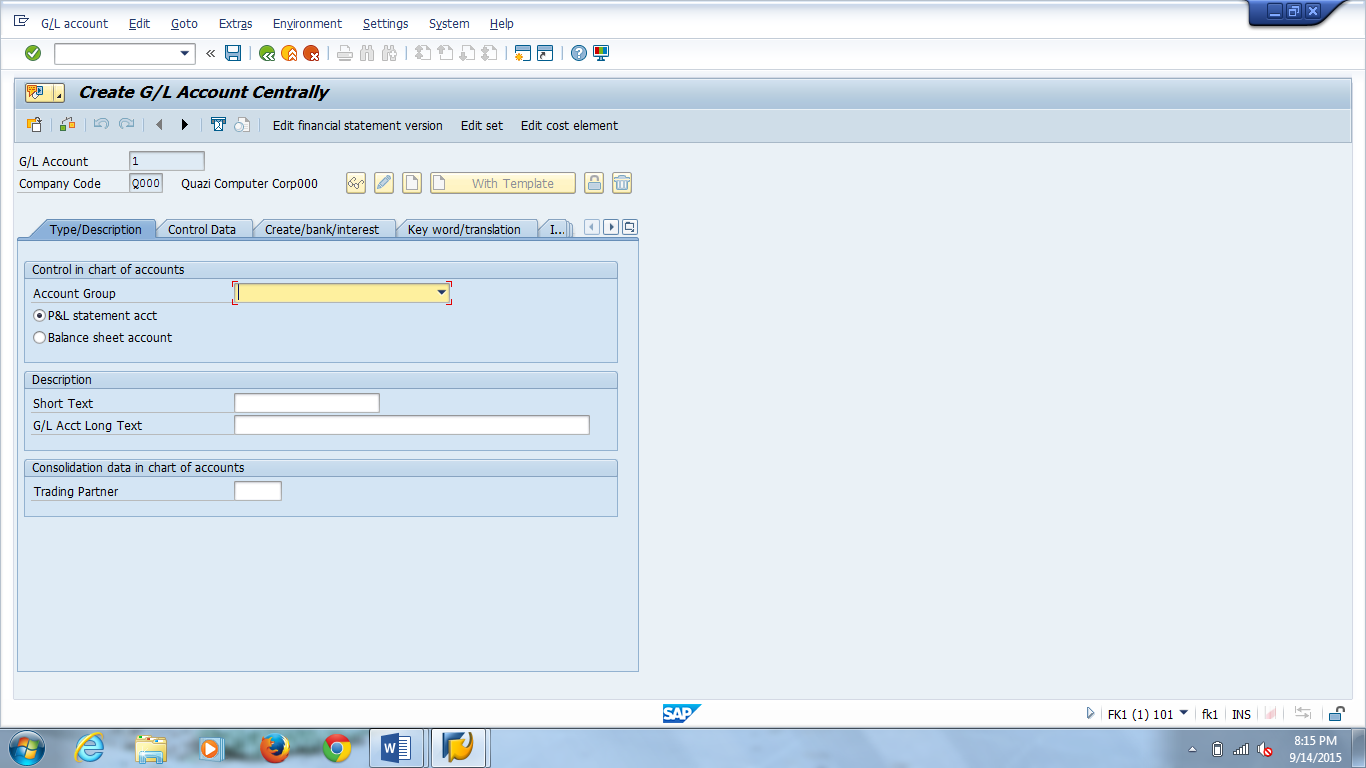 |
| 0030 | CRAREA | Routing/Ref. op set – internal proc. | Attach cushion to frame |  |
5 | 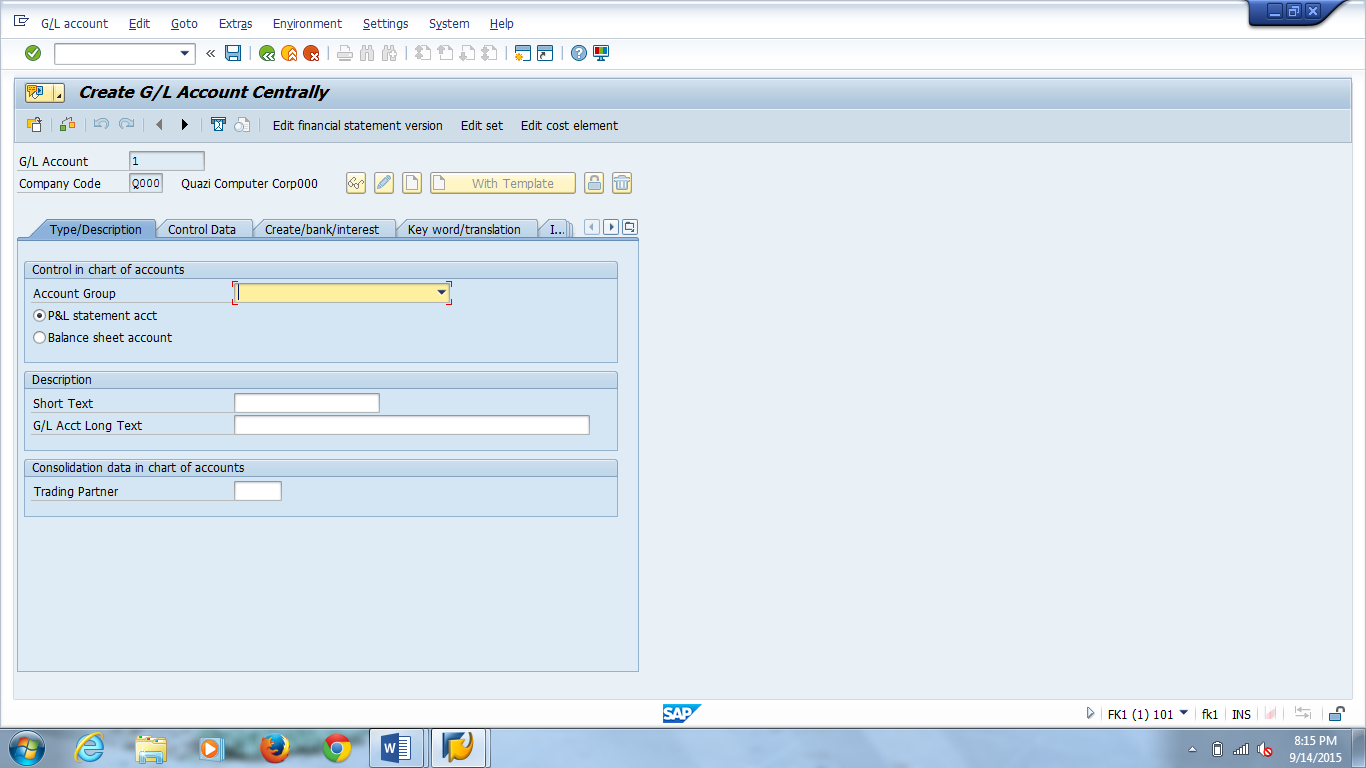 |
10 | 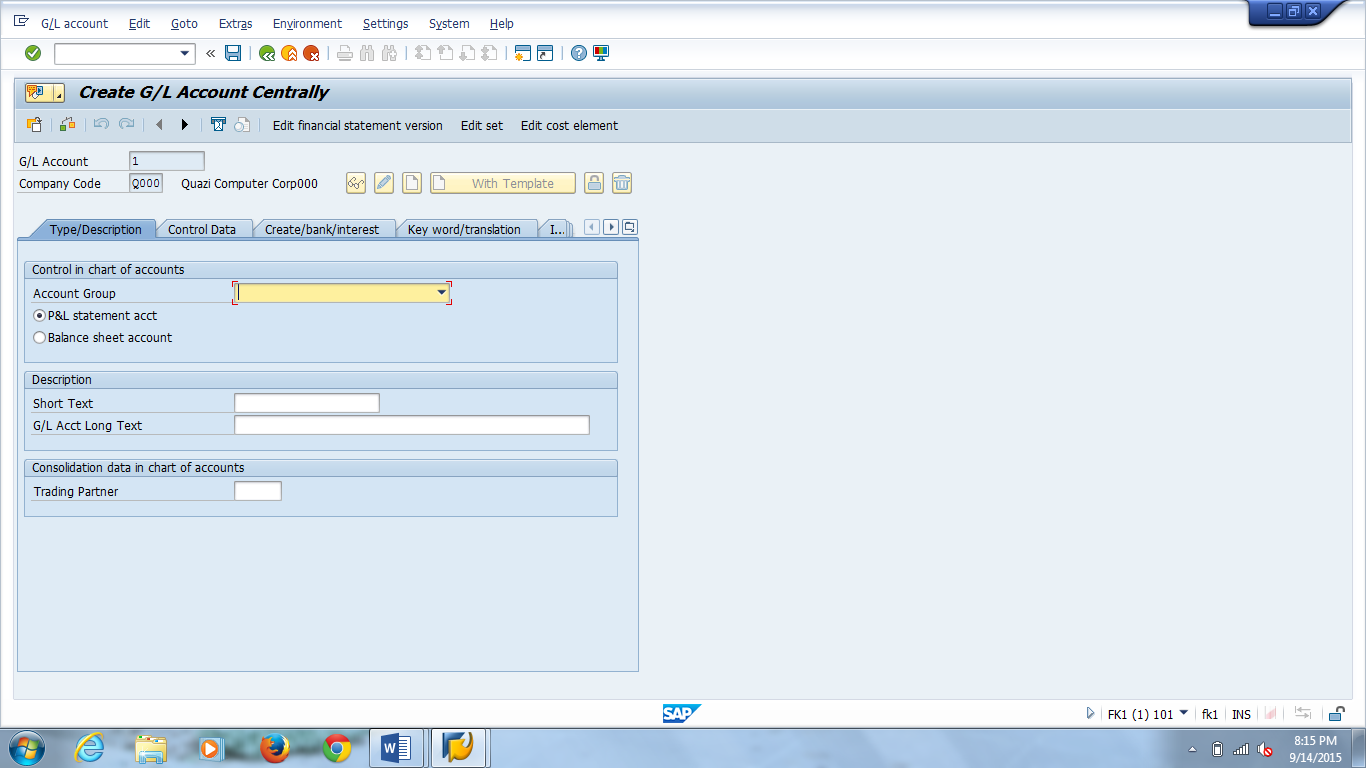 |
*Do not use the lookup button to find this value. Type this value into the respective fields.
Enter Setup and Labor times for each item in table above (click
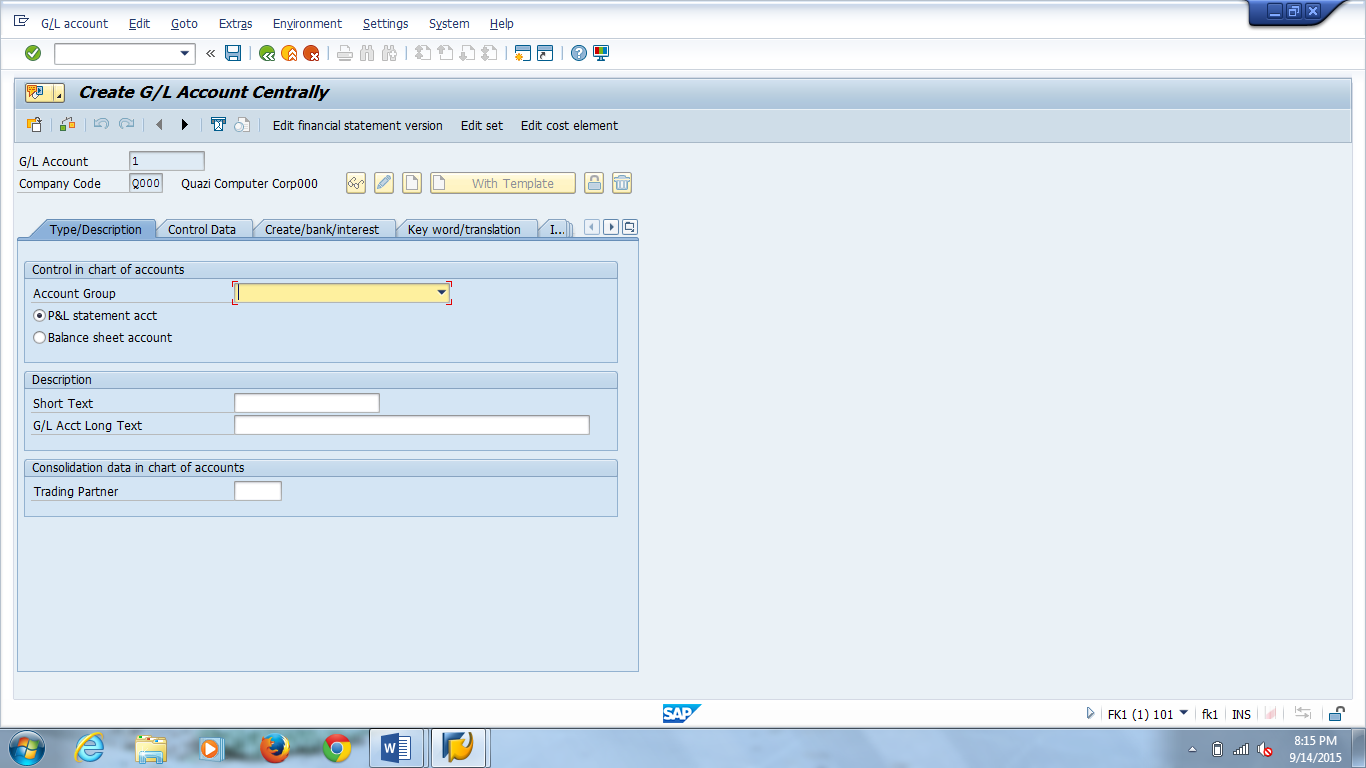 after each entry)
after each entry)
Click on the button
Select the materials required for operation 10: Wood Kit_ _ _
Select the materials required for operation 30: Cushion_ _ _
Select
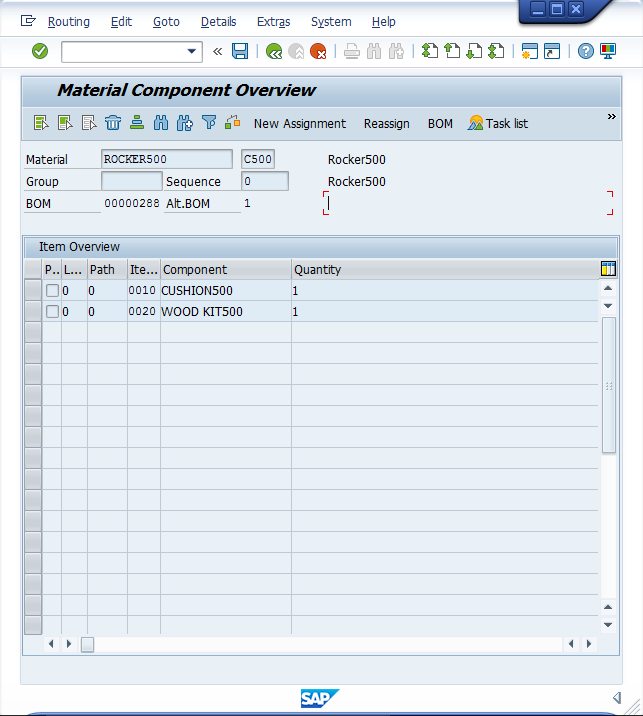

Material: Rocker_ _ _
Plant for Material: C_ _ _
Continued on next page
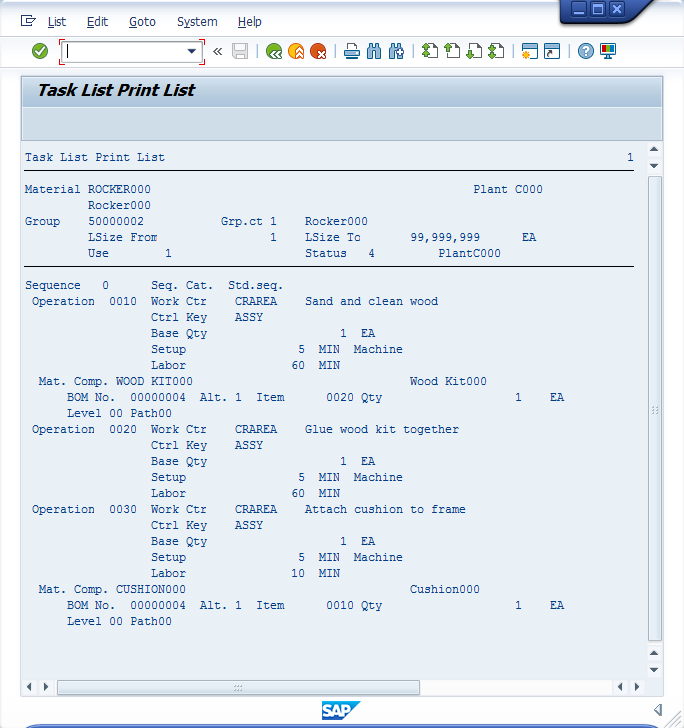
Exercise PP07: Change Work Scheduling View for Finished PRoducts
Create a production version for the finished product which determines which BOM and routing will be used. For one material, you can have several production versions for various validity periods and lot-size ranges.
Select Create views selected ()
(ENTER)
Click to create Production Versions for your rocker
Version: CRPV (enter this value, do not look up)
Basic data
Minimum Lot Size: 1
Group: Lookup your rocker group (should be around 50000000)
Continued on next page
Click to Cancel after reviewing the Production Version Details window.
Click to Continue
(SAVE)
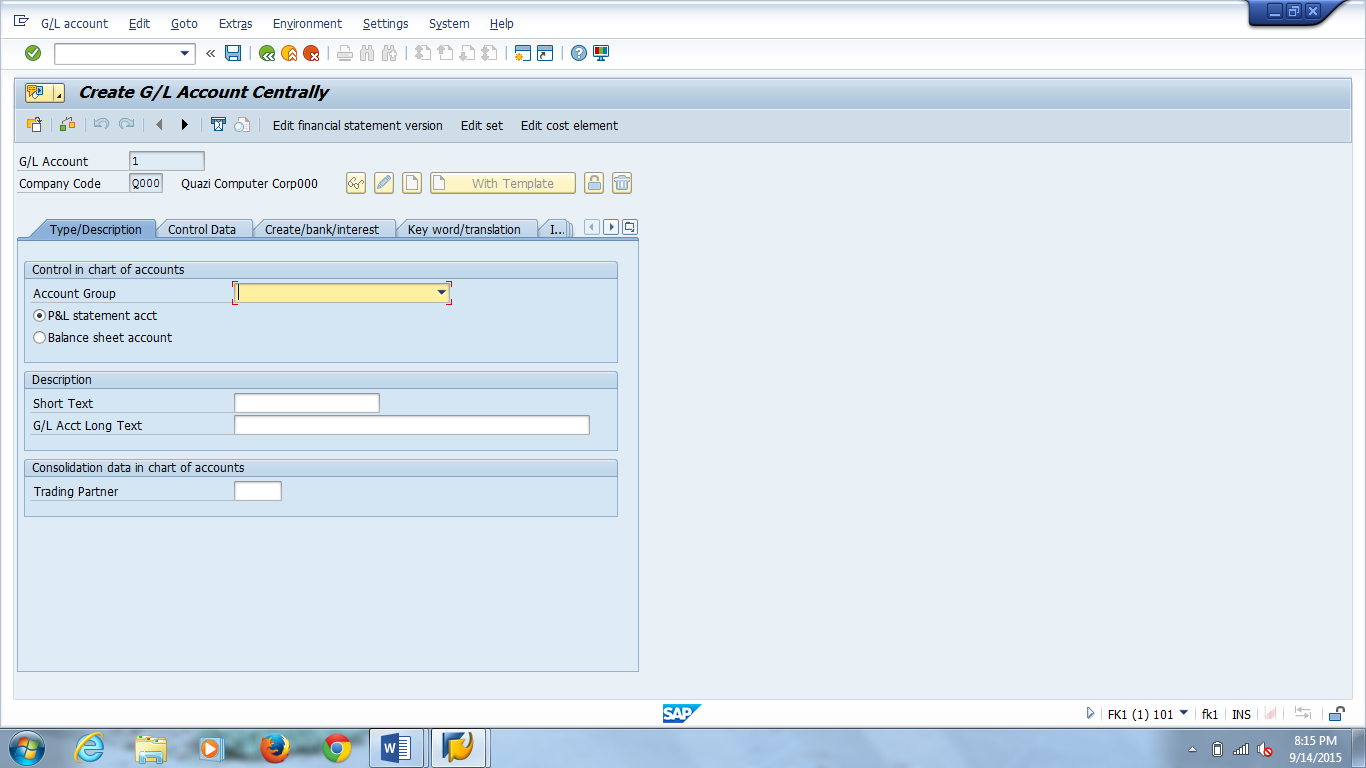 Back to SAP Easy Access
Menu
Back to SAP Easy Access
Menu
Material: Rocker_ _ _
Plant: C_ _ _
Costing Date From: current date
Costing Date To: 12/31/9999
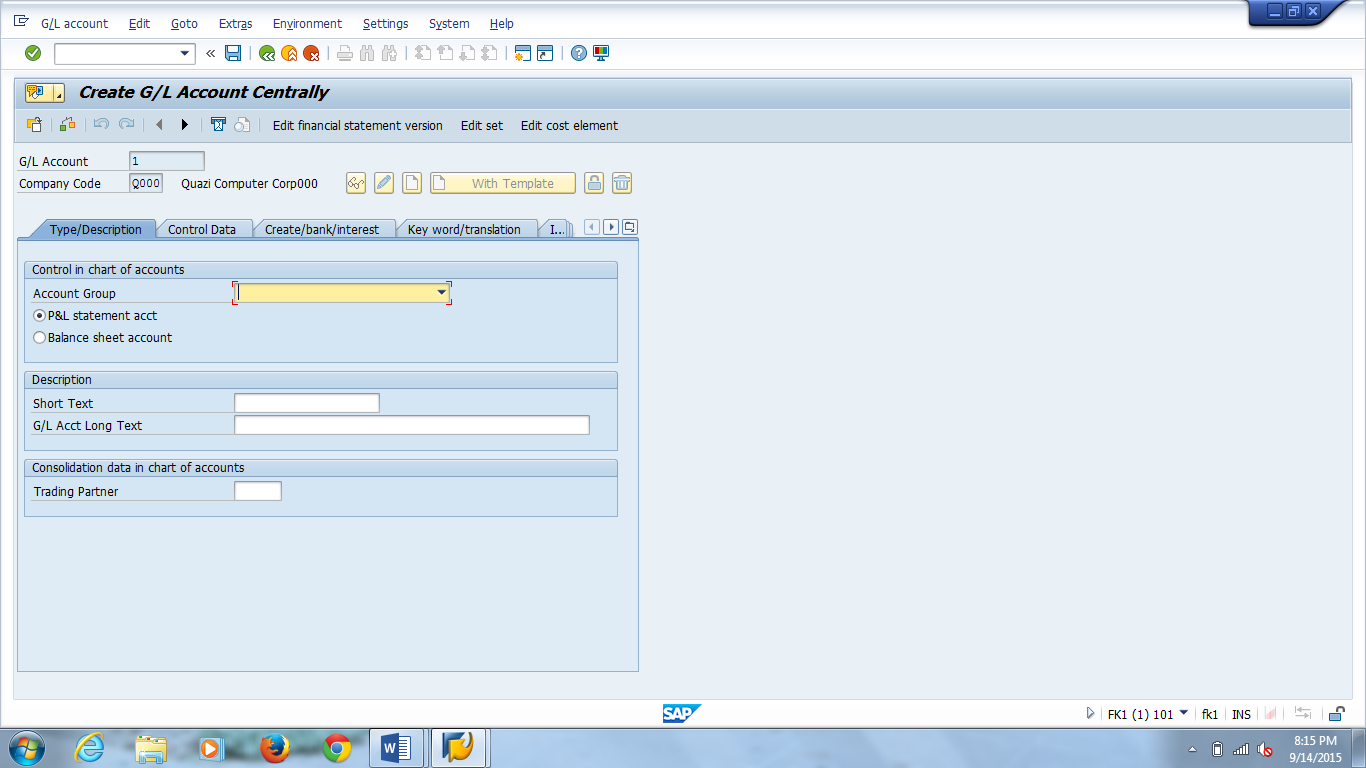 Back twice to SAP Easy
Access Menu
Back twice to SAP Easy
Access Menu

Company Code: C_ _ _
Plant: C_ _ _
Costing Version: 01
(Save)
Click on Release
Remove Test Run indicator (if it is checked)
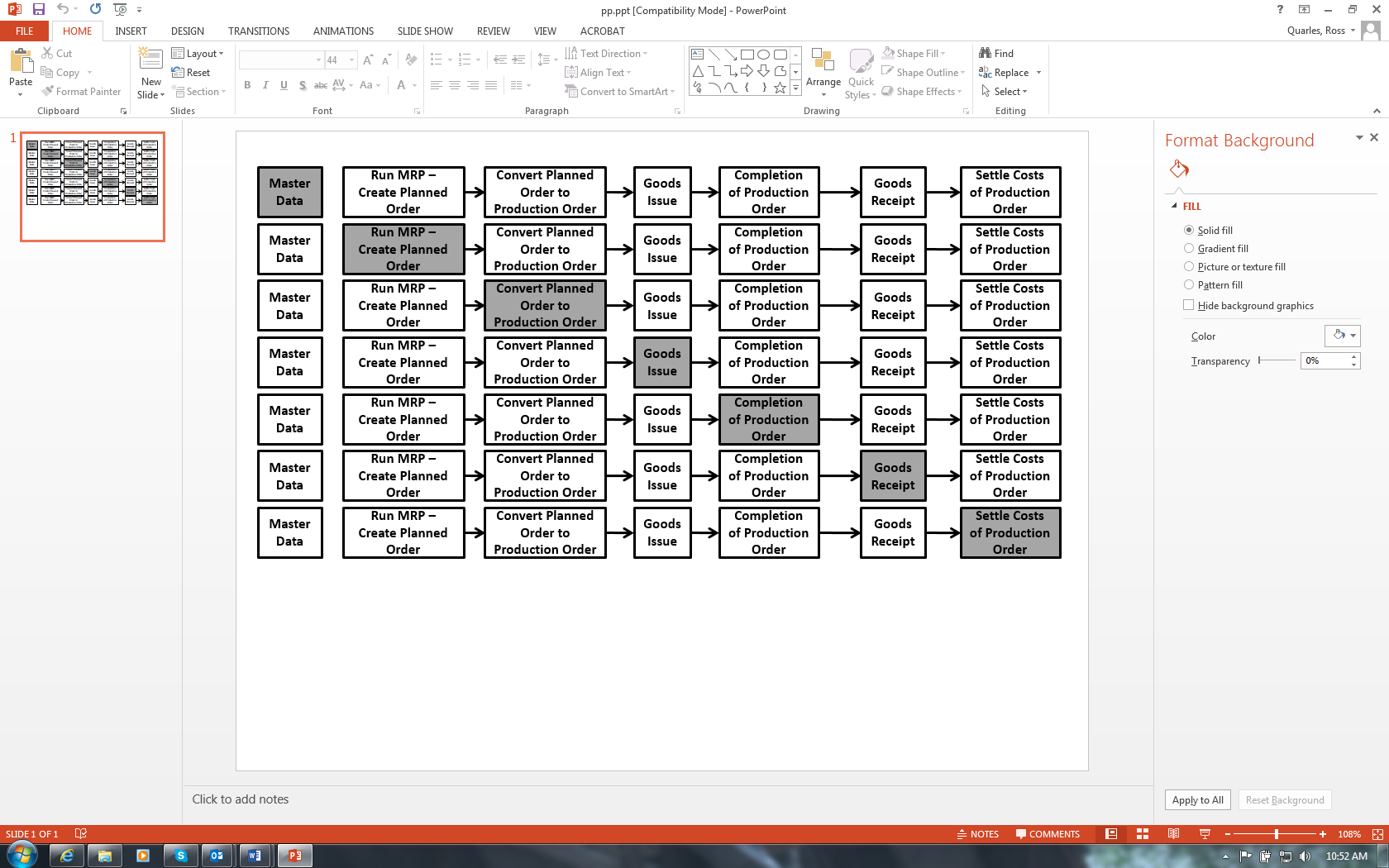
Exercise pp10: Run MRP – Single Item, Multi Level
Plant: C_ _ _
Processing Key: Net Change in Total Horizon Value: ______________
Scheduling: Determination of Basic Dates for Planned
Value: ______________
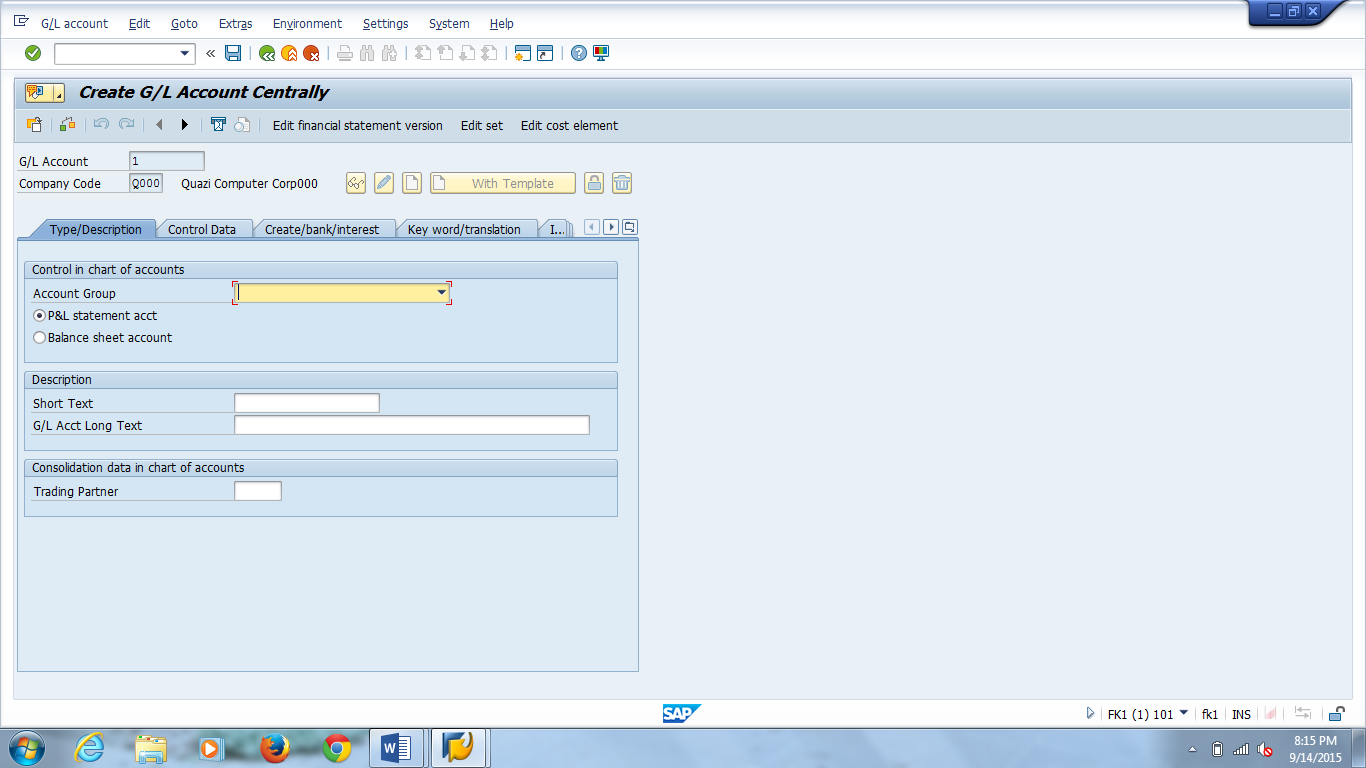 (ENTER) again to confirm
acceptance of the values entered and bypass the warning message
(ENTER) again to confirm
acceptance of the values entered and bypass the warning message
See example results shown on next page. No screenshot capture is required for this output. Your screen will differ in terms of the exact computing statistics and CPU times. However, your screen should look similar in format, design and types of data shown, particularly your three materials in the bottom left of the screen. Compare yours to the example for reasonableness and consistency.
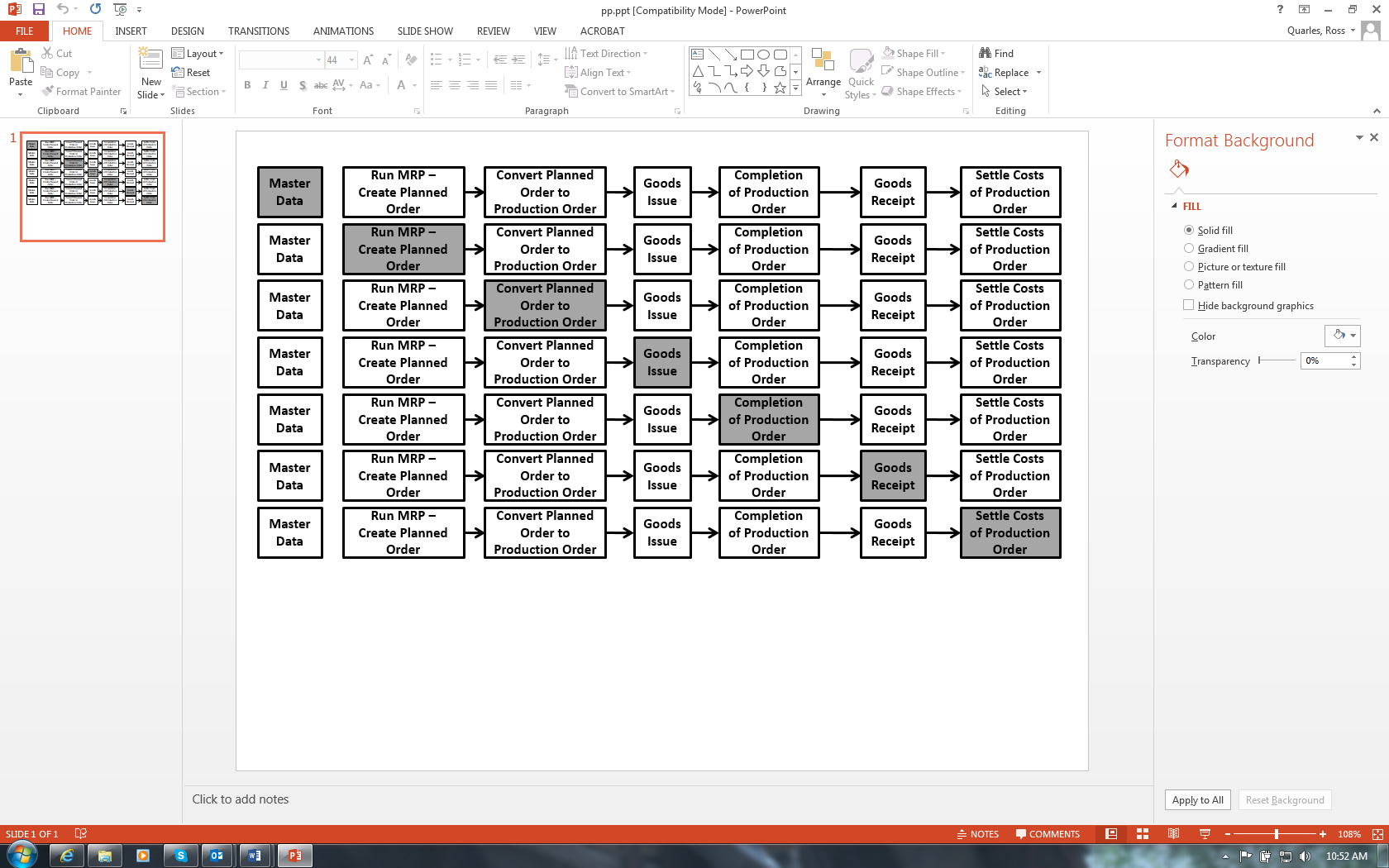
Exercise pp11: Display Stock/Requirements List
Plant: C_ _ _
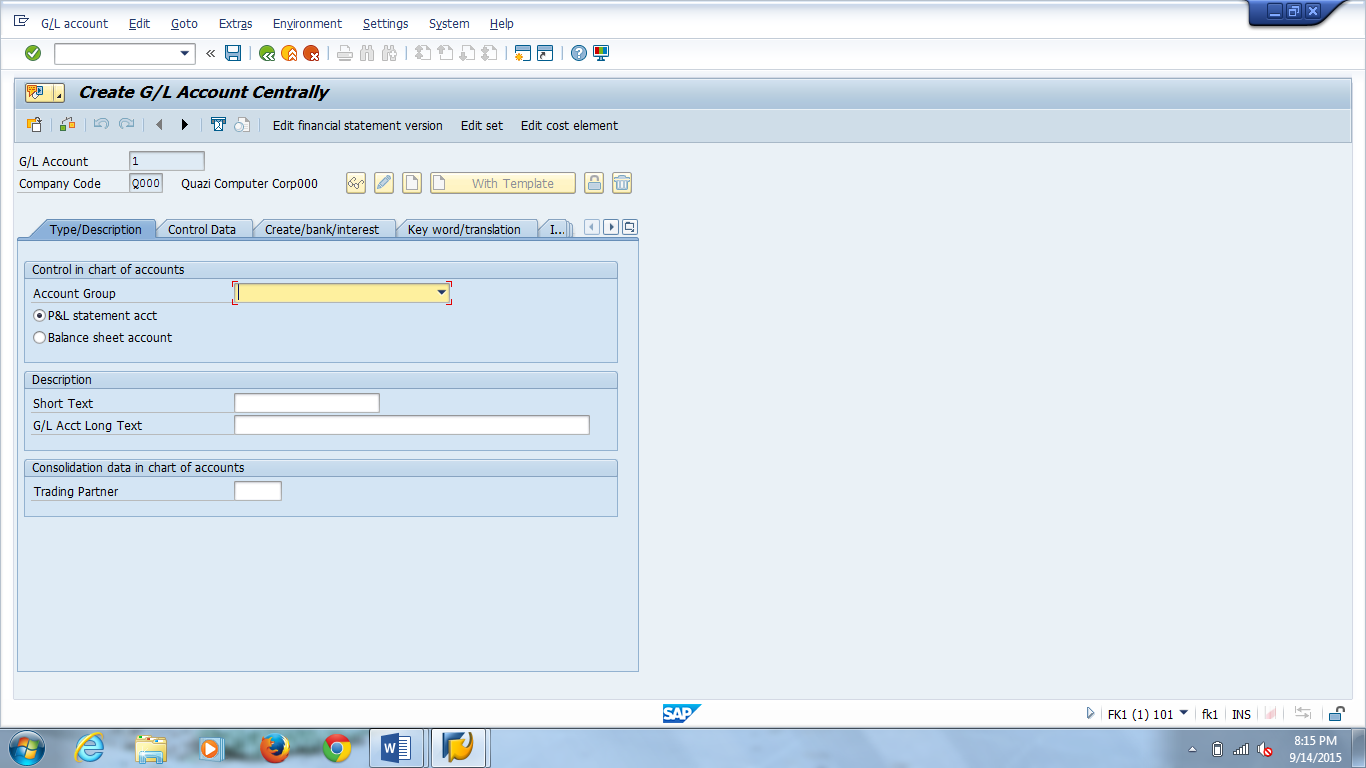 (ENTER)
(ENTER)
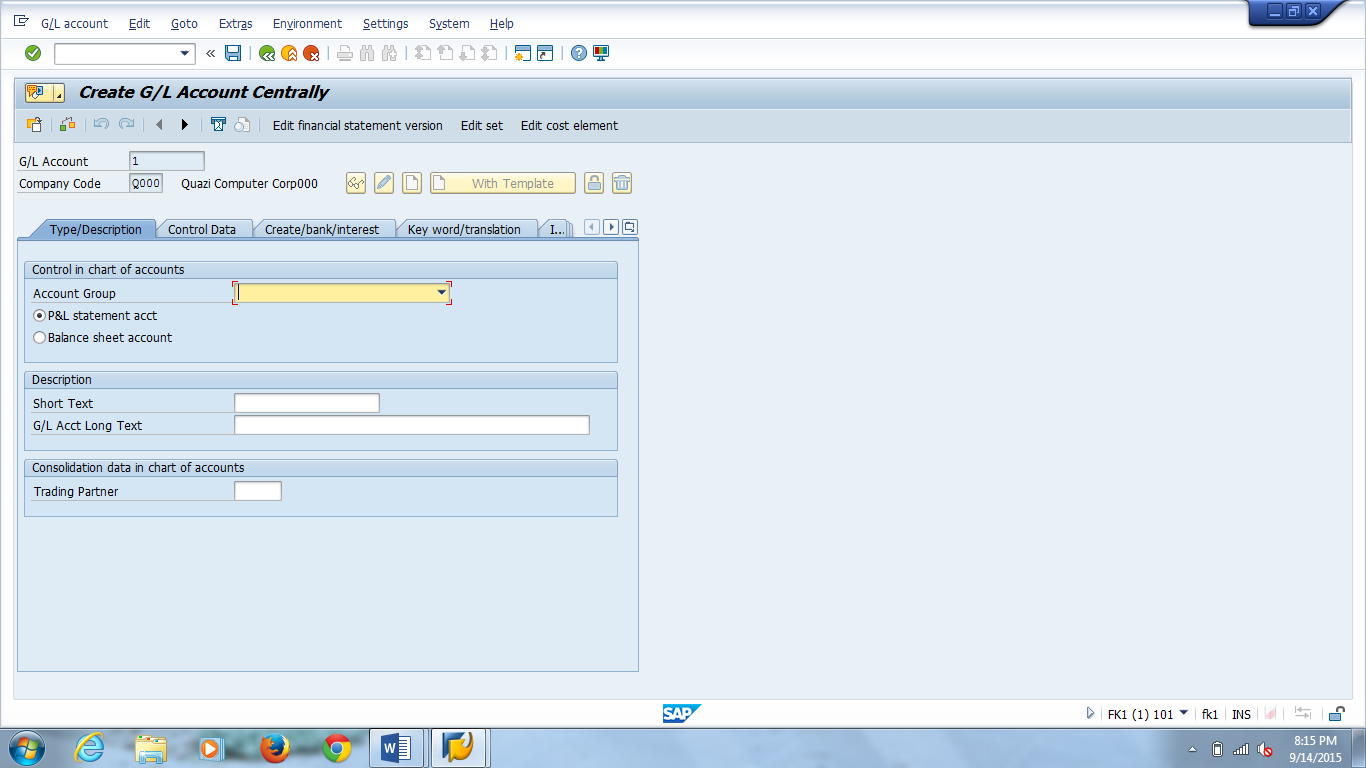 Back to SAP Easy Access
Menu
Back to SAP Easy Access
Menu
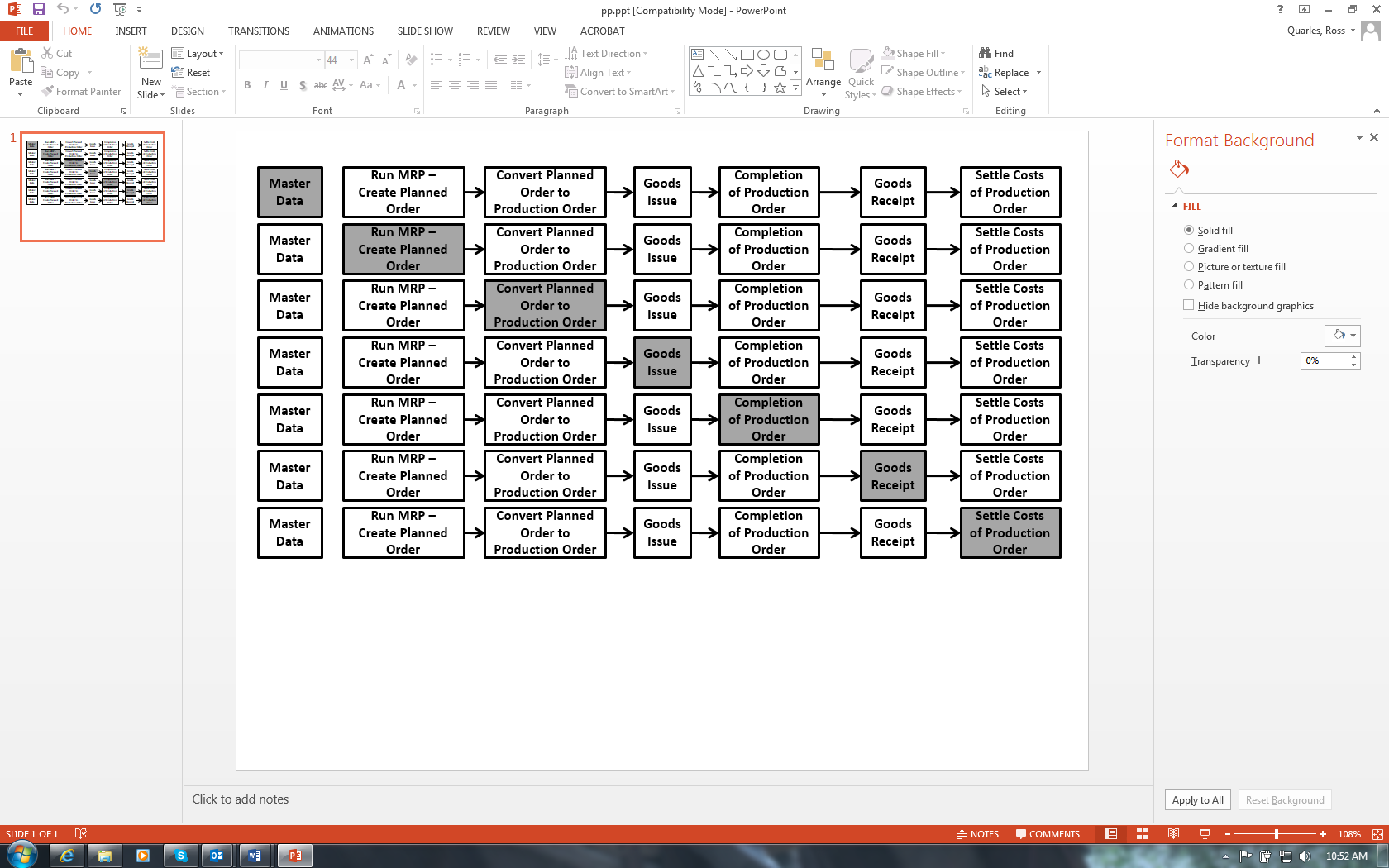
Plant: C_ _ _
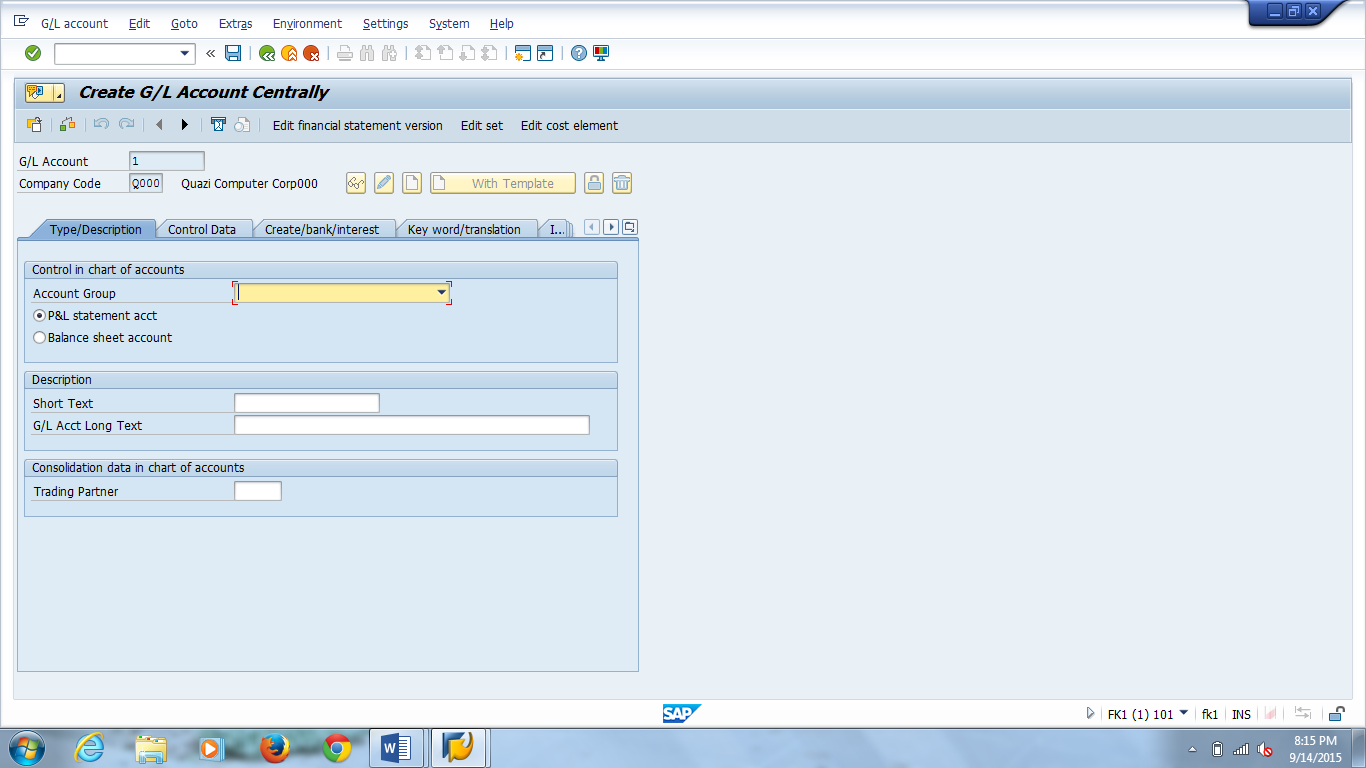 (ENTER)
(ENTER)
NOTE: For both this and the next steps, feel free to use the F4 function key on your keyboard or look-up button to the right of the field to call up an SAP calendar and double click on the appropriate date
Change the end date to two weeks from today
Notice the MRP elements change from the old PlOrd (i.e., planned) to display the new PrdOrd (i.e., production)
 Back to SAP Easy Access
Menu
Back to SAP Easy Access
Menu
Logistics ⇒ Production ⇒ Shop Floor Control ⇒ Goods Movements ⇒ Goods Issue / Goods Receipt

Select: Consumption for order from warehouse Value: ______________
(EXECUTE)
Note that after entering the Storage Location and clicking through material the respective locations show in the upper section under the
tab.
(POST/SAVE)
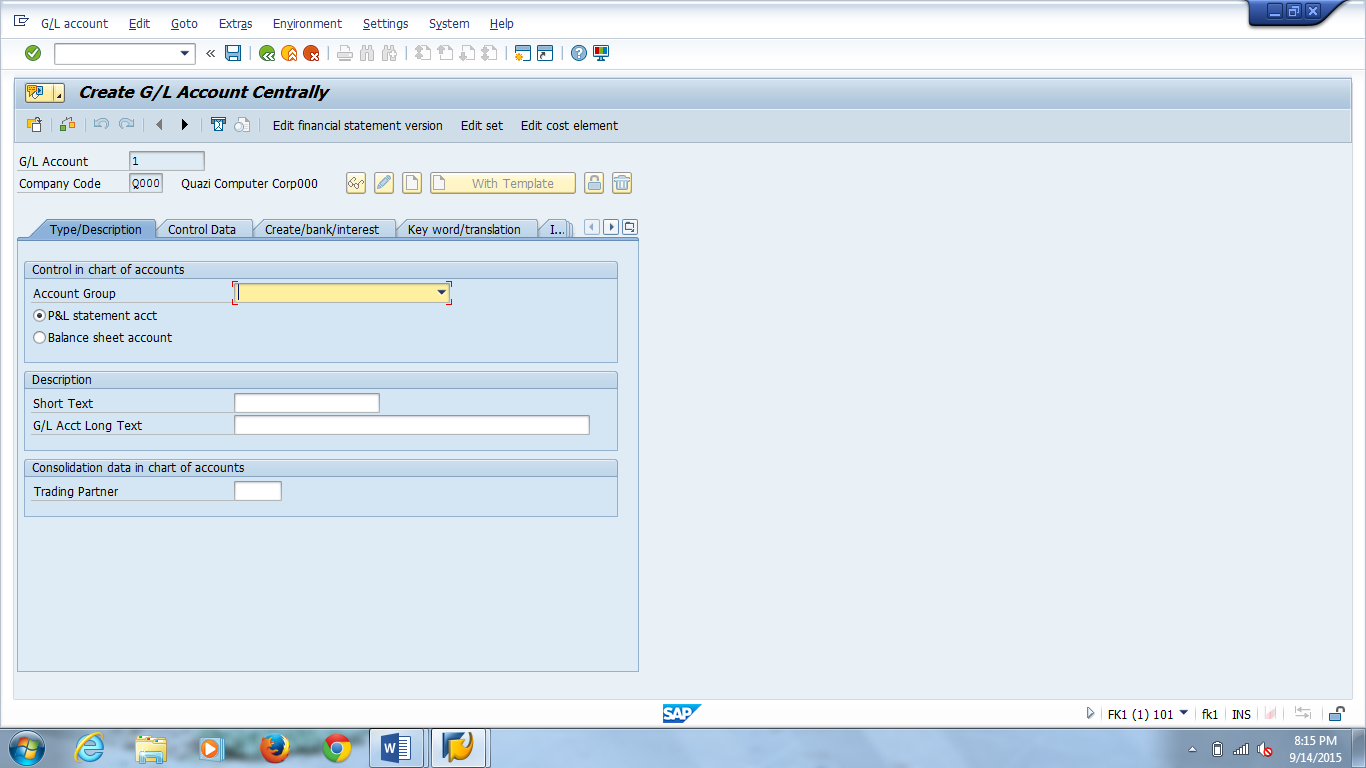 Back to SAP Easy Access
Menu
Back to SAP Easy Access
Menu
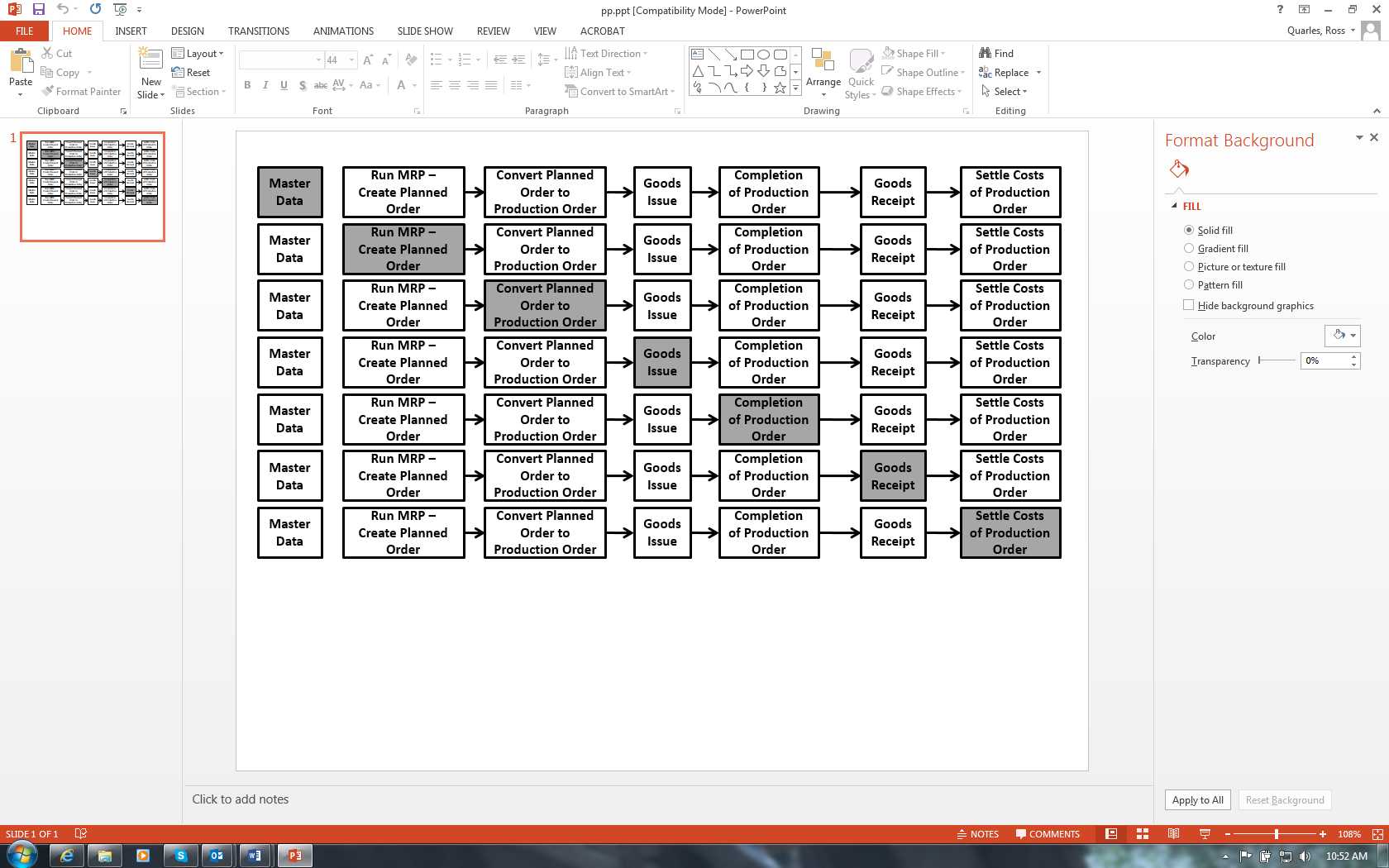
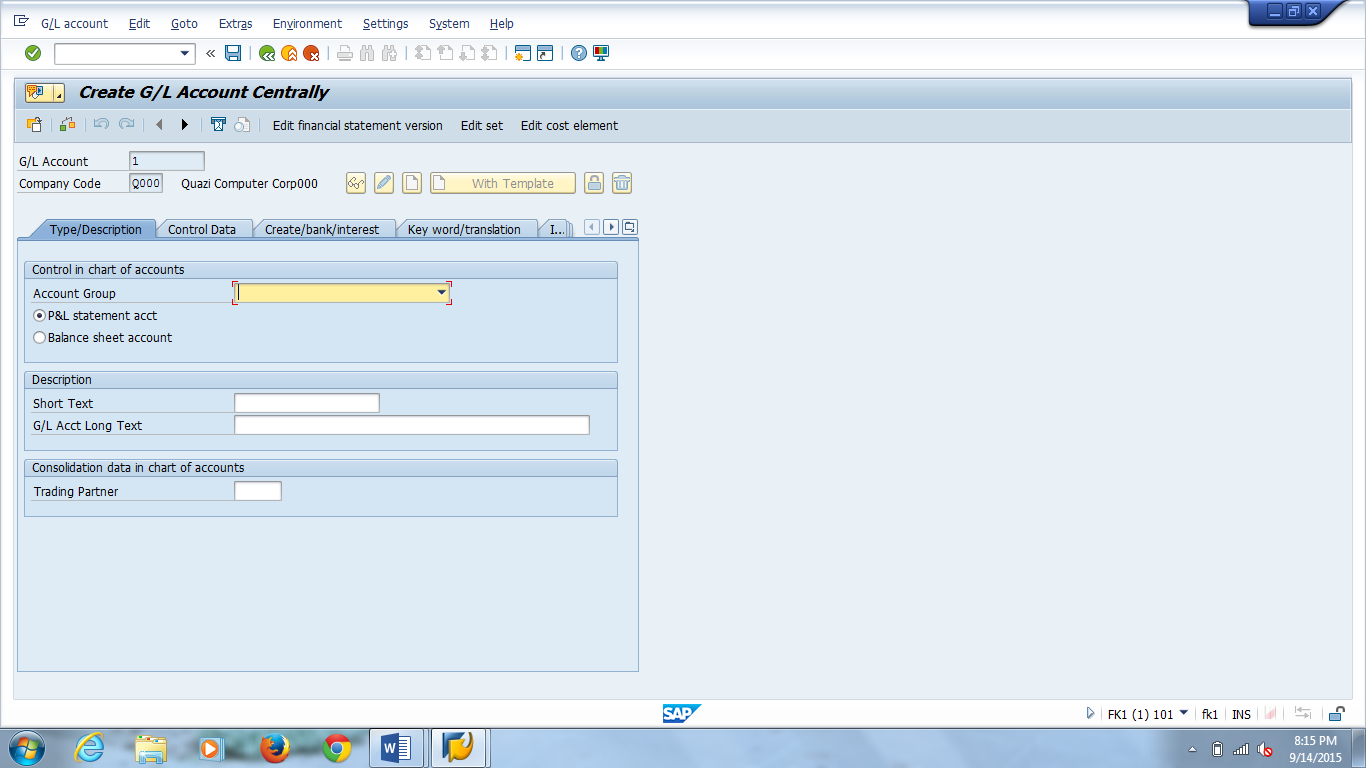 (ENTER)
(ENTER)
Select: Final Confirmation
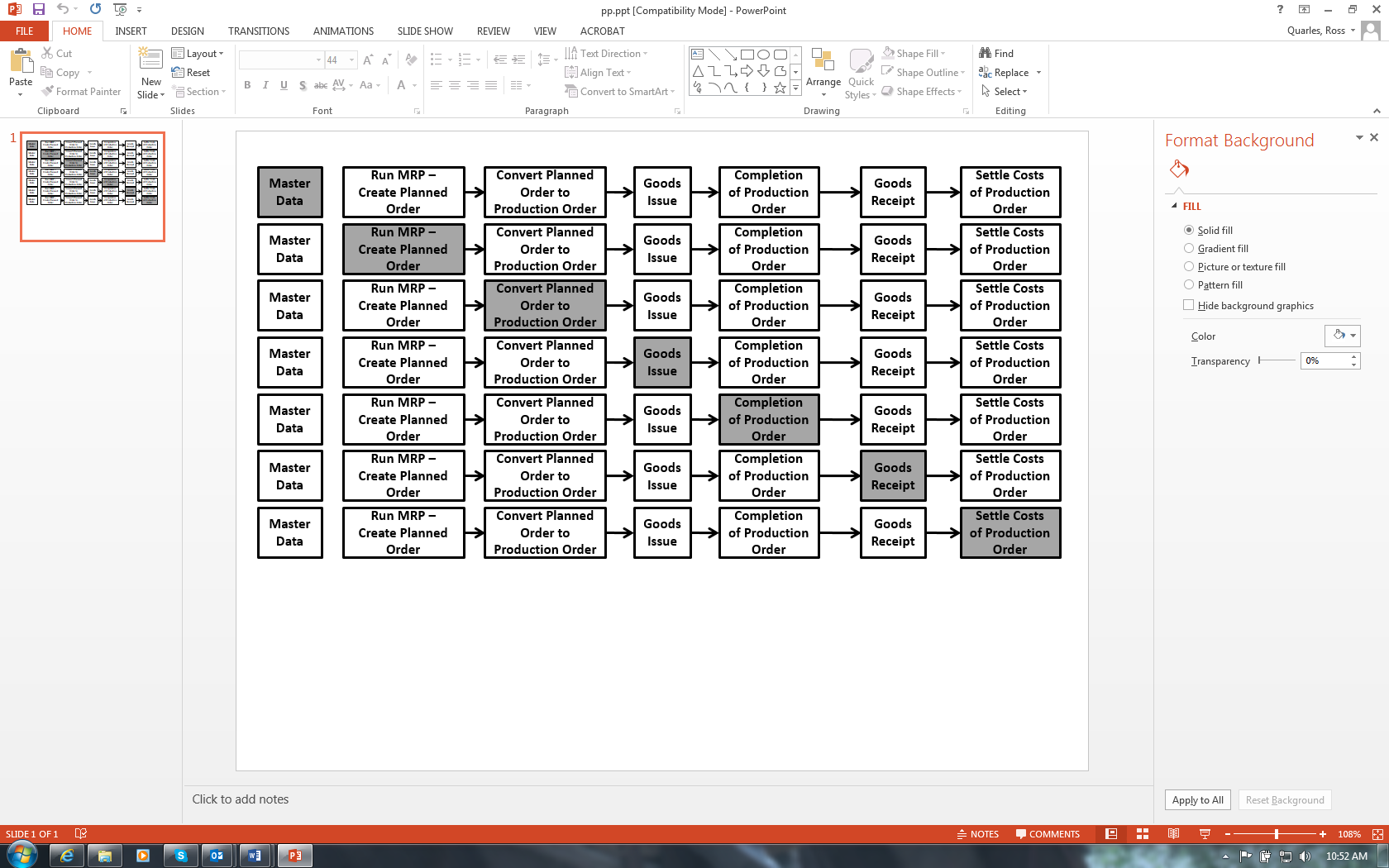
Select: Goods Receipt
Select: Order
(EXECUTE)
On the
 tab in the Item Detail
section, enter Storage Location (Stor. Loc.) for your rocker material
shown below, clicking after entering
tab in the Item Detail
section, enter Storage Location (Stor. Loc.) for your rocker material
shown below, clicking after entering
Goods Receipt ⇒ Display
If you do not get a message, then your document number will show at the bottom of the screen.
Exercise pp16: Settle Costs of Production Order
This exercise moves any production cost differences to the appropriate general ledger accounts.
Order: Your Order # (from exercise PP12) Value: ______________
Settlement Period: Current month (choose appropriate
(EXECUTE)
If receiving a popup message that the moving average price for material would be negative, ignore and click Enter to exit the popup message
If again receiving the popup message noted above, ignore and click Enter
The previous results are shown again, but this time you have settled the production order
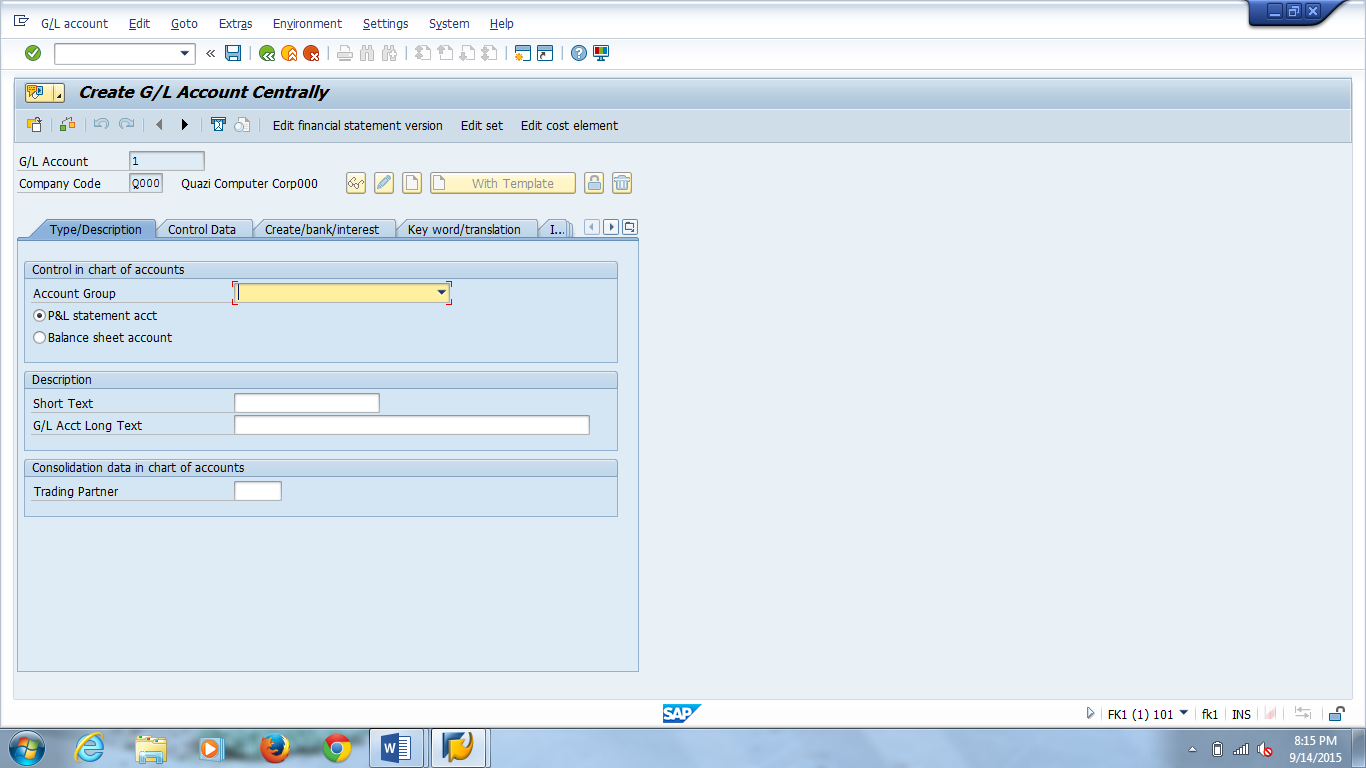 (ENTER)
(ENTER)
Compare your screenshot to that shown below. Please carefully note each of the following:
PRINT THE SCREEN (IF REQUIRED BY YOUR INSTRUCTOR)
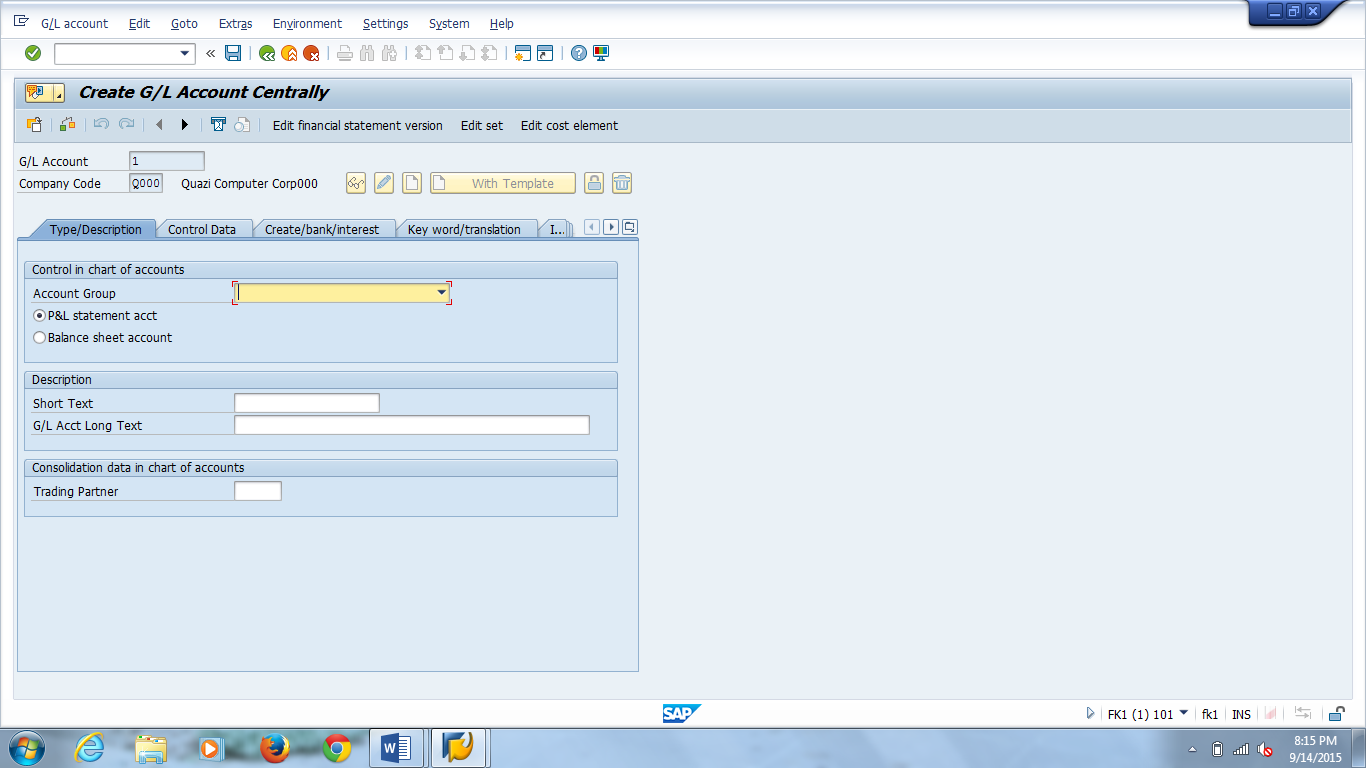 Back to SAP Easy Access
Menu
Back to SAP Easy Access
Menu

Select Display
Click on Doc. Info tab
Click
Click . The resulting view is slightly different, showing the general ledger view of your accounting document and the entry made.
Click . Consistent with that seen in MM11, the pop-up screen identifies your user name as the one who entered this transaction. Please continue to recognize that SAP has a good audit trail of transactions processed.
Chapter 4: Sales Logistics (SD)
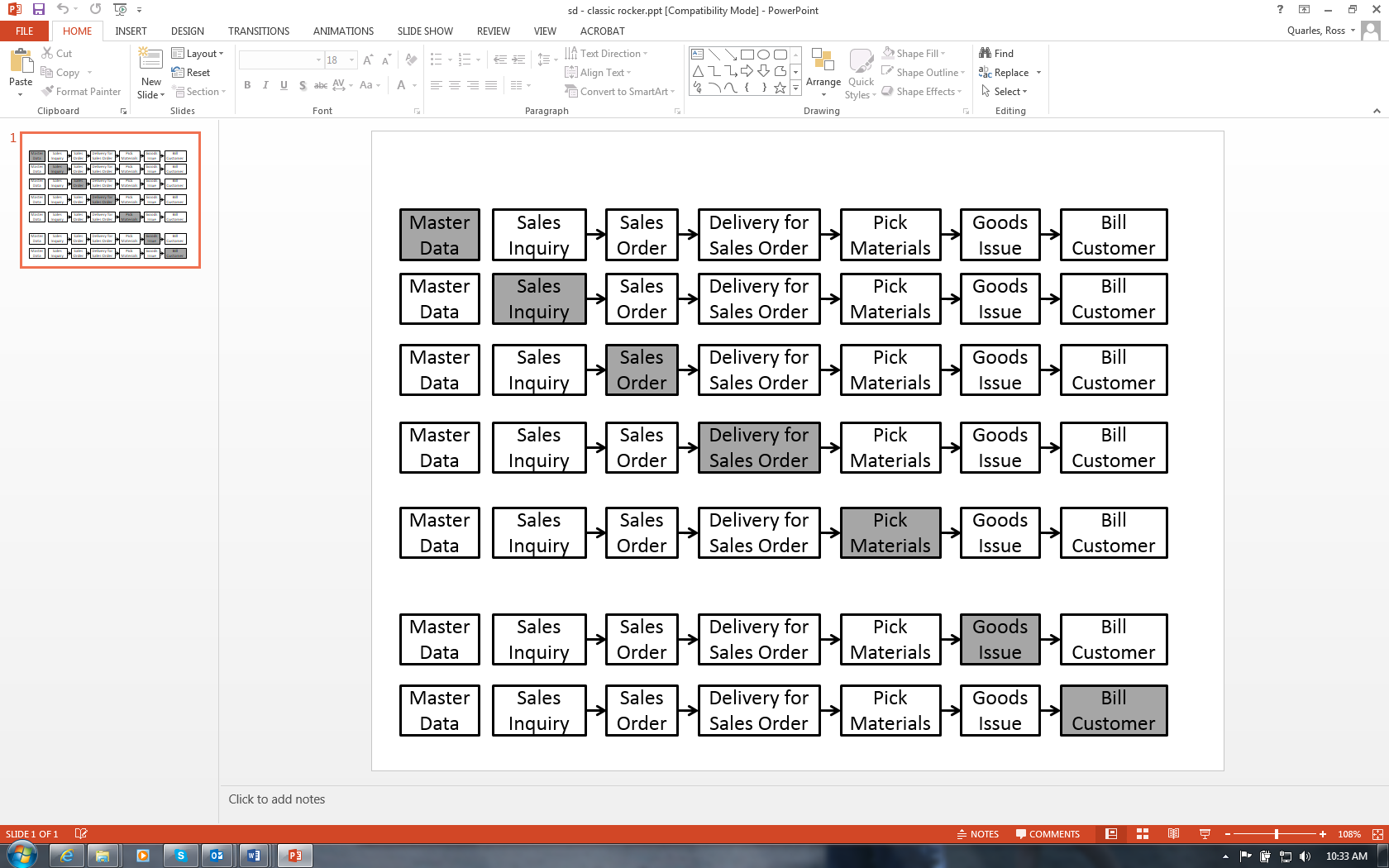
disregard it and type in the value for this step)
Company Code: C_ _ _
Short Text: AR Recon_ _ _
G/L Acct Long Text: Accounts Receivable Reconciliation _ _ _
Field status group: Reconciliation Accounts Value: ______________
(SAVE)
Company Code: C_ _ _
(CREATE)
G/L Acct Long Text: Sales Revenue_ _ _
Control Data TAB
Create/bank/interest TAB
Field status group: Revenue Accounts Value: ______________
Company Code: C_ _ _
(CREATE)
G/L Acct Long Text: Sales Discount_ _ _
Continued on next page
CElem category: Sales deduction Value: ______________
Create/bank/interest TAB
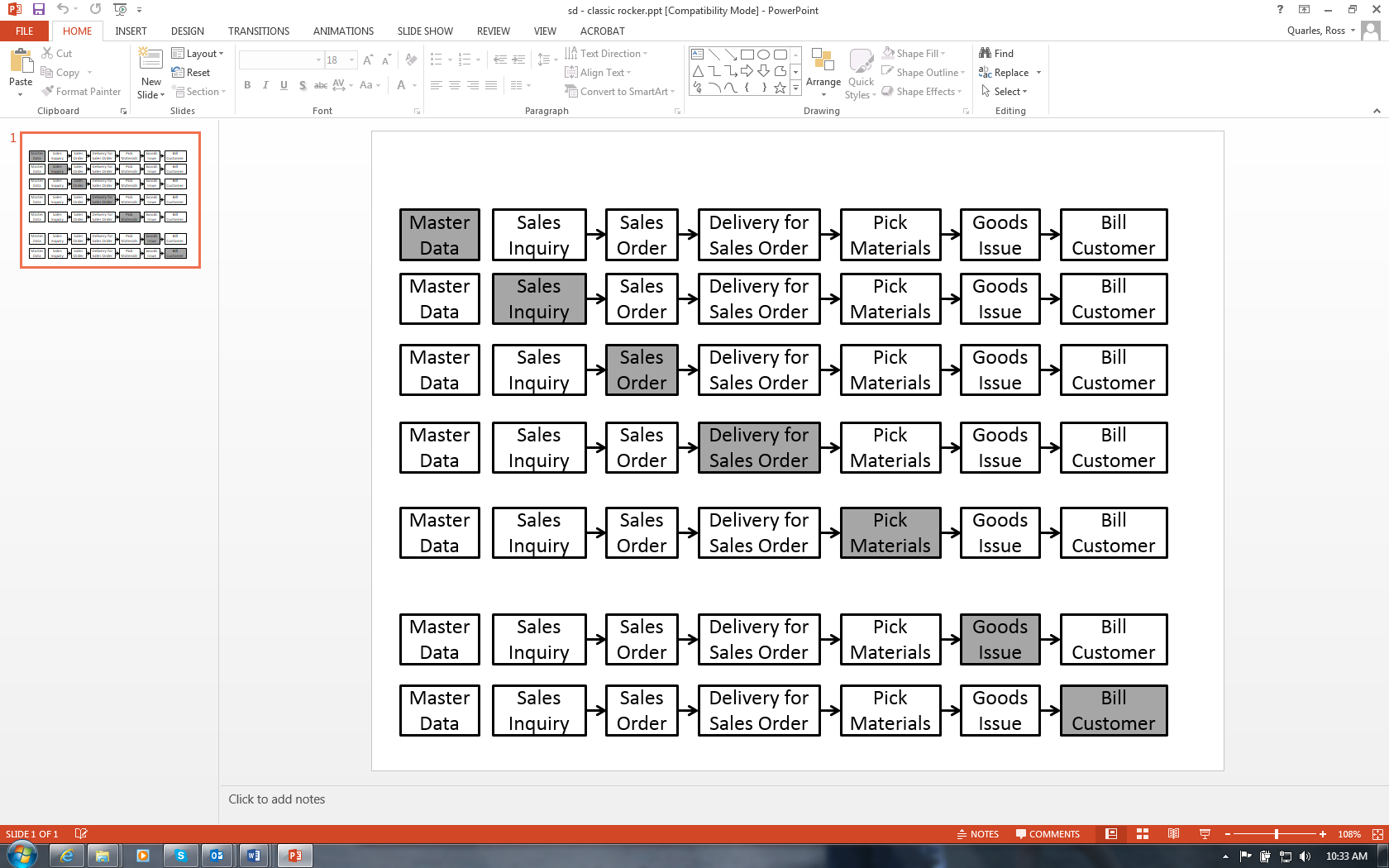
Exercise SD02: Create Customer
Old Tyme Furniture HQ_ _ _ Sarasota, FL Dist.Ch: Direct
Sunny Porch Pastimes_ _ _ Sunnyland, AZ Dist.Ch: Direct
(ENTER)
Address Tab:
City: Customer’s city (from table above)
Country: USA Value: ______________
Continued on next page
Tax Juris.: _ _0000000 (State code plus 7 zeroes)
Change in BP role: FI Customer [which will result in an entry of FI Customer (New)]
Select
Customer: Payment Transactions Tab:
Payment terms: Payable immediately Due net Value: ______________
Sales Organization: C_ _ _
Distribution Channel: as listed in the table above for each customer
 (ENTER)
(ENTER)
Orders Tab:
Price Group: Bulk buyer Value: ______________
Cust.Pric.Procedure: Standard Value: ______________
Delivery Priority: Normal item Value: ______________
Order Combination
Max.Part.Deliveries: 9
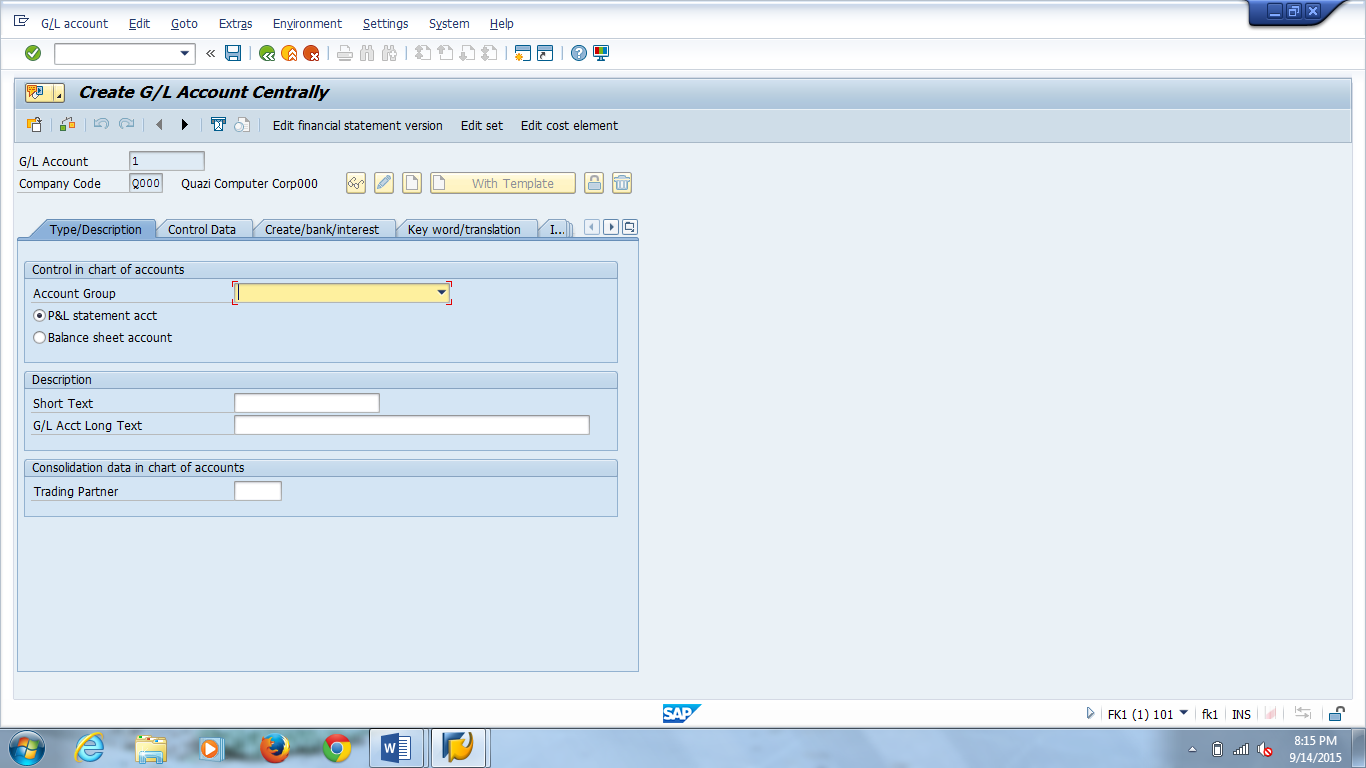 (ENTER)
(ENTER)
Acct Assmt Grp Cust.: Domestic Revenues Value: ______________
Output Tax (You may need to widen the column)
NOTE: When you start Stephanie’s Designs be sure to change the distribution channel to the appropriate code
Old Tyme Furniture HQ ________________
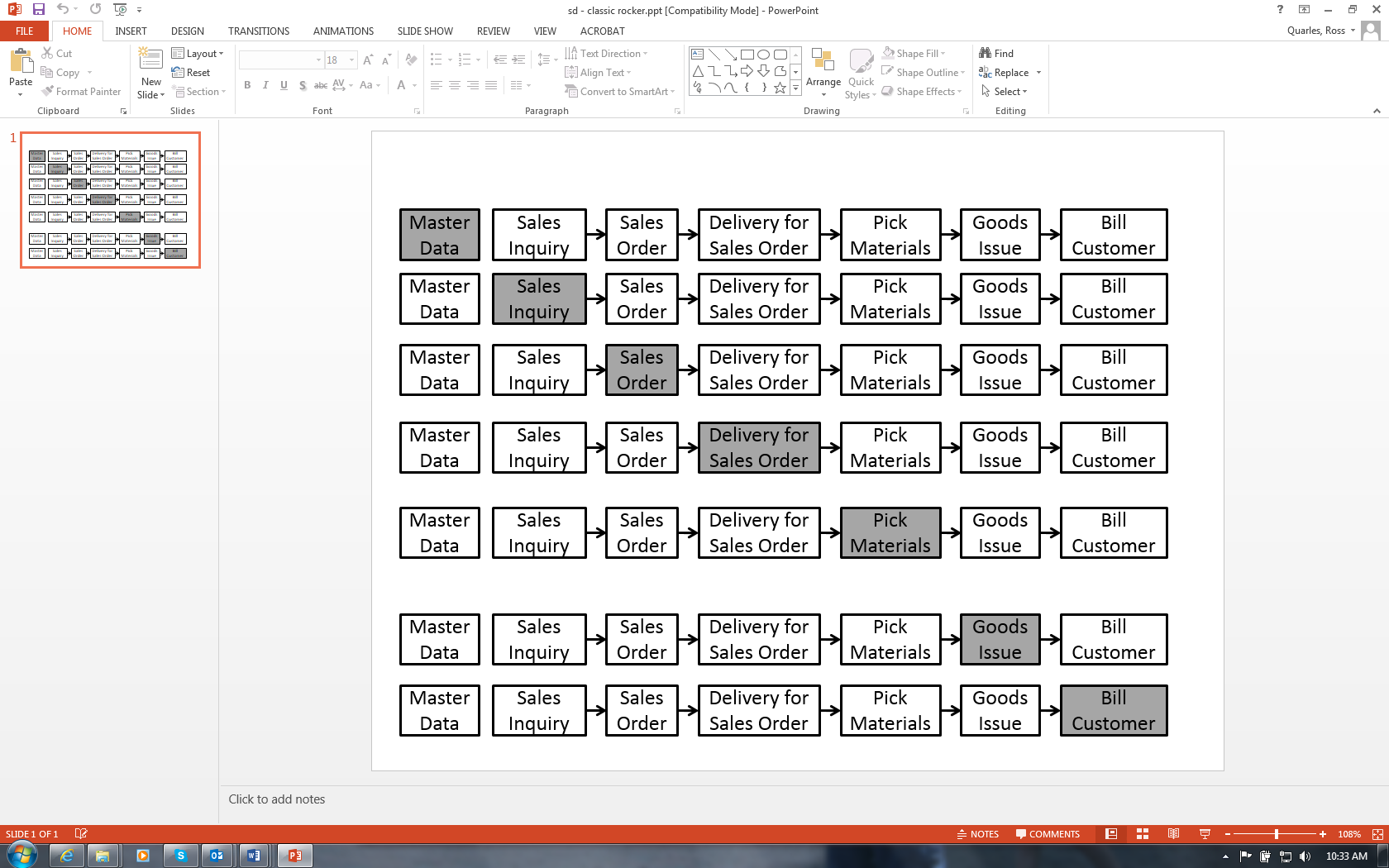
Exercise SD03: Create Sales views for Trading Goods
Because the materials must have sales views created for both direct and wholesale, this exercise must be performed twice.
Logistics ⇒ Sales and Distribution ⇒ Master Data ⇒ Products ⇒ Material ⇒
Sales Org: C_ _ _ C_ _ _
Distr. Channel: * Direct Direct
* See bolded comment at end of exercise
Sales: General/Plant Data
Deselect any other views already selected
Select the button
Sales: sales org. 1 View
County Sales Tax: Exempt Value: ______________
City Sales Tax: Exempt Value: ______________
Sales: General/Plant View
Trans. Grp: On pallets (for route determination) Value: ______________
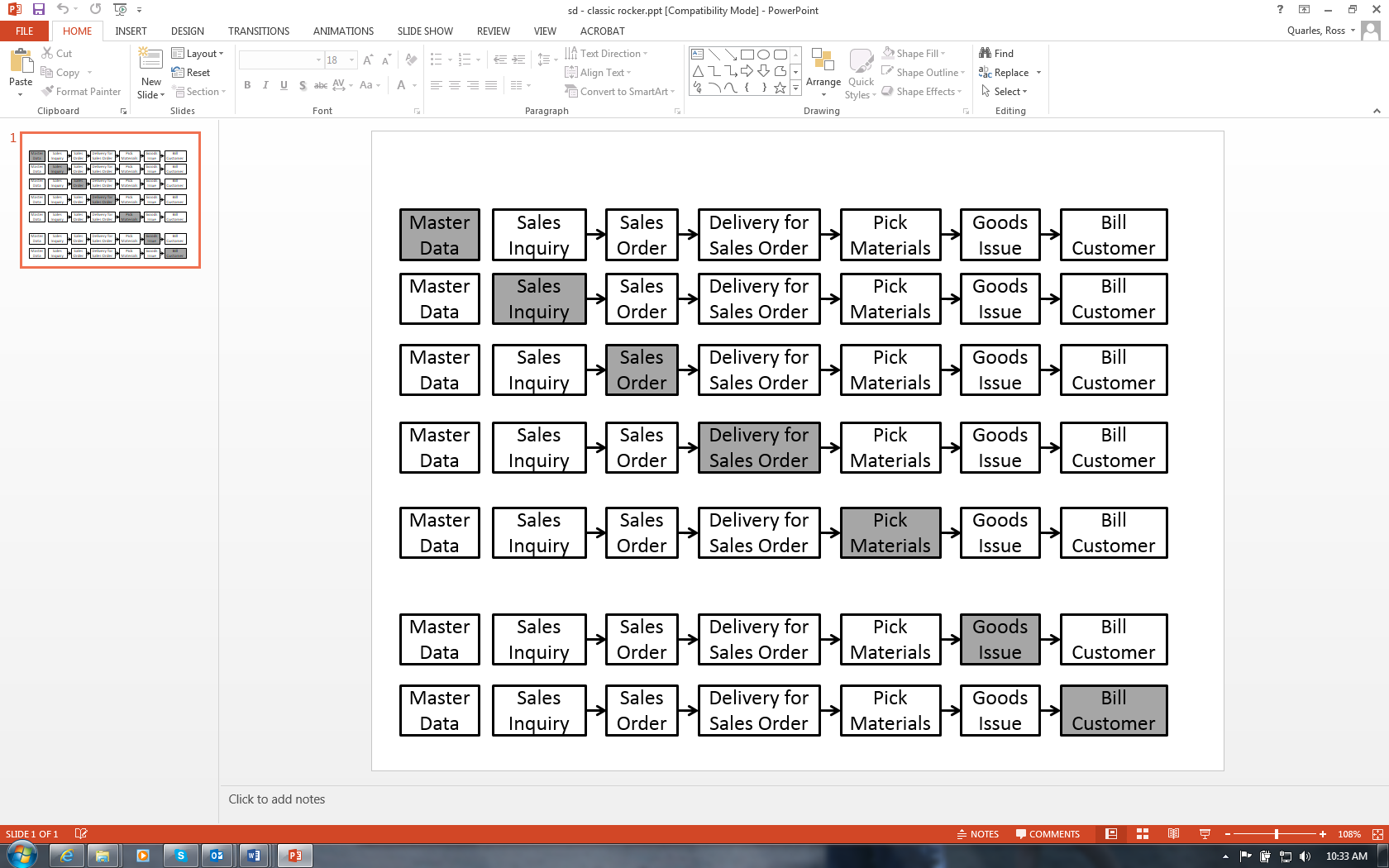
Exercise SD04: Create Sales views for Finished Products
Select to see which distribution channel value (WH or DI) is currently entered. When performing this exercise the second time (see description above), change the value in the field to the other channel. The system will tell you if the material is already maintained for a channel.
(ENTER)
Tax Data
Tax Jurisdict.Code: Exempt Value: ______________
Matl statistics grp: ‘A’ Material Value: ______________
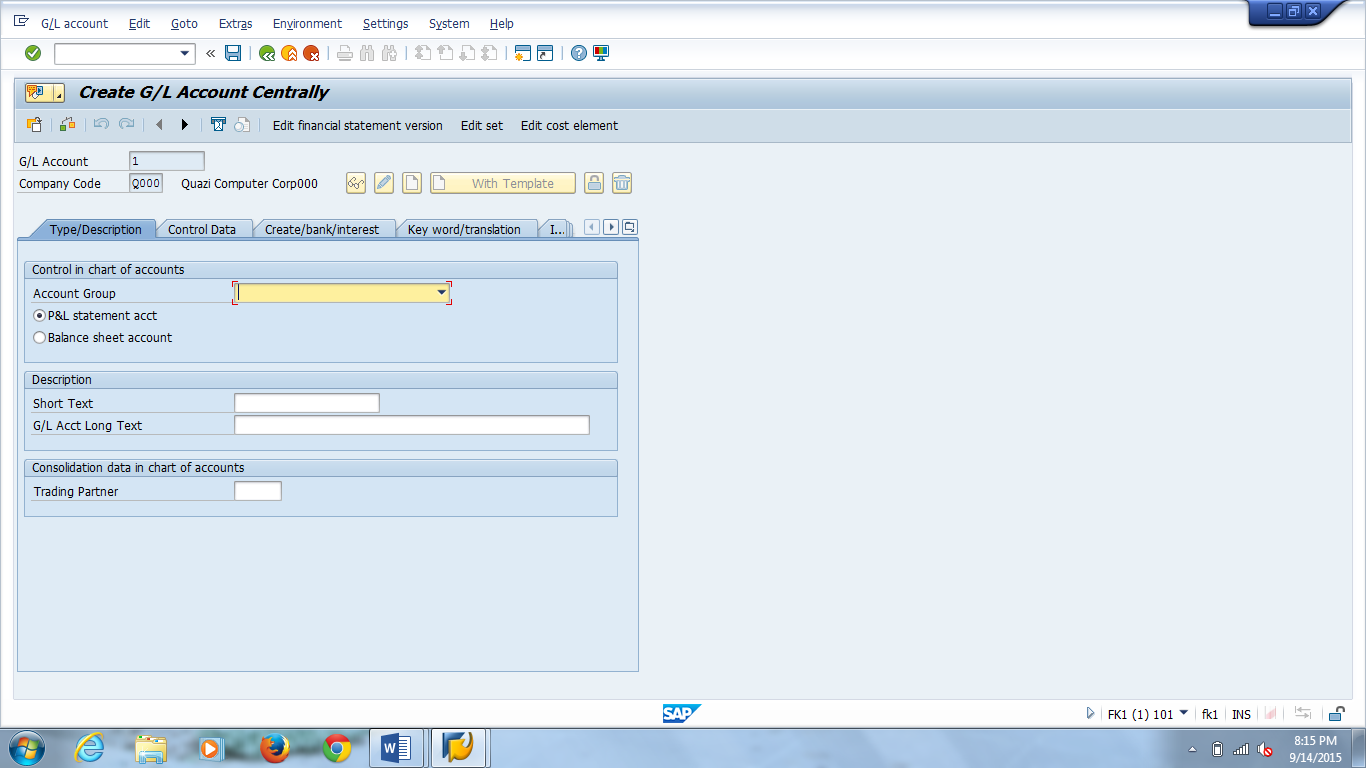 (ENTER)
(ENTER)
*Remember to change the default to the other distribution channel and reperform this exercise a second time
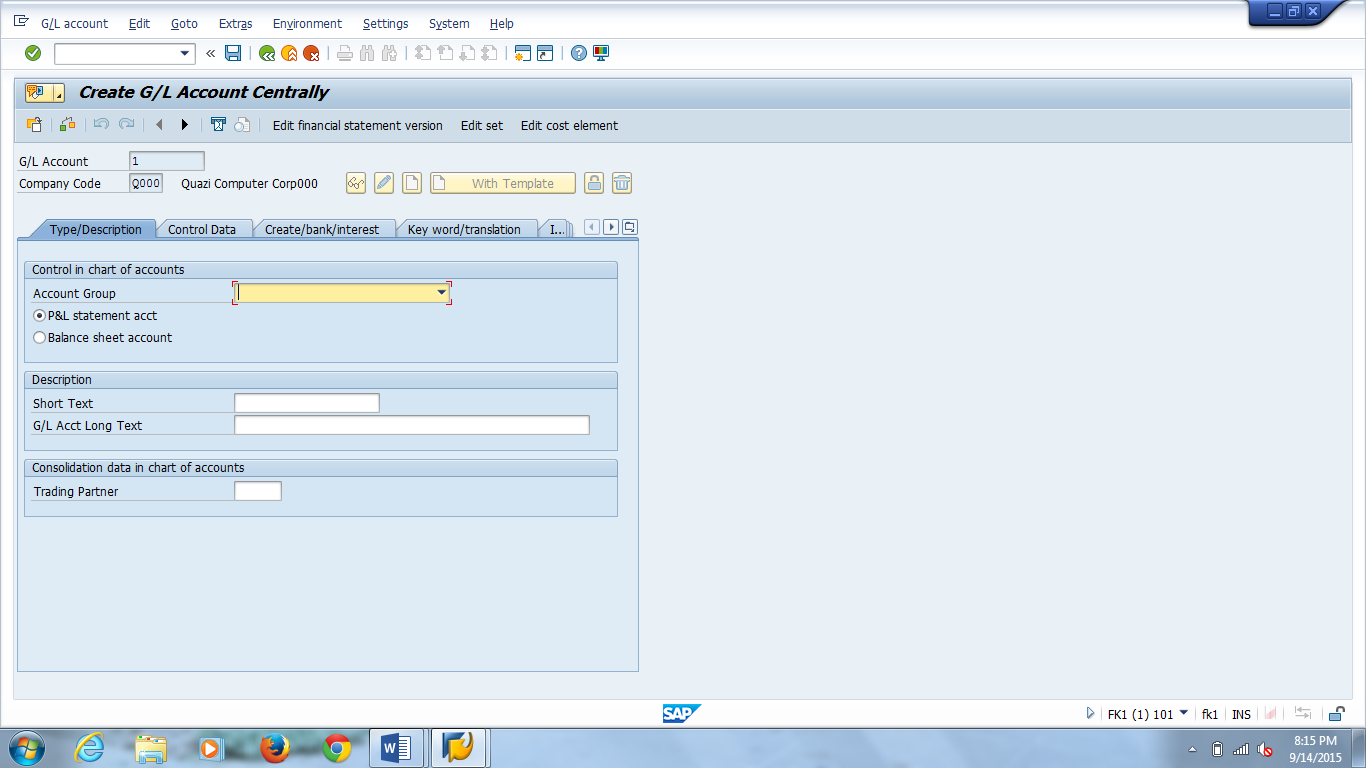 Back to SAP Easy Access
Menu
Back to SAP Easy Access
Menu
(At new screen) Prices ⇒ Material Price
Select (click on)
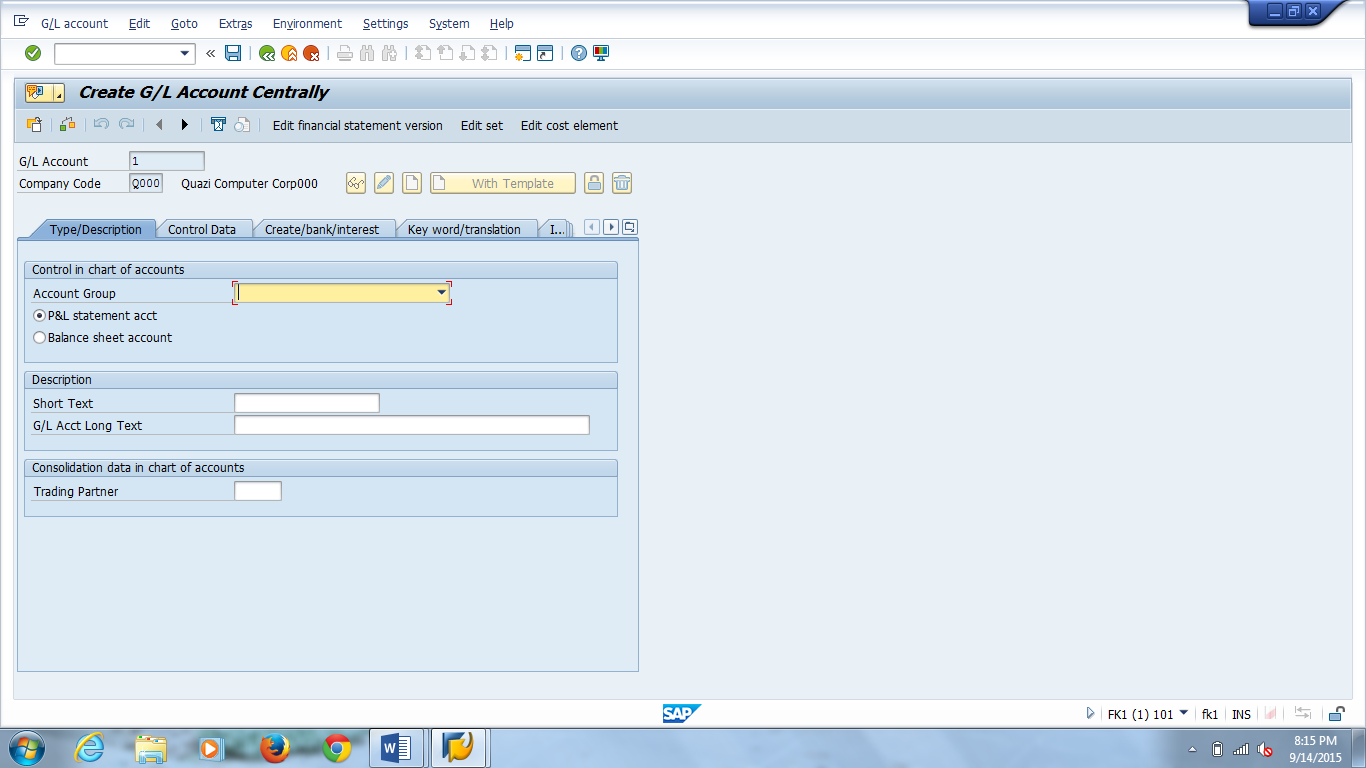 (ENTER)
(ENTER)
Sales Organization: C_ _ _
Distribution Channel: Wholesale Value: ______________
| Condition type | Material | Amount (for WH) |
|
| Price | Your Cushion | $ 25.00 | |
| Price | Your Rocker | $ 115.00 |
If you are on the Create Condition Records screen you can remain where you are for the next exercise
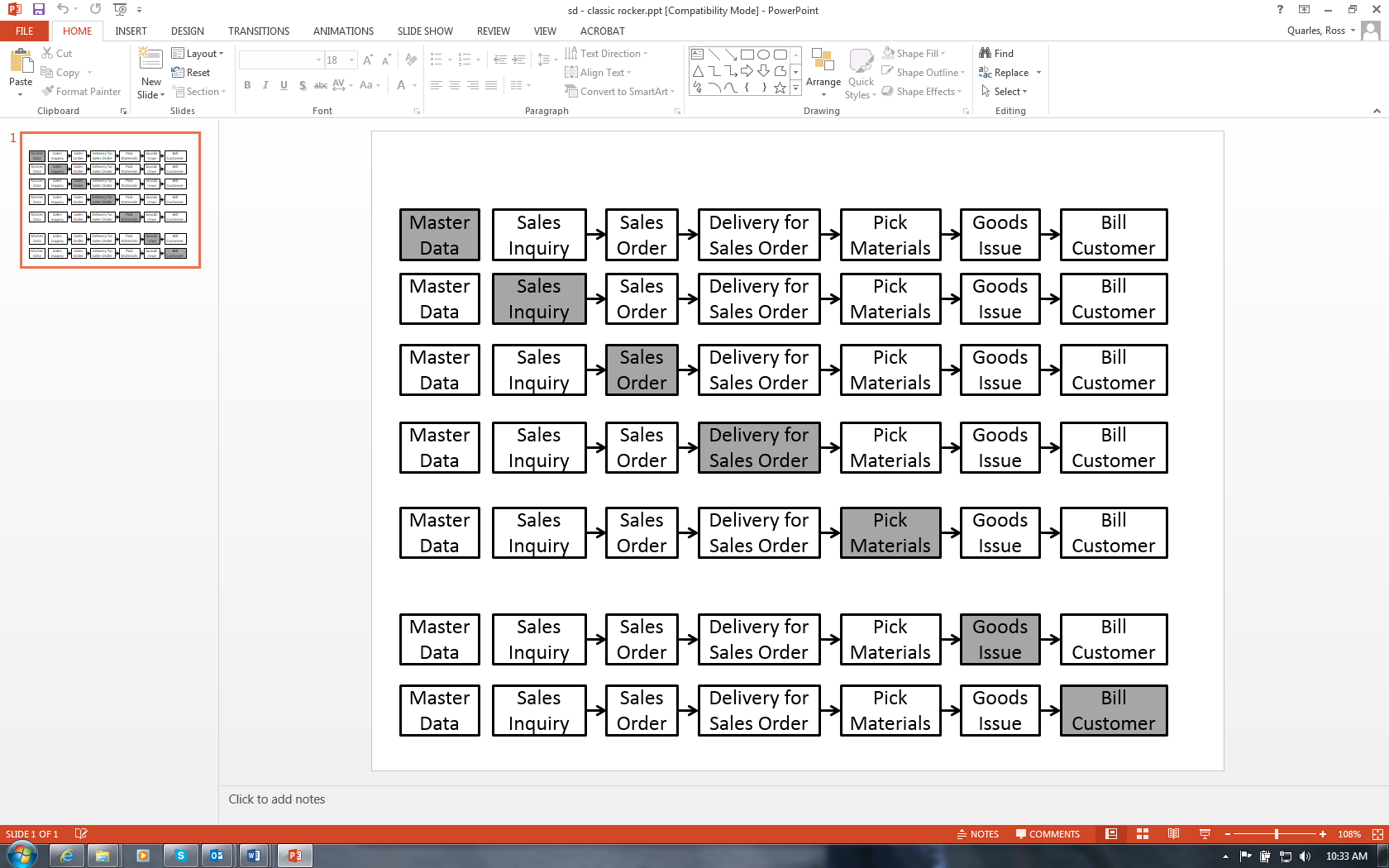
(At new screen) Prices ⇒ Individual Prices
Select
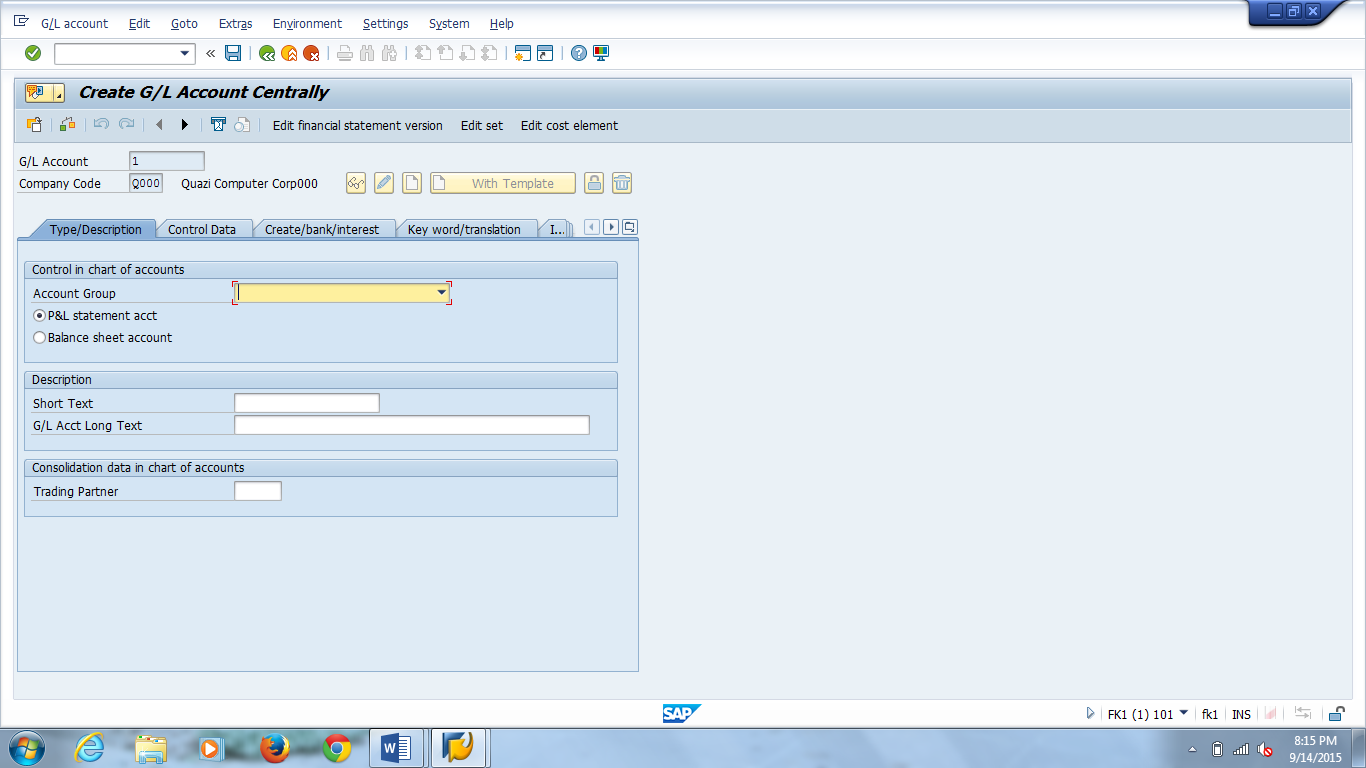 (ENTER)
(ENTER)
The system will automatically enter the material descriptions and units of currency and measure
This example shows a value discount being created for a specific customer. This is also an example of a pricing scale. This condition type is currently set for 'Item condition', but could be changed to 'Header condition' in the IMG.
If you are already on the Create Condition Records screen you can avoid the following drill down by selecting and moving to the steps below
Select
Sales Organization: C_ _ _
Select the line item (click the box to the left of the line to select)
Click on the scales button to give the customer a discount of 5% for order values between $500 and $1500 and a discount of 10% for orders larger than $1500
(SAVE)
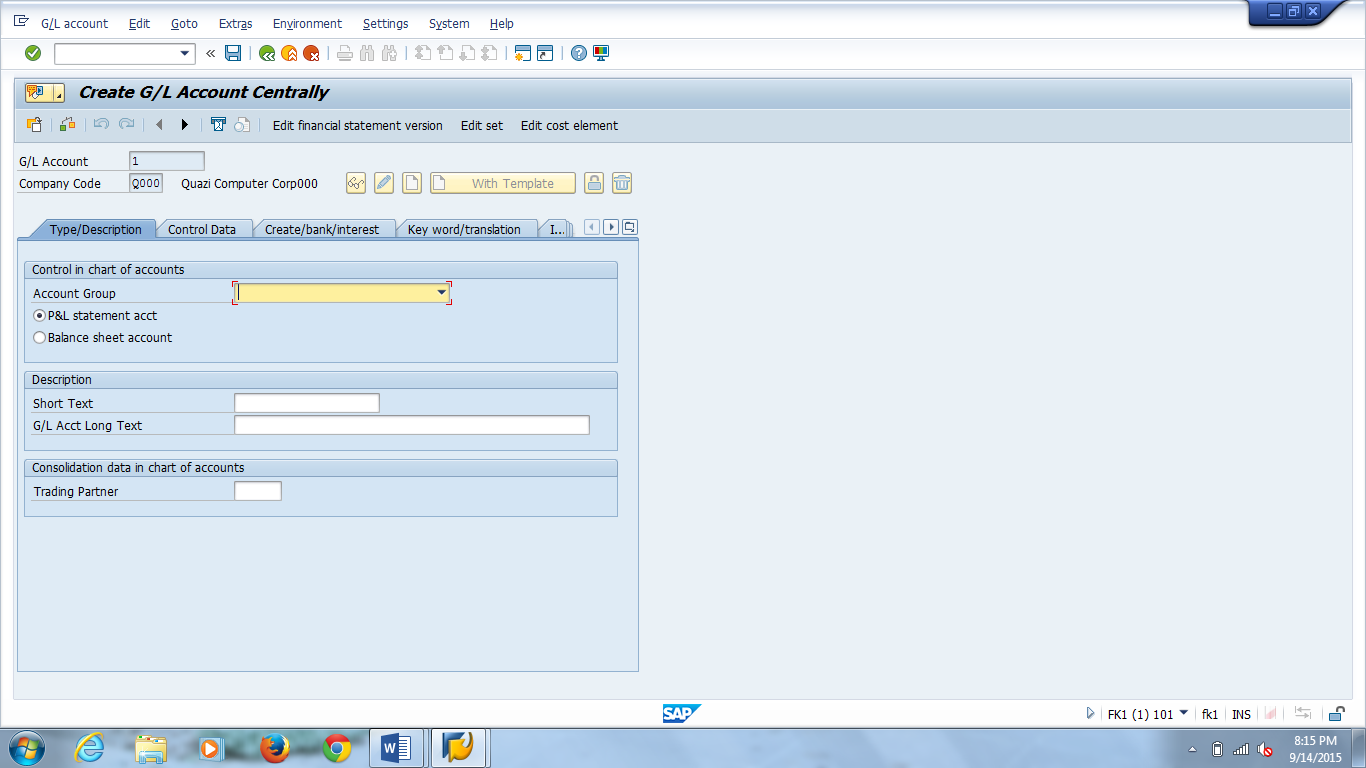 Back to SAP Easy Access
Menu
Back to SAP Easy Access
Menu
Enter the following information:
Customer: Stephanie’s Designs _ _ _ Value: ______________
| Material no. | Cust. Material |
| Your Cushion | SC1001 |
| Your Rocker | SC1002 |
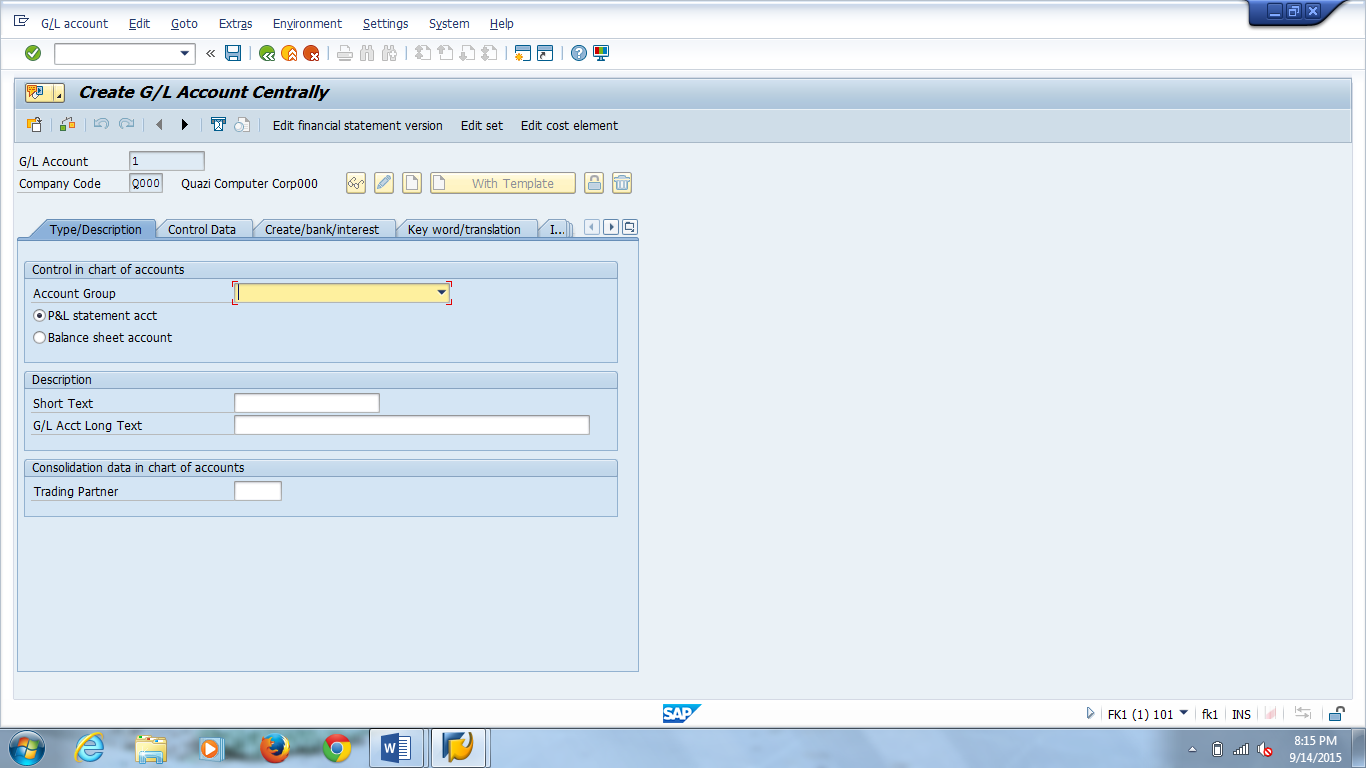 (ENTER)
(ENTER)(SAVE)
Logistics ⇒ Sales and Distribution ⇒ Master Data ⇒ Products ⇒ Item Proposal ⇒ Create
Item Proposal Type: Item Proposal Value: ______________
Item Proposal: leave blank
Description: 50 Rocker Pack_ _ _
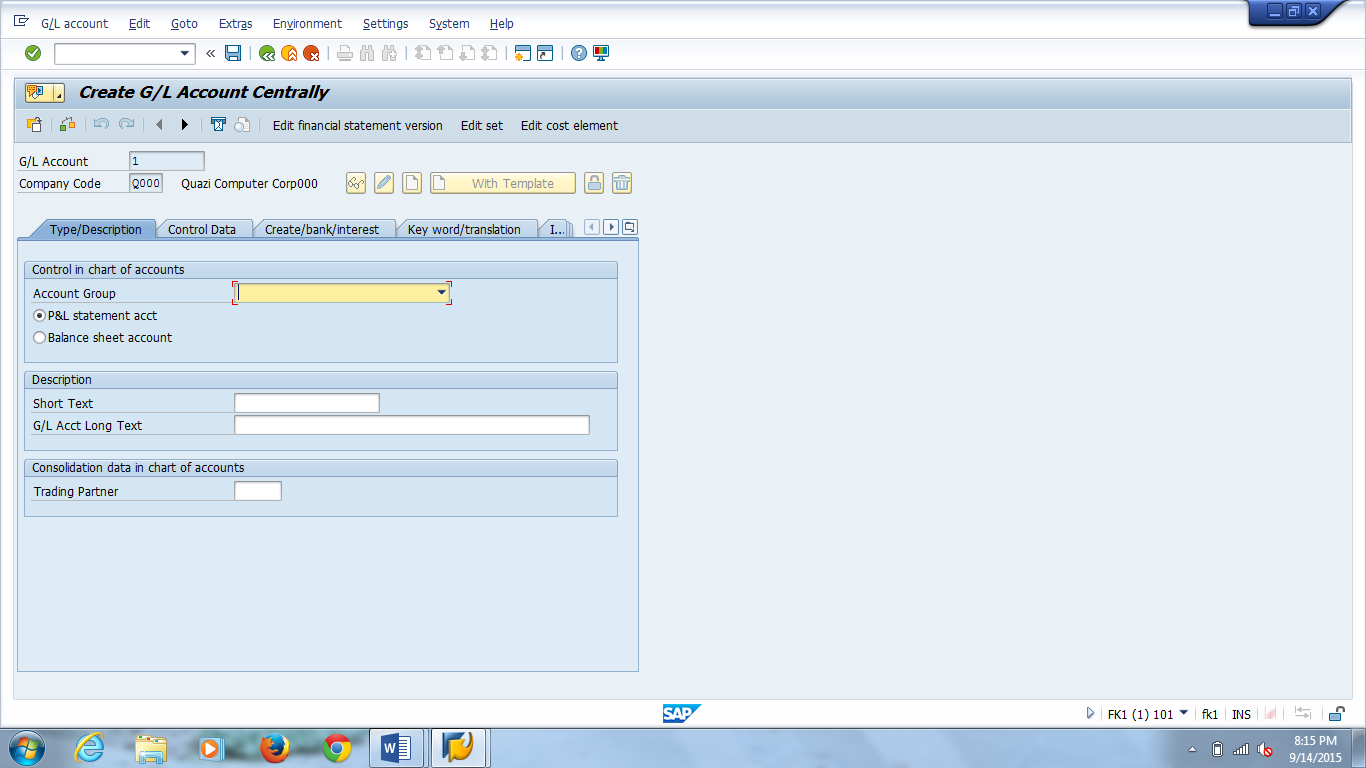 (ENTER)
(ENTER)(SAVE)
Now that the item proposal has been created, we can reference it in the master record of one or more customers. Whenever we ask for an item proposal in a sales order for a customer to whom it has been assigned, the system will default to the item proposal.
Logistics ⇒ Advanced Planning ⇒ Master Data ⇒ Resource ⇒ Processor ⇒ Maintain Business Partner
If required, select
Orders TAB:
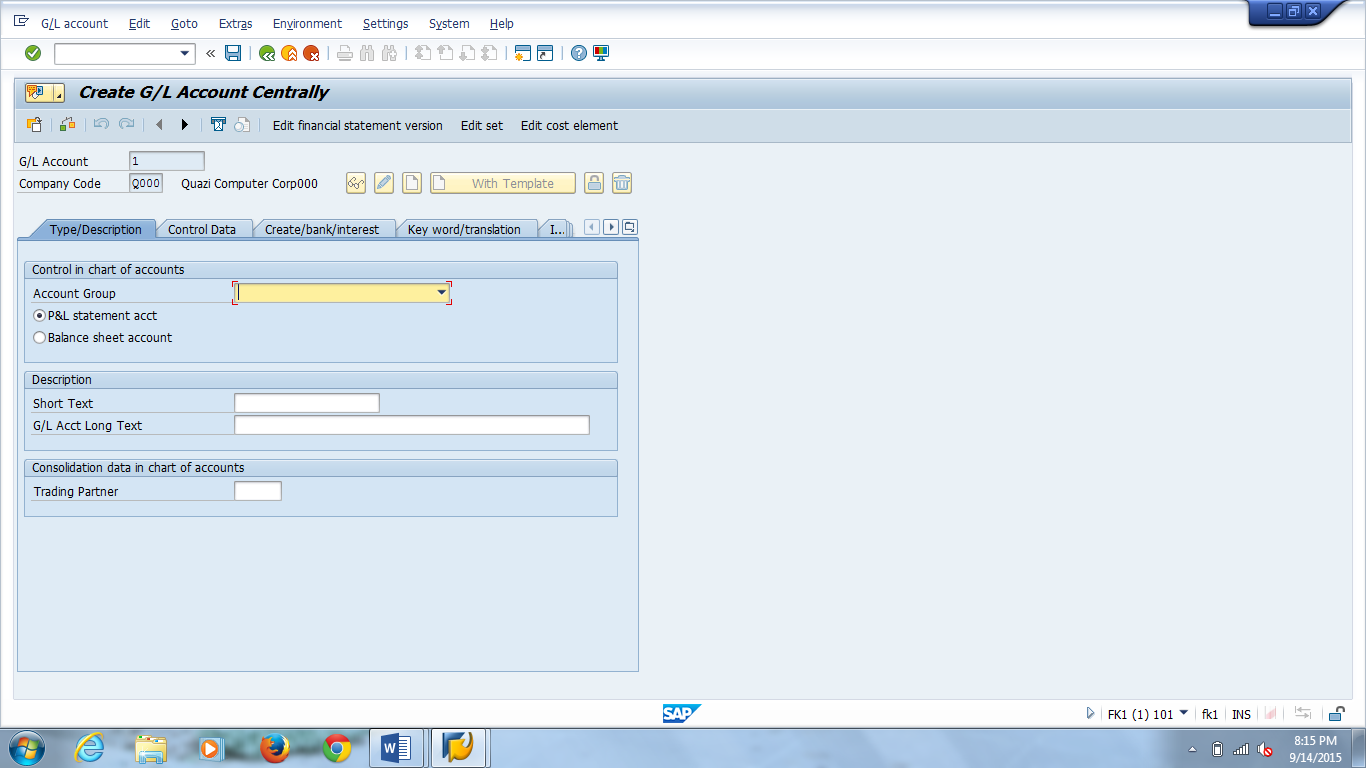 Back to SAP Easy Access
Menu
Back to SAP Easy Access
Menu
Inquiry Type: Enter the Inquiry value of IN
Sales Organization: C_ _ _
Sold-To Party: Sunny Porch Pastimes_ _ _ Value: ______________
Ship-To Party: Will automatically fill in later
Enter the following materials and order quantities:
| Material | Order Quantity |
|---|---|
| Your Rocker | 150 |
| Your Cushion | 100 |
Click
 (ENTER) and then
select an item by clicking the box to the left of an item
(ENTER) and then
select an item by clicking the box to the left of an item
Continued on next page
Environment⇒ Availability
Record the inquiry number ________________________
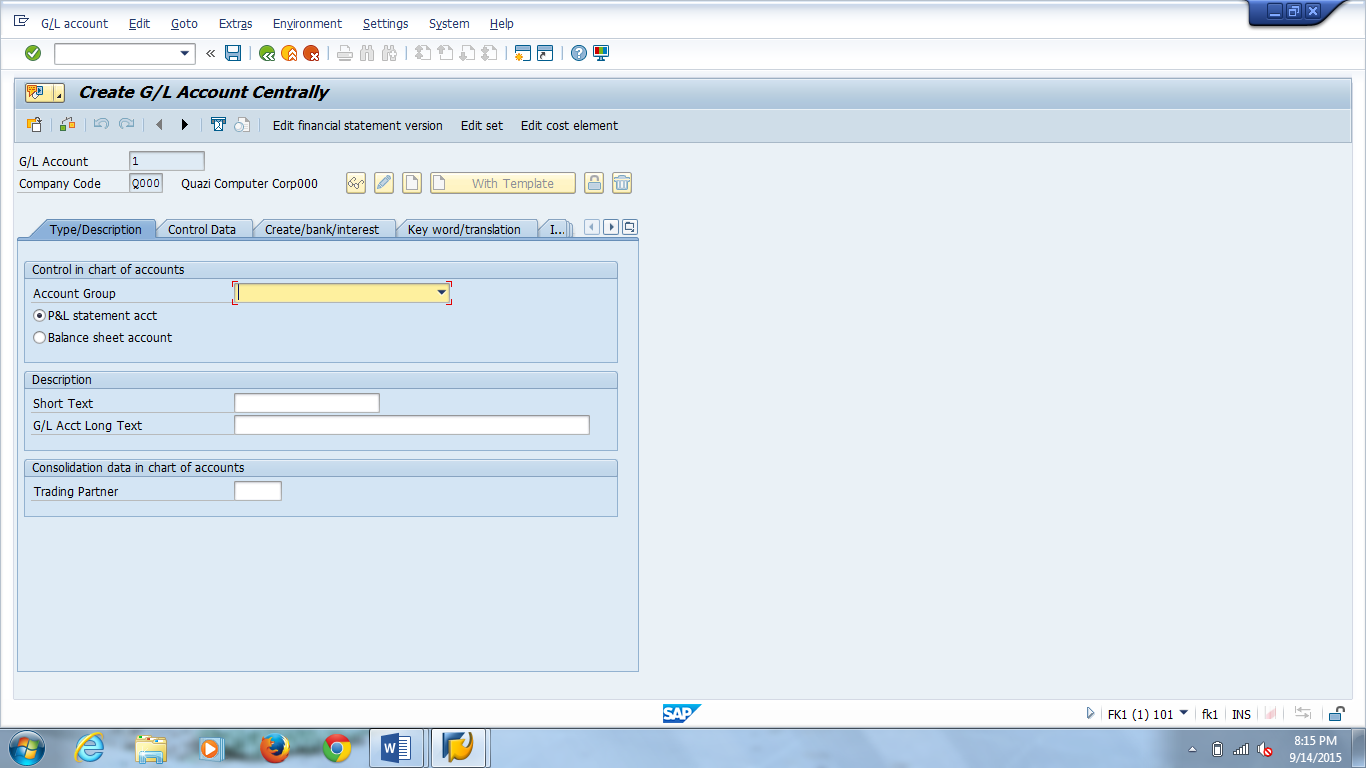 Back to SAP Easy Access
Menu
Back to SAP Easy Access
Menu
Logistics ⇒ Sales and Distribution ⇒ Sales ⇒ Order ⇒ Create
Order Type: OR
Inquiry TAB:
Enter the number of the Inquiry you just created
Item Overview TAB:
Select Cushion_ _ _ (Click the grey box to the left of the line item)
Select Rocker_ _ _
Click on the item conditions and note the pricing, which should agree to the price in SD06
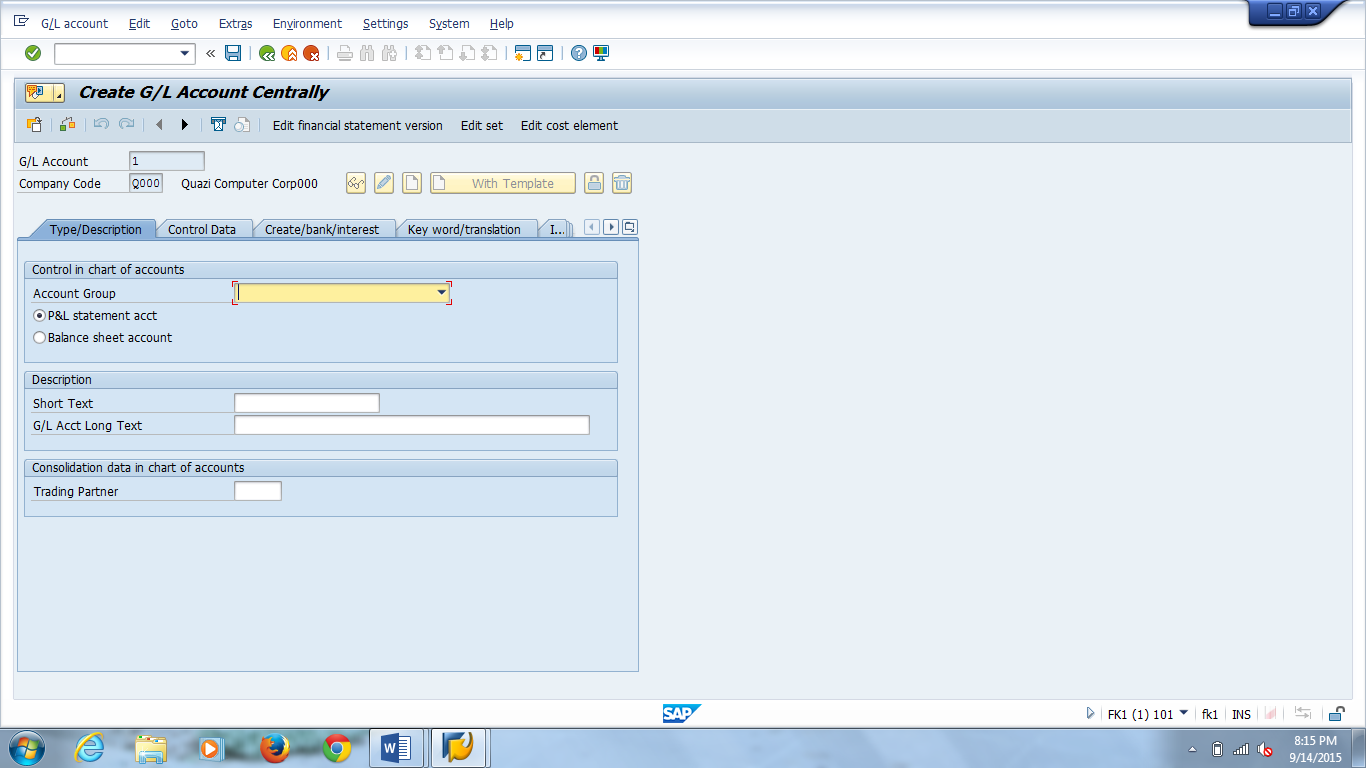 (ENTER)
(ENTER)
Continued on next page
Record the sales order number (referred to as “standard order” at bottom of screen) ________________________
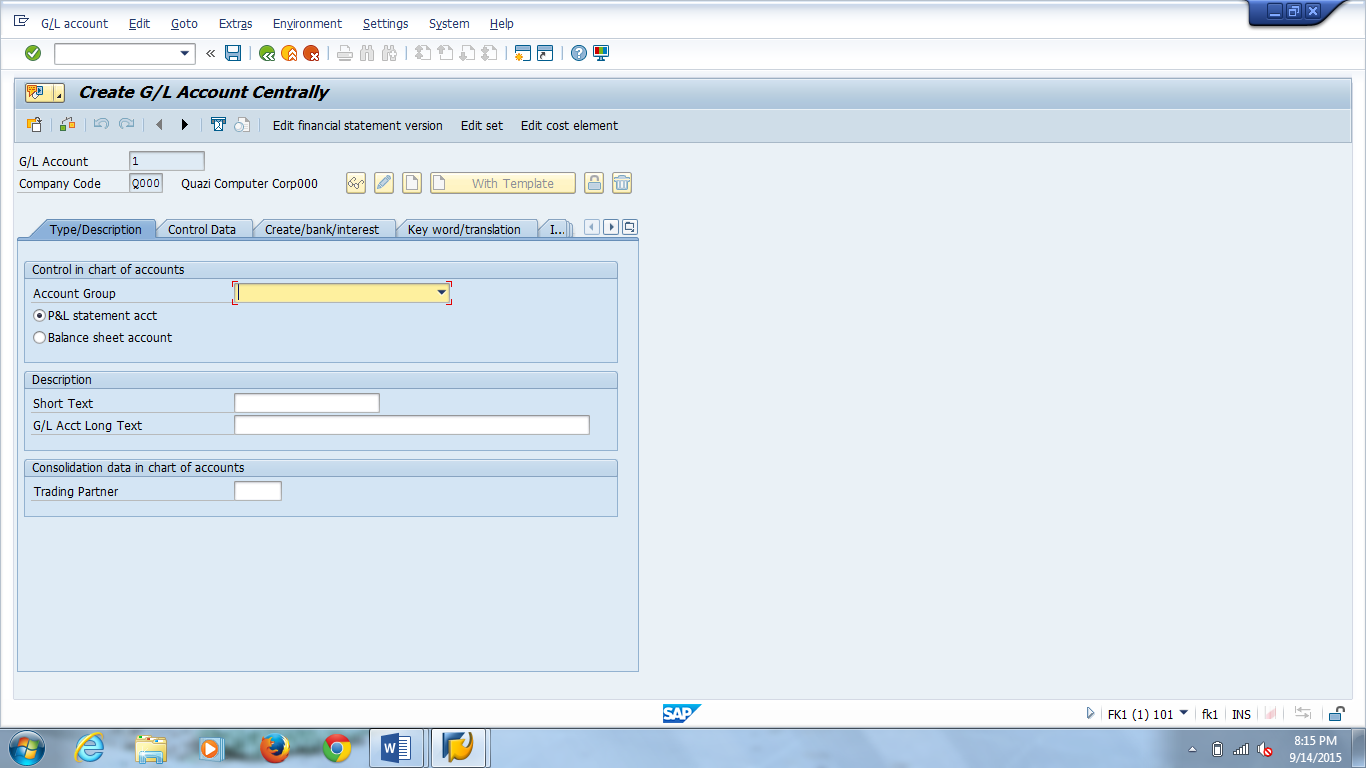 Back to SAP Easy Access
Menu
Back to SAP Easy Access
Menu
Keep the new session open at the end of the exercise for later use!
Logistics ⇒ Materials Management ⇒ Inventory Management ⇒ Environment ⇒ Stock ⇒ Stock Overview
Note the quantity in the “Unrestricted use” column
Double click on the line with your Plant’s stock
Exit the detailed display window
Go to your other session, leaving this session open (Alt + Tab)
Enter the following information:
Shipping point: Classic Rockers Shipping Point Value: ______________
Complete the following for each line item on the outbound delivery (you will perform this step twice)
Click on the line item (box to left of line item number to select entire row)
Rocker_ _ _ Shipping
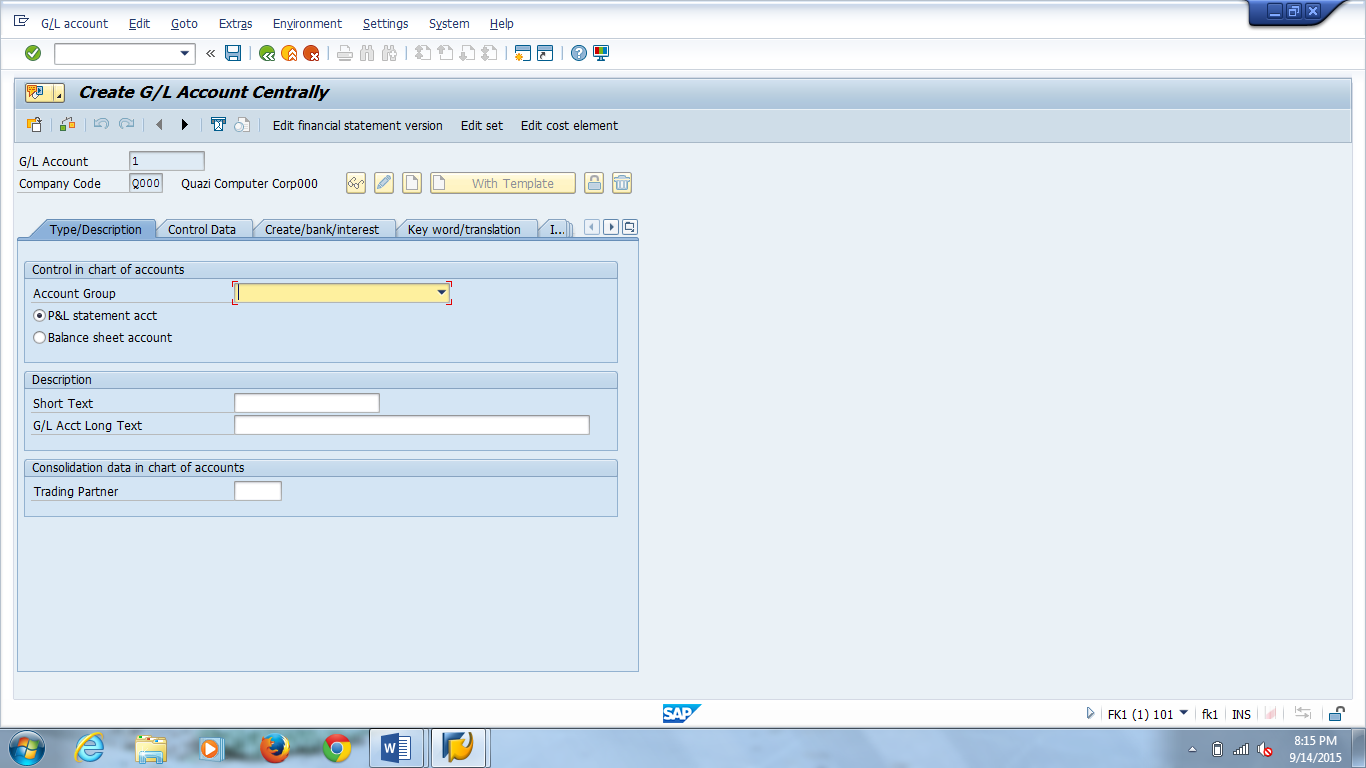 (BACK AFTER EACH PICKING TAB
ENTRY)
(BACK AFTER EACH PICKING TAB
ENTRY)
Continued on next page
To recheck the stock status (see previous exercise):
Double click on the line with your Plant’s stock.
A pop-up window is displayed showing the details of the inventory by stock type at the plant
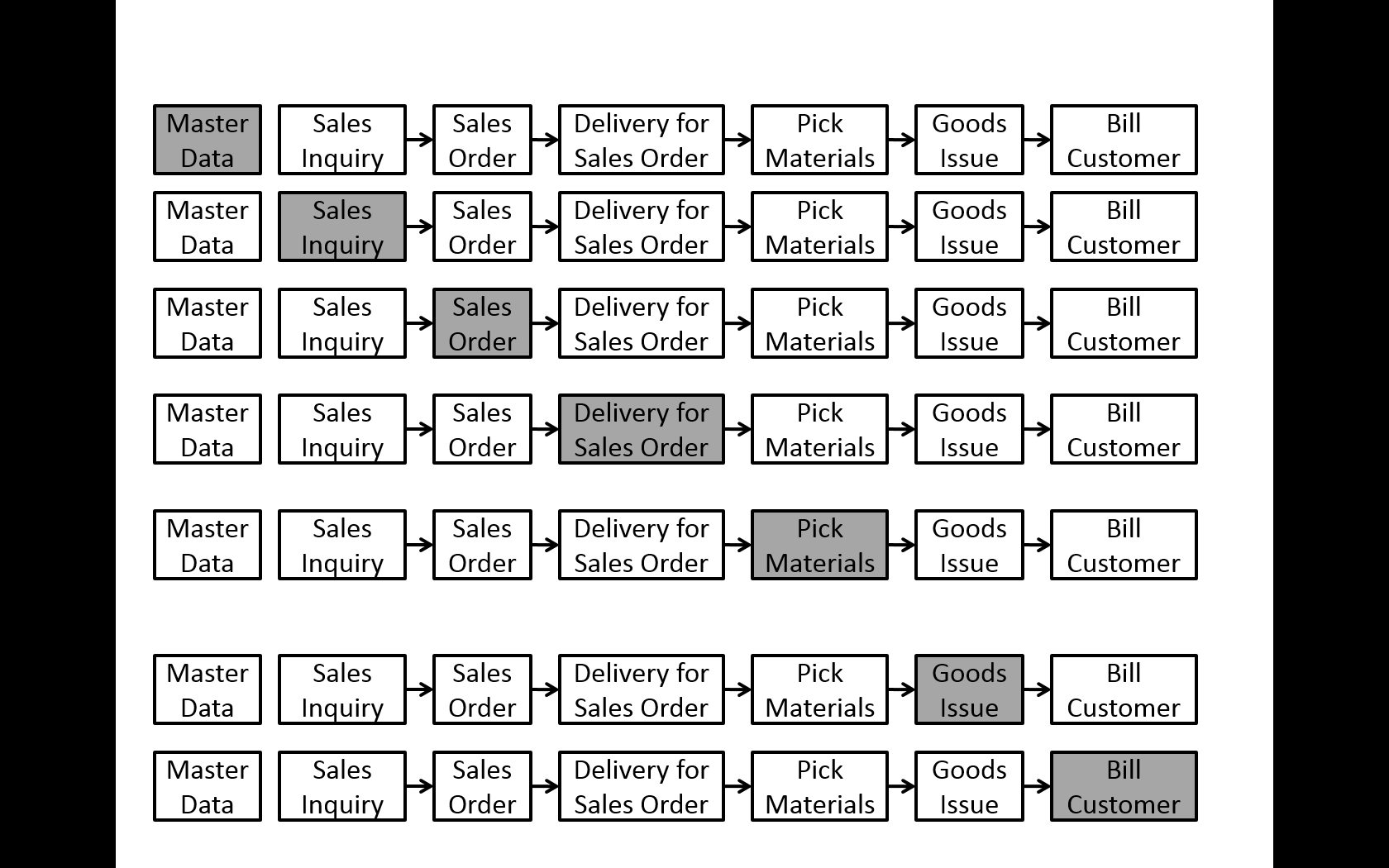
Exercise SD15: Picking materials on delivery note
The material delivery quantity is proposed
Enter Picked quantity to match the proposed delivery quantity
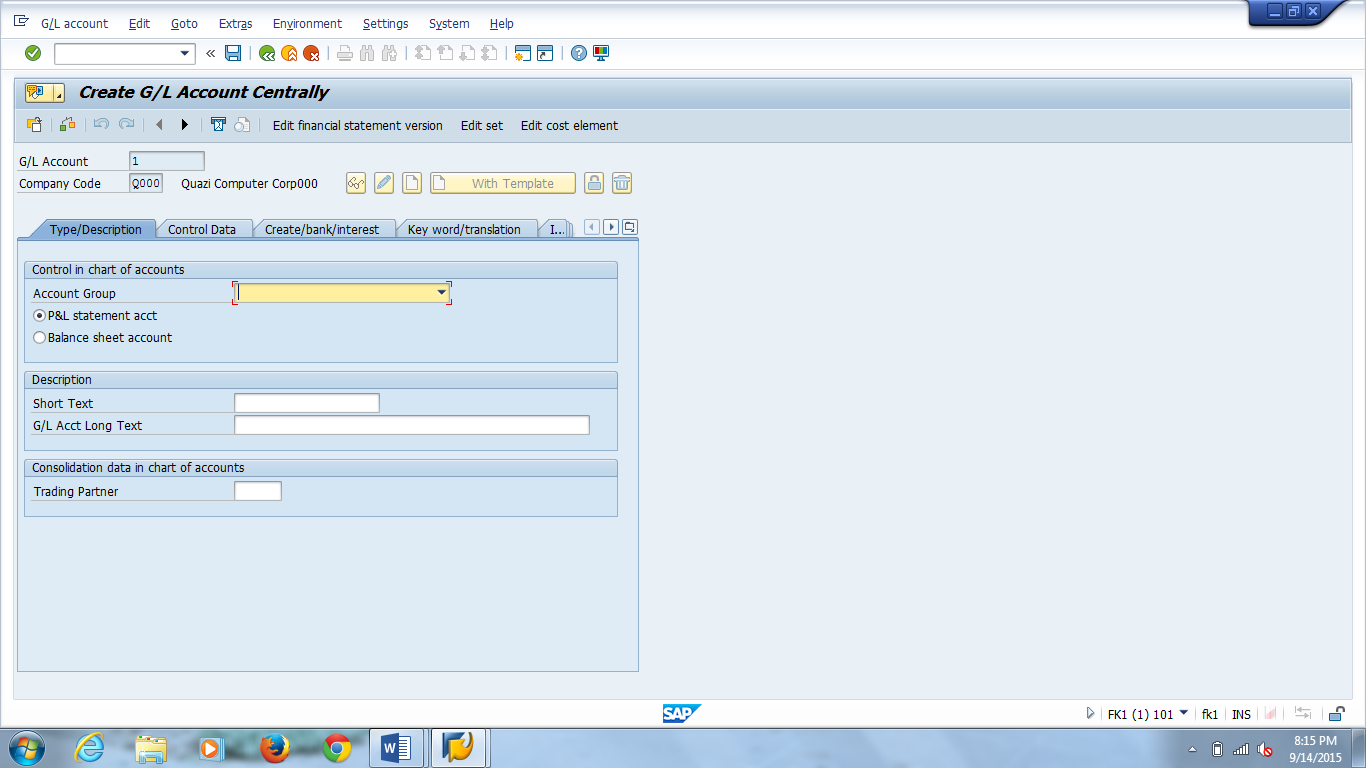 Back to SAP Easy Access
Menu
Back to SAP Easy Access
Menu
Go to your other session (Alt + Tab)
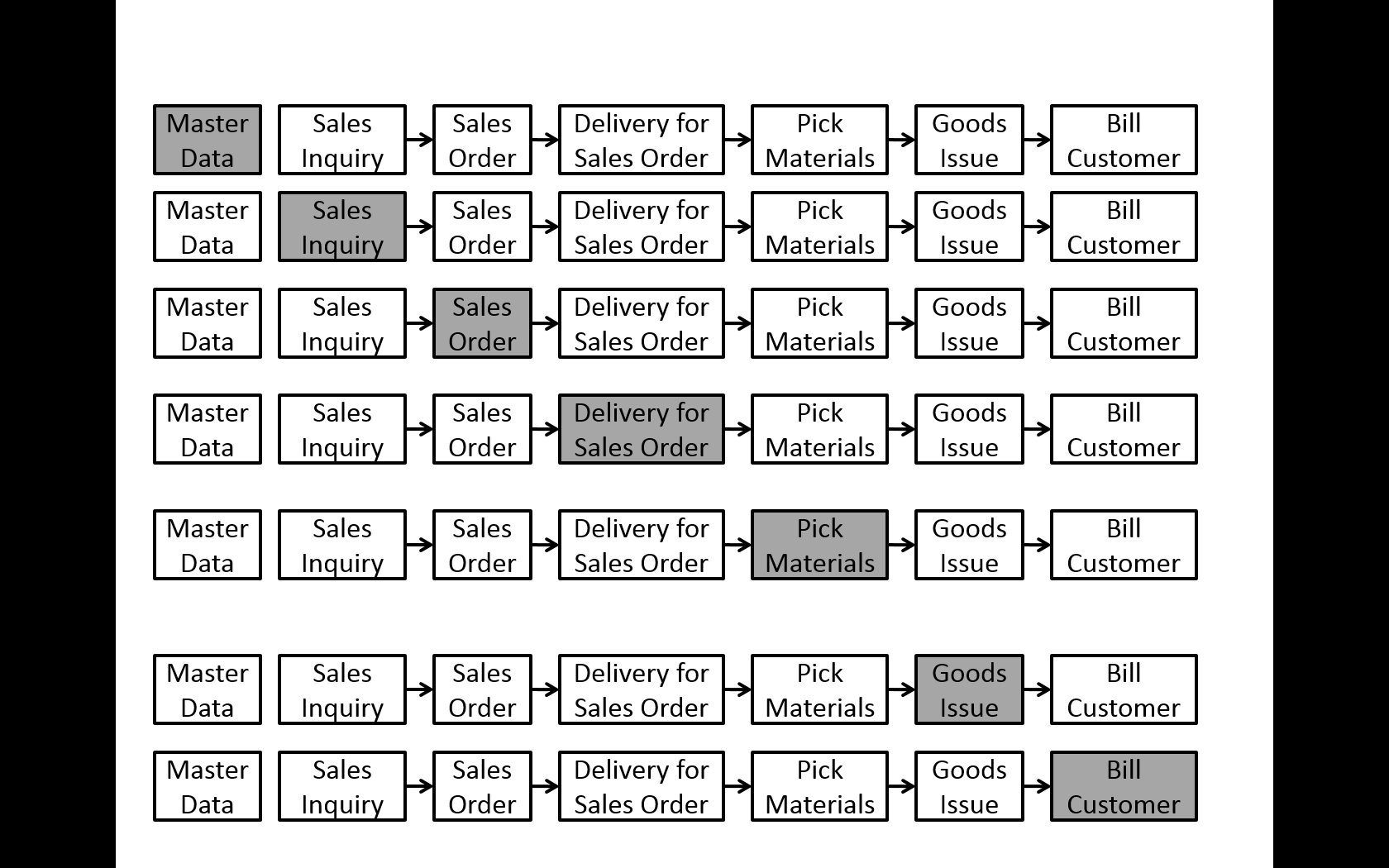
Exercise SD16: Post goods issue
The system returns a message indicating your outbound delivery has been saved (i.e., a posting of the issuance of goods has been made)
To recheck the stock status (see earlier exercises):
Note that the quantity in “Unrestricted use” has decreased, consistent with that on the Stock Overview: Basic List main screen. Also note that the quantity in “Schd. for delivery” is now zero.
Close the pop-up screen and
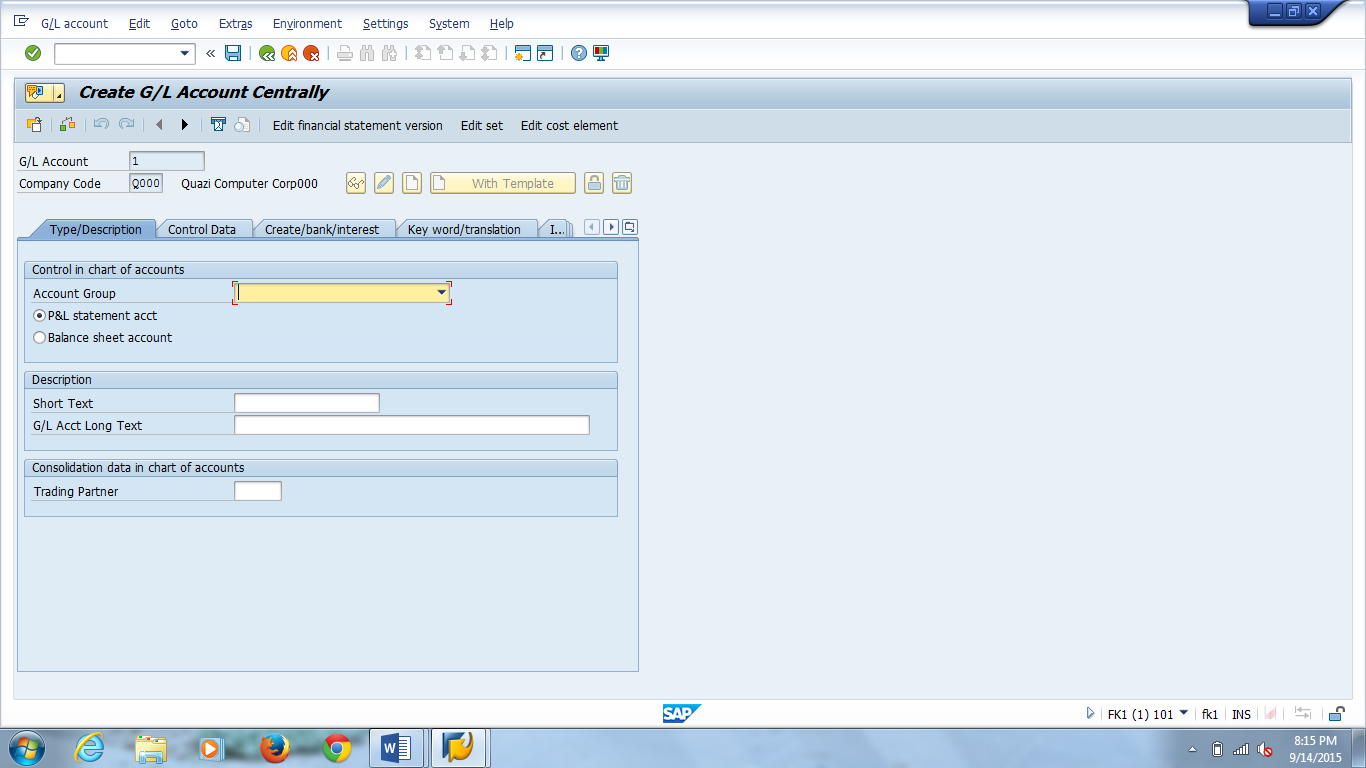 until you have closed out
your second session
until you have closed out
your second session
Once the issuance of goods has been posted, you can bill your customer for those goods.
Logistics ⇒ Sales and Distribution ⇒ Billing ⇒ Billing Document ⇒ Create
(SAVE)
The billing document number is displayed at the bottom of the screen
SAP allows us to see a whole transaction process from beginning to end (i.e., audit trail). For instance, we have created an order with reference to an inquiry, created a delivery for the order, posted the issuance of goods from the delivery and then billed for the goods delivered and issued. To examine this flow, any one of the document numbers can be referenced, and the document flow will show an audit trail of all documents tied to that number.
Logistics ⇒ Sales and Distribution ⇒ Sales ⇒ Inquiry ⇒ Display
PRINT THE SCREEN (IF REQUIRED BY YOUR INSTRUCTOR)
Continued on next page
Select to view the data entry view postings for this goods movement
Note the two negative (credit) amounts to Inventory (Finished and Trading) that combine to $12,367.50. Likewise, there are two positive (debit) amounts to Cost of Goods Sold that combine to $12,367.50. $10,867.50 is the cost of Rocker sold, while $1,500.00 is the cost of Cushion sold.
Select to view the data entry view postings for the invoicing
Select to view the data entry view postings
Click to display the document header. You should see key data such as the user who entered this document, the reference (purchase order), document, posting and entry dates, and posting period. Your screen should look like that shown on the next page.
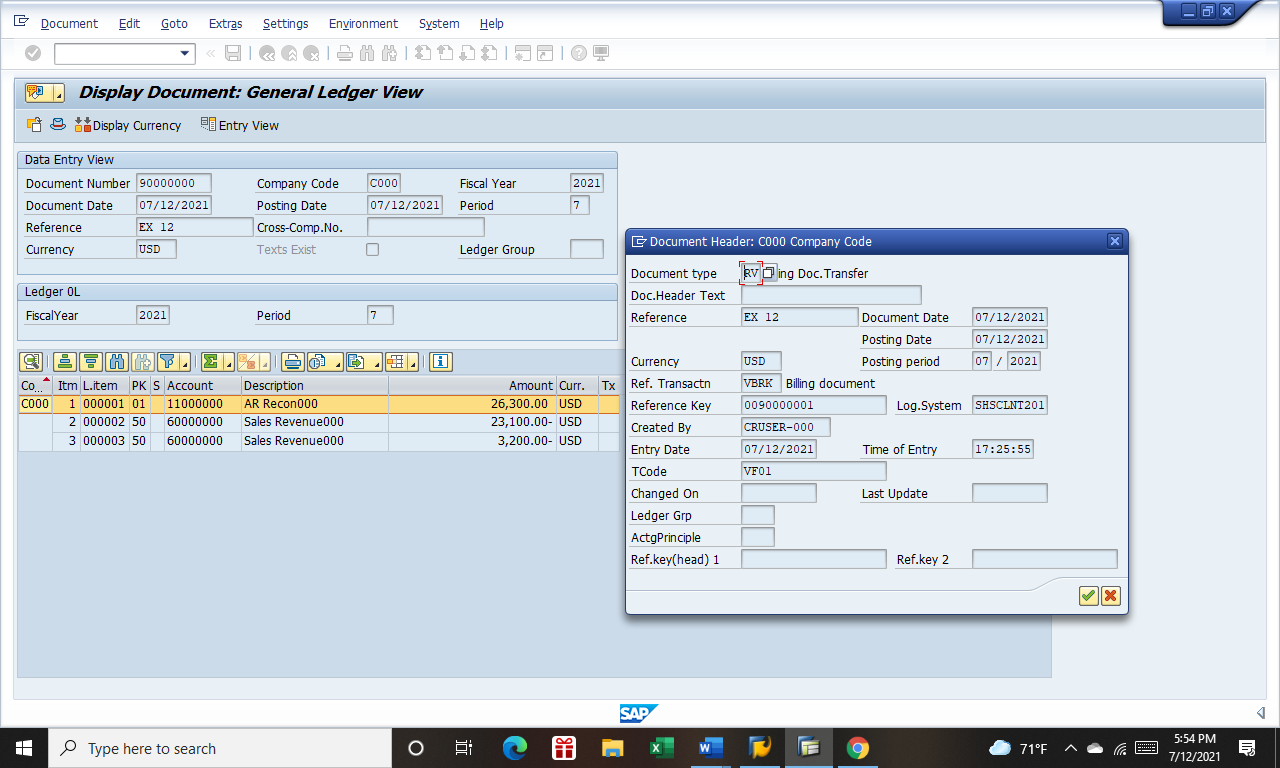
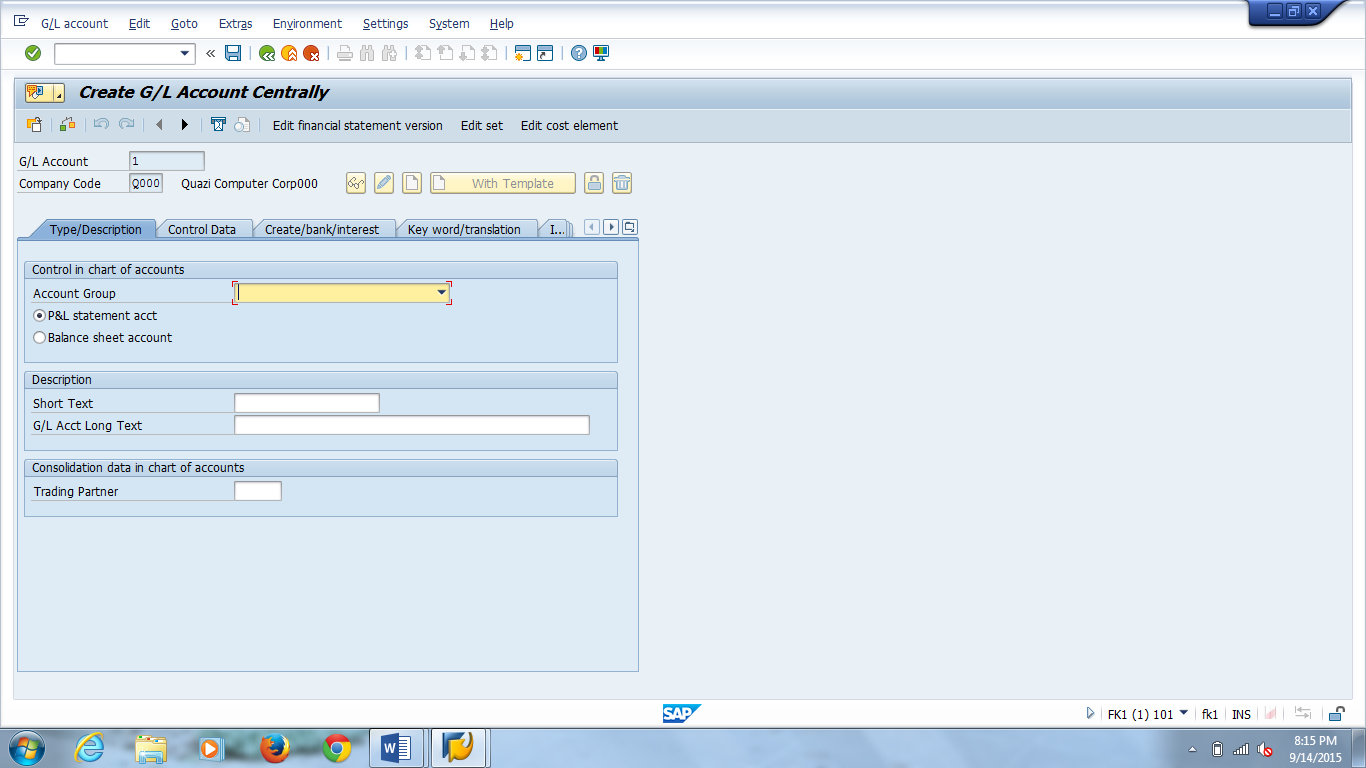 Back twice to SAP Easy Access
Menu
Back twice to SAP Easy Access
Menu
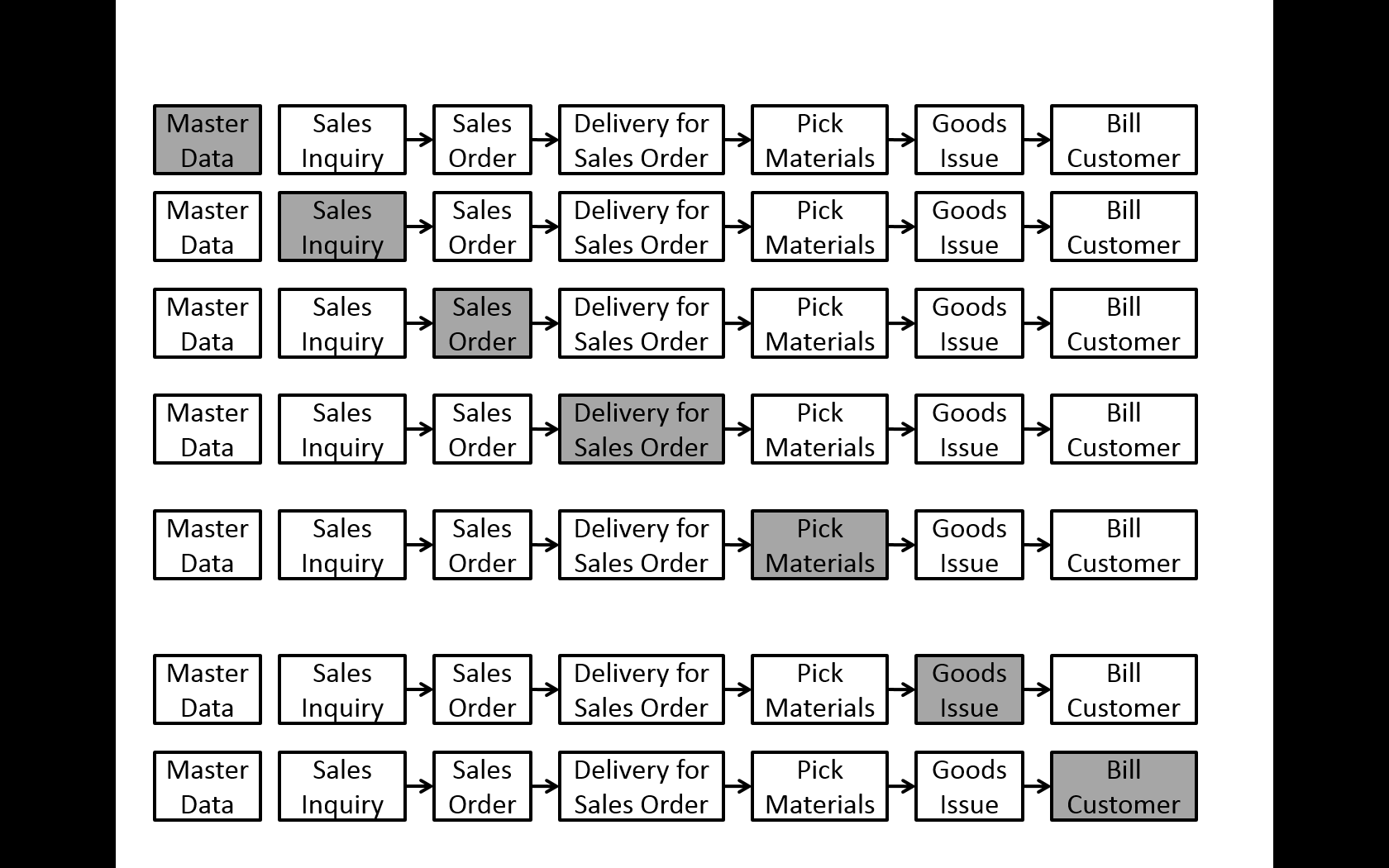
Sales Organization: C_ _ _
Distribution Channel: Direct Value: ______________
Ship-To Party: leave blank
Cust. Reference: Enter this exercise number (EX 19)
In the pop-up window, the system copies the number of the item proposal for this customer
Select

Continued on next page
Review the pricing options:
(SAVE)
Record the sales order number ___________________________
Logistics ⇒ Sales and Distribution ⇒ Sales ⇒ Order ⇒ Create
Order Type: Enter the Standard Order value of OR
Enter the sold-to party number for Stephanie’s Designs_ _ _
Enter a purchase order number - the number of this exercise (EX 20)
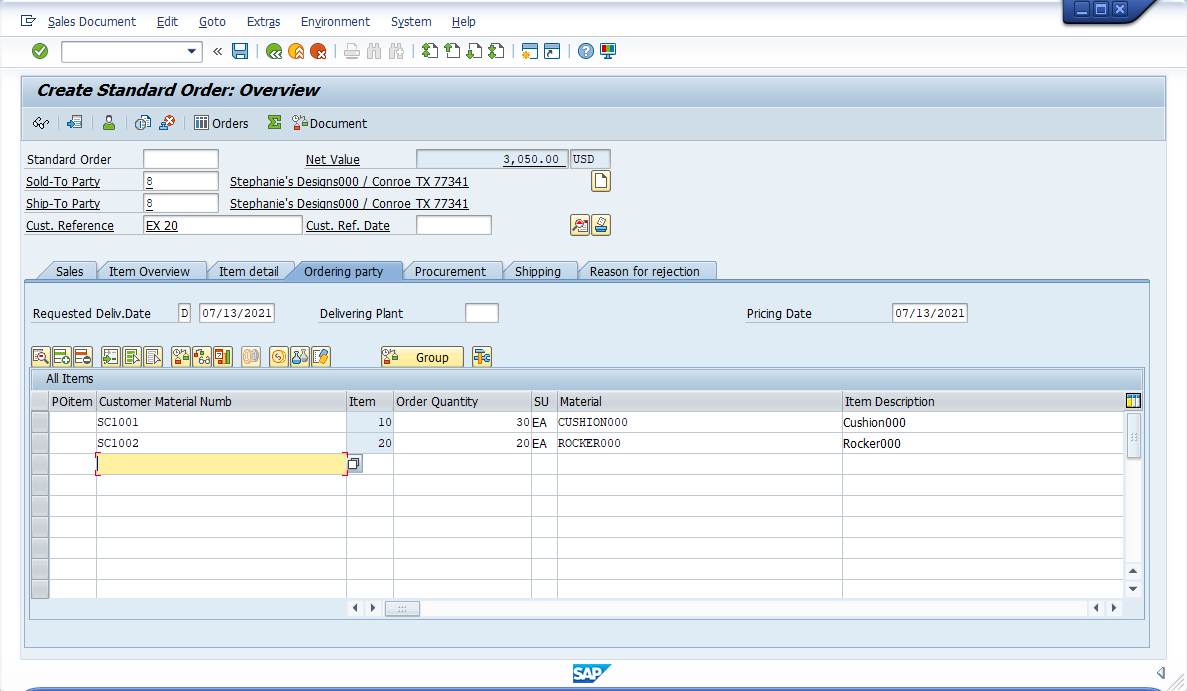
PRINT THE SCREEN (IF REQUIRED BY YOUR INSTRUCTOR)
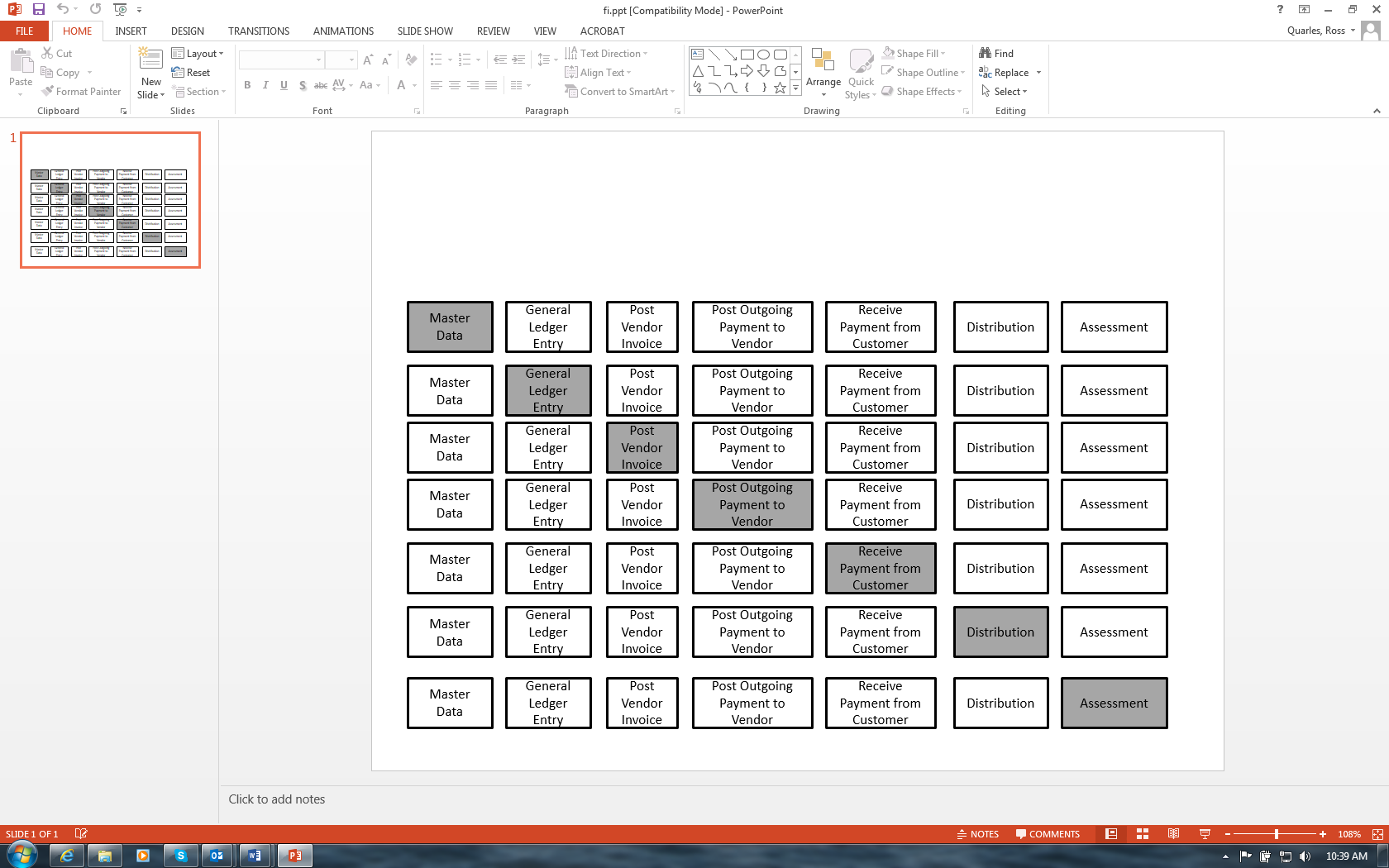
EXERCISE FI/CO01: Create General Ledger B/S Account
Company Code: C_ _ _
(CREATE)
G/L Acct Long Text: Bank_ _ _
Control Data TAB:
Field status group: General Balance Sheet Accounts Value: ______________
(SAVE)
Accounting ⇒ Financial Accounting ⇒ General Ledger ⇒ Master Records ⇒ G/L Accounts ⇒ Individual Processing ⇒ Centrally
G/L Account: 31000_ _ _
Account Group: Balance sheet accounts
Short Text: GR/IR-_ _ _
Tax Category: All tax types allowed Value: ______________
Posting without tax allowed:
Post Automatically Only:
(SAVE)
Accounting ⇒ Financial Accounting ⇒ General Ledger ⇒ Master Records ⇒ G/L Accounts ⇒ Individual Processing ⇒ Centrally
G/L Account: 78000_ _ _
(ENTER)
Change the Short Text description to: Rent Expense_ _ _
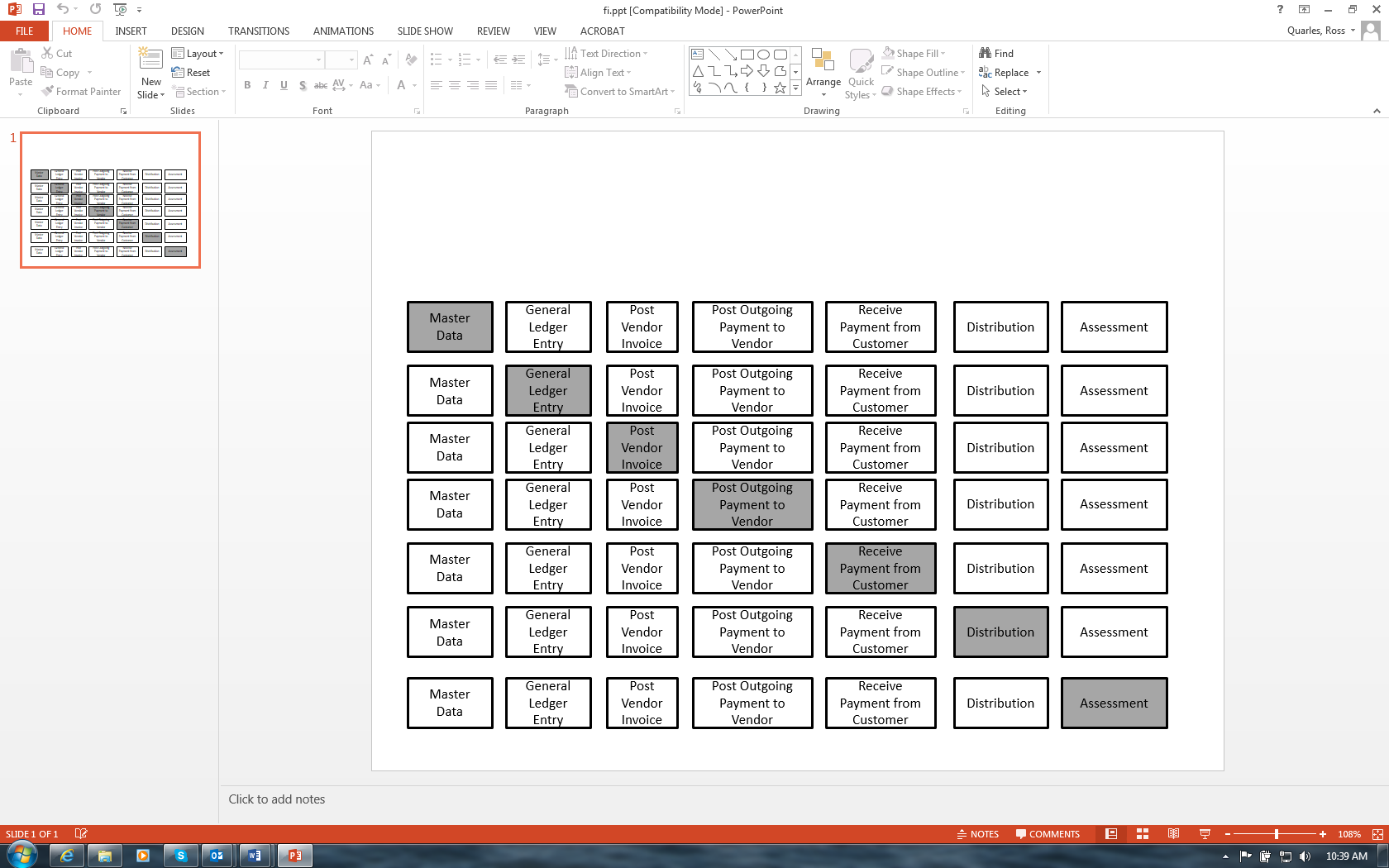
EXERCISE FI/CO04: Create UTILITIES P/L AccounT
Click
G/L Account: 70000000
Change the Short Text description to: Utilities_ _ _
Change the G/L Acct Long Text description to: Utilities – Your Last Name
EXERCISE FI/CO05: Run GL Accounts Report
This report will give you a summary of all accounts assigned to your company code.
Information Systems ⇒ General Report Selection ⇒ Financial Accounting ⇒ General Ledger Reports ⇒ Master Data ⇒ G/L Account List ⇒ SAP Minimal Variant
Continued on next page
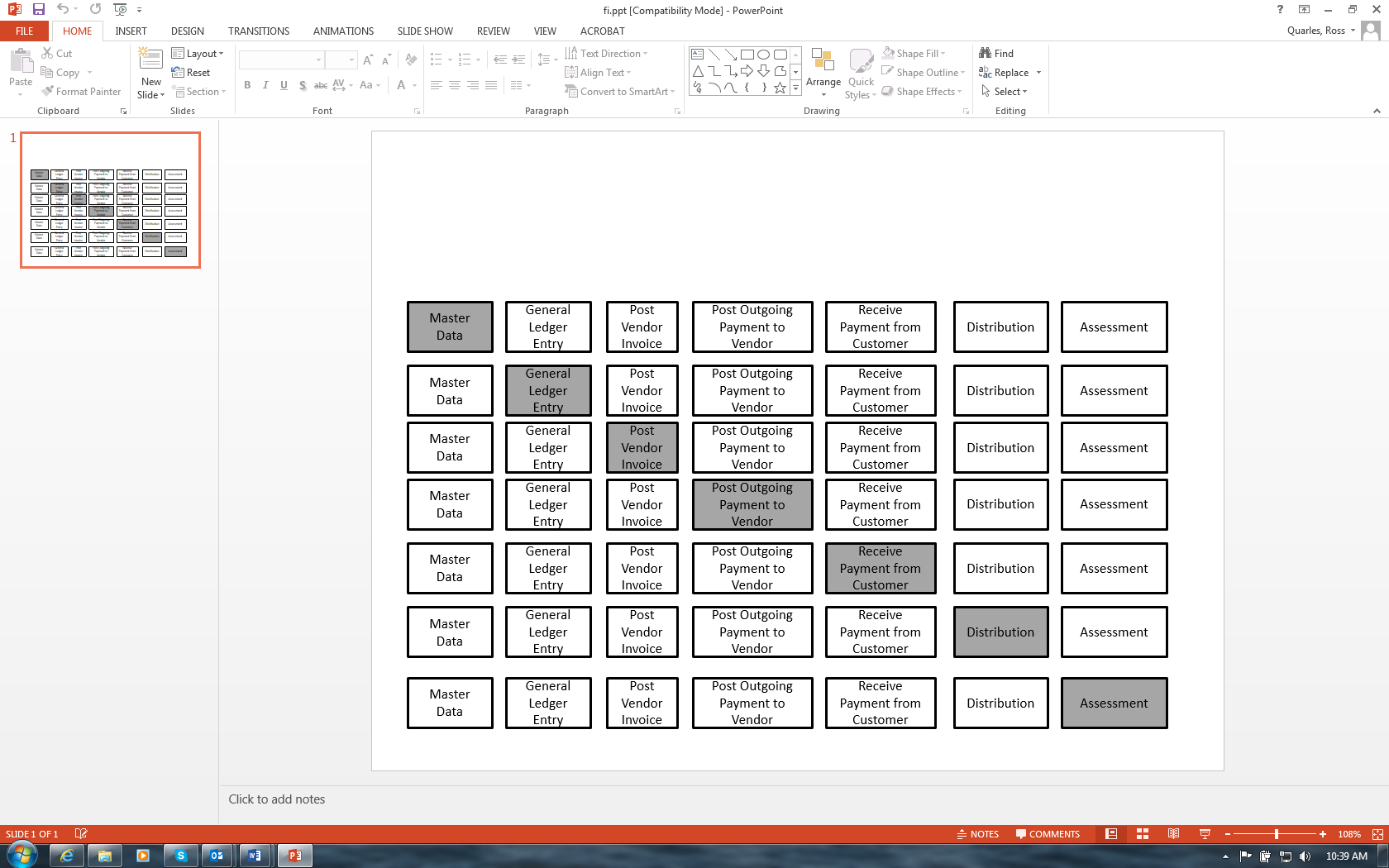
EXERCISE FI/CO06: Create Vendor Master Record
Create in BP role: Business Partner (Gen.)
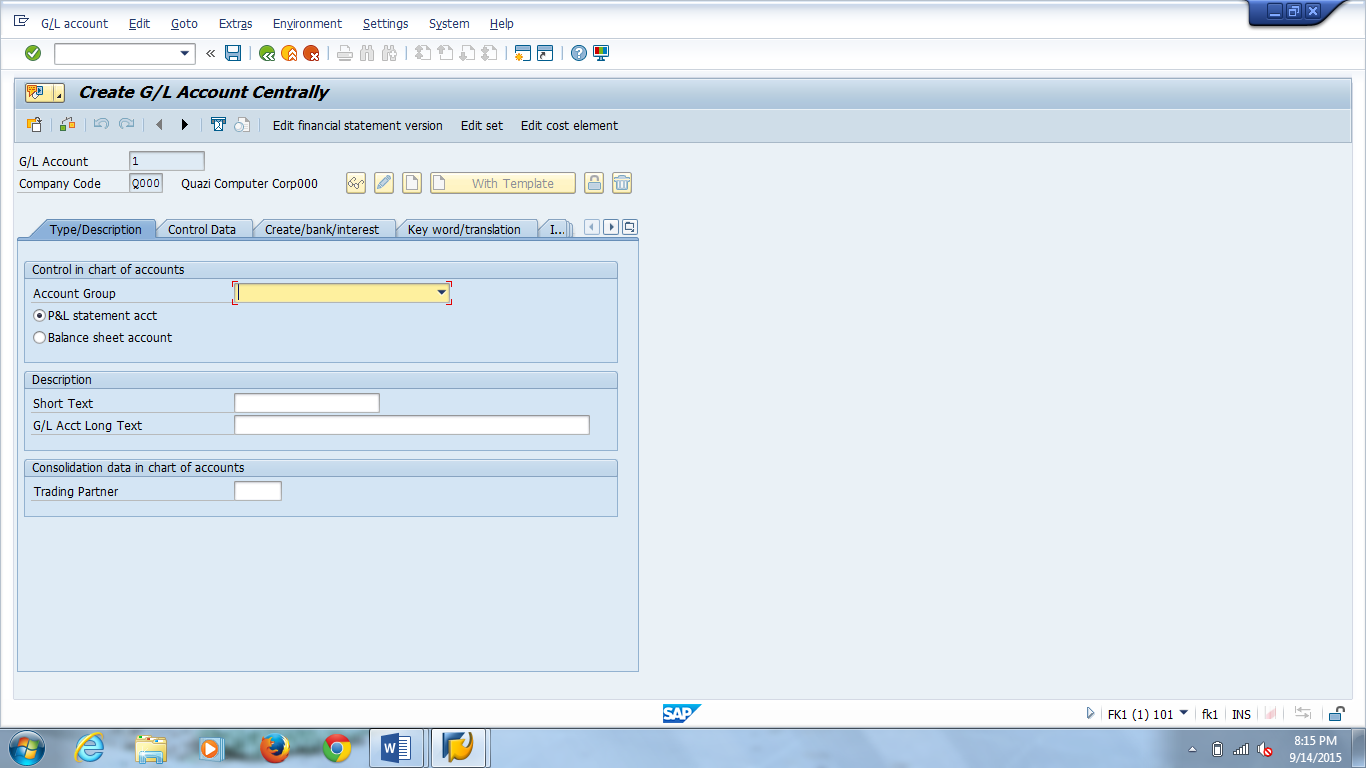 (ENTER)
(ENTER)
City: ______________ (your own creation)
Country: USA Value: ______________
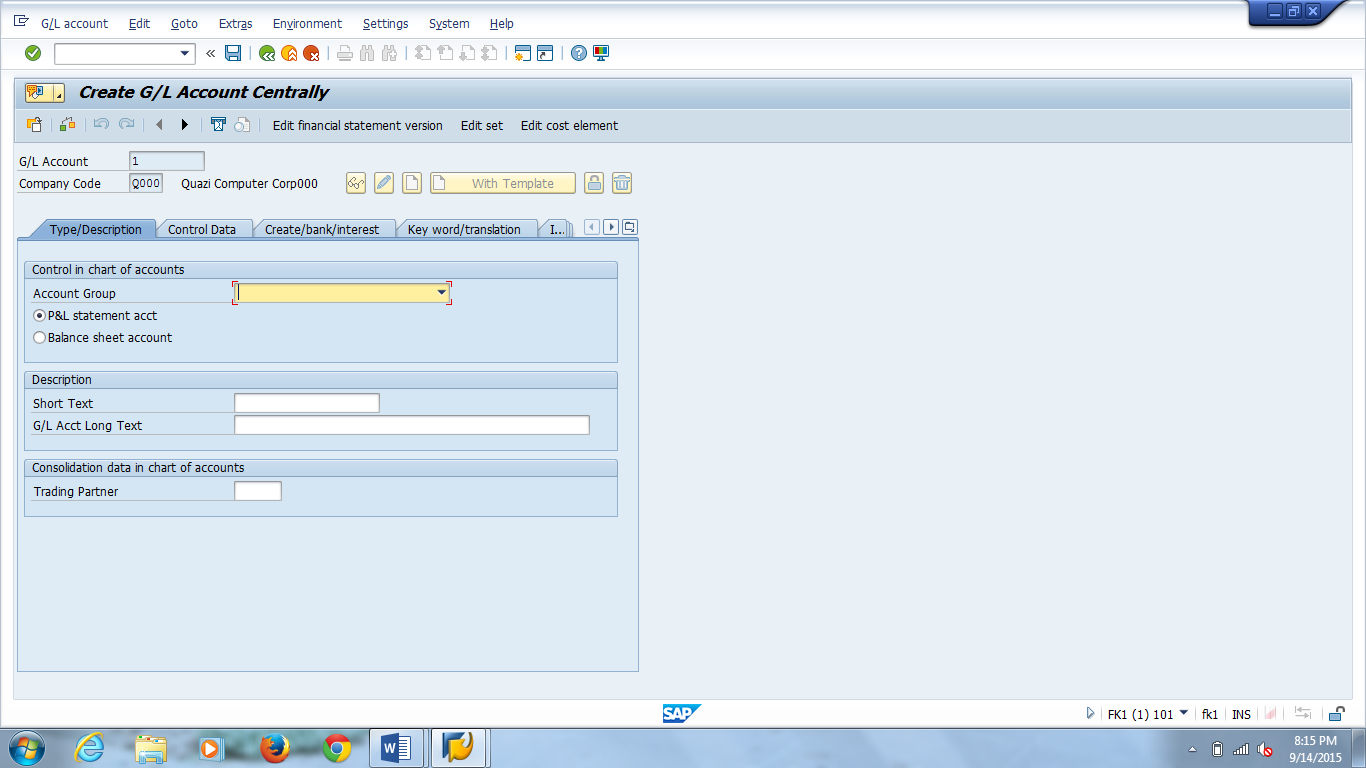 (ENTER)
(ENTER)(SAVE)
Reconciliation acct: Your Accounts Payable Recon. Account Value: ______________
Vendor: Payment Transactions TAB:
Record the Vendor Account no.___________________________
Back to SAP Easy Access Menu
Document Date: Today’s date Value: ______________
Currency: USD
Cost center: Administration Value: ______________
On Next Line Enter:
Note at the top right of the screen that total debits equal total credits
Continued on next page
Back to SAP Easy Access menu – select ‘Yes’ to the pop-up message about “Data will be lost.”
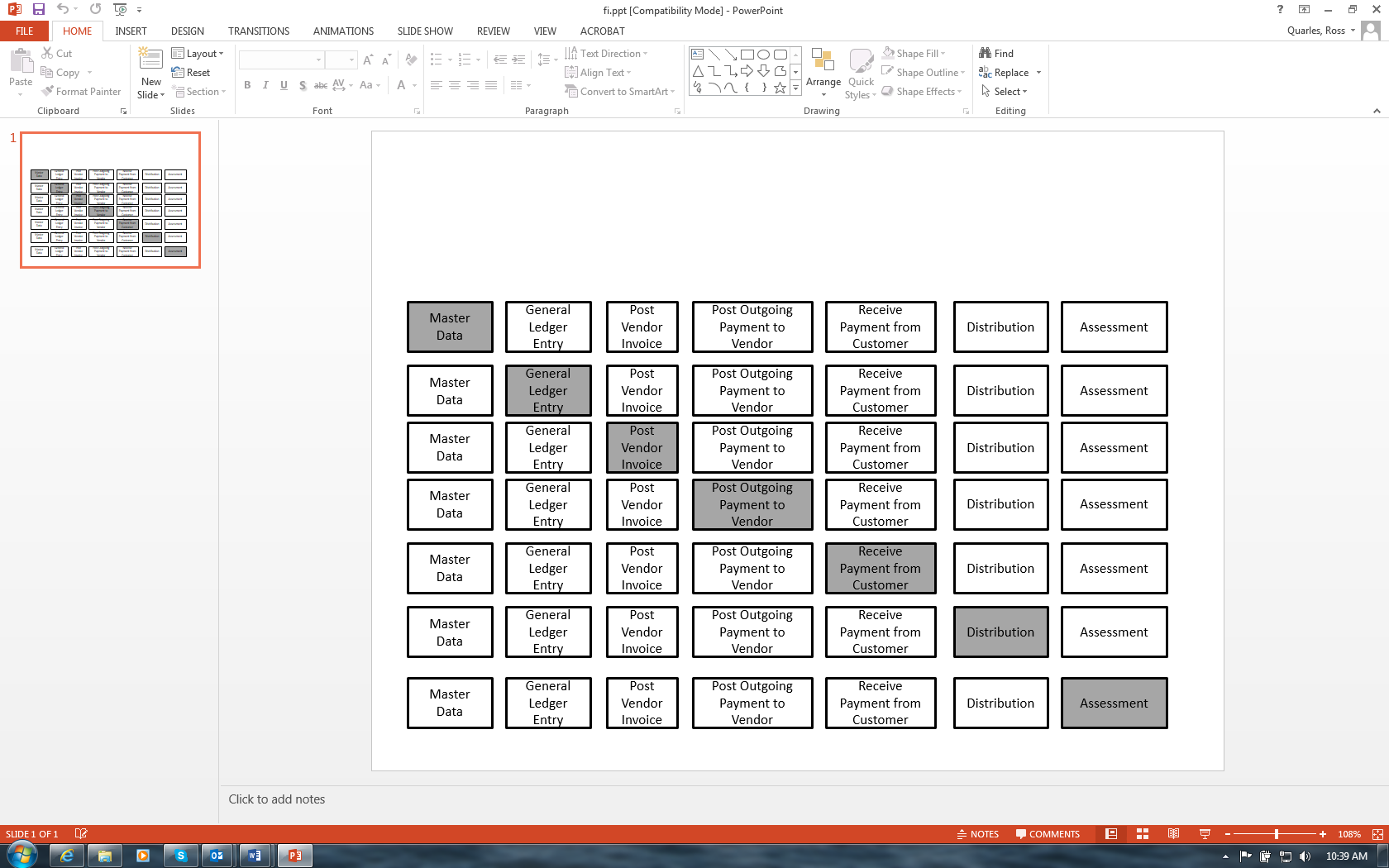
Company Code: C_ _ _
Fiscal Year: Current year Value: ______________
Double-click on the line item of the current period. The resulting screen displays the G/L View, with a reference to your document number from FI/CO07.
Double-click on the document number. The resulting pop-up screen displays key aspects of the transaction. Scroll to the bottom to note your user name as the one who entered the transaction.
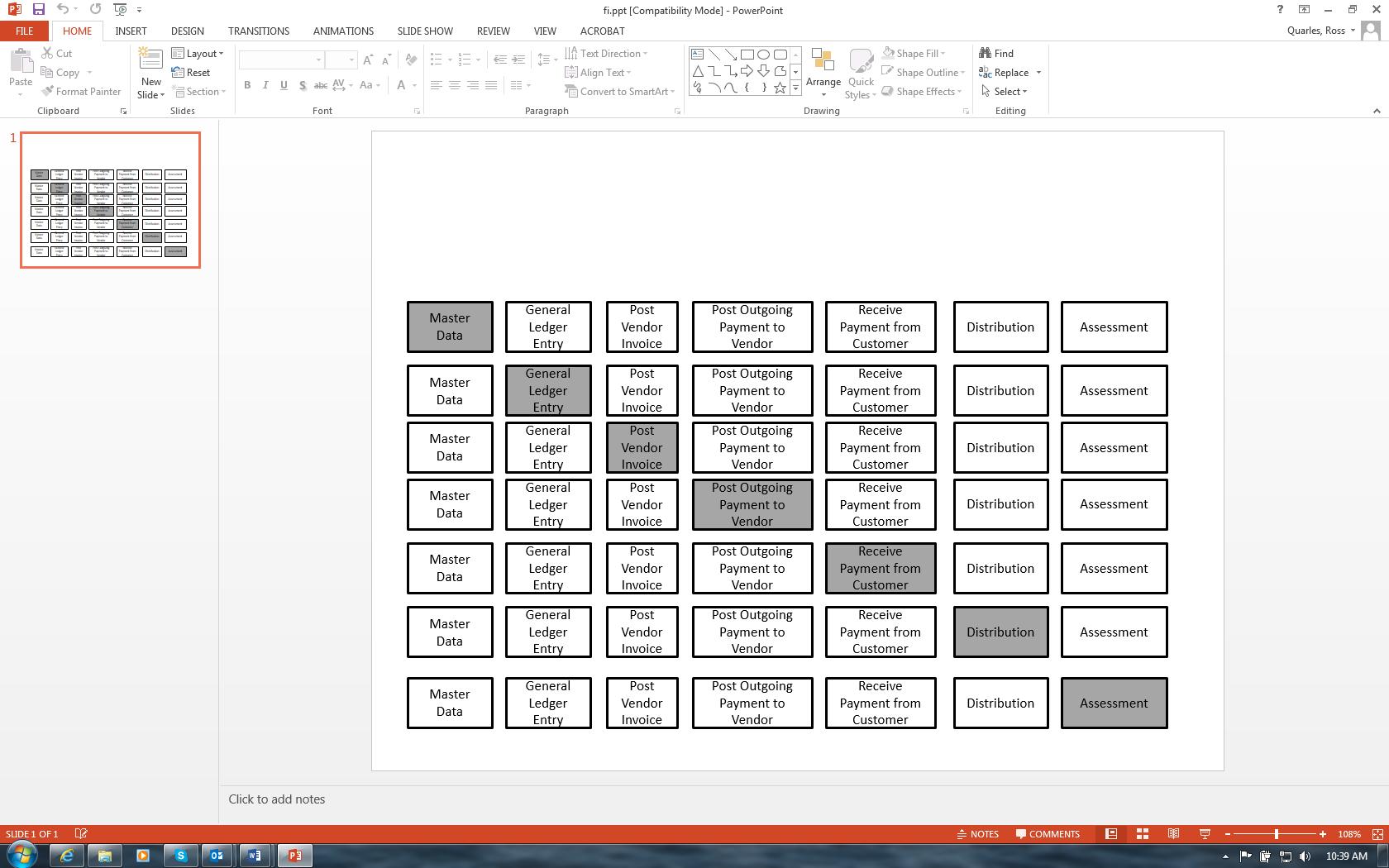
Invoice date: Today’s date Value: ______________
Amount: 350
Cost center: Administration Value: ______________
(ENTER)
(SAVE) (Do NOT use either of these buttons )
Record the document no._________________________________
EXERCISE FI/CO10: Display Account Balances (and/or Line Items)
Accounting ⇒ Financial Accounting ⇒ General Ledger ⇒ Account ⇒
(EXECUTE)
Double-click on the line item of the current period. The resulting screen displays the G/L View, with a reference to your document number from FI/CO09.
Vendor: Ross’ Rockin Rentals_ _ _ Value: ______________
Company code: C_ _ _
Note the document number on your screen. It is the same as that noted in step 4 of this exercise, as well as that noted in FI/CO09. You can click on the line and find out more information about the document, such as the user who recorded it. The current screen shows the accounts payable side of the entry from FI/CO09 while the first session shows the rent expense side of the entry.
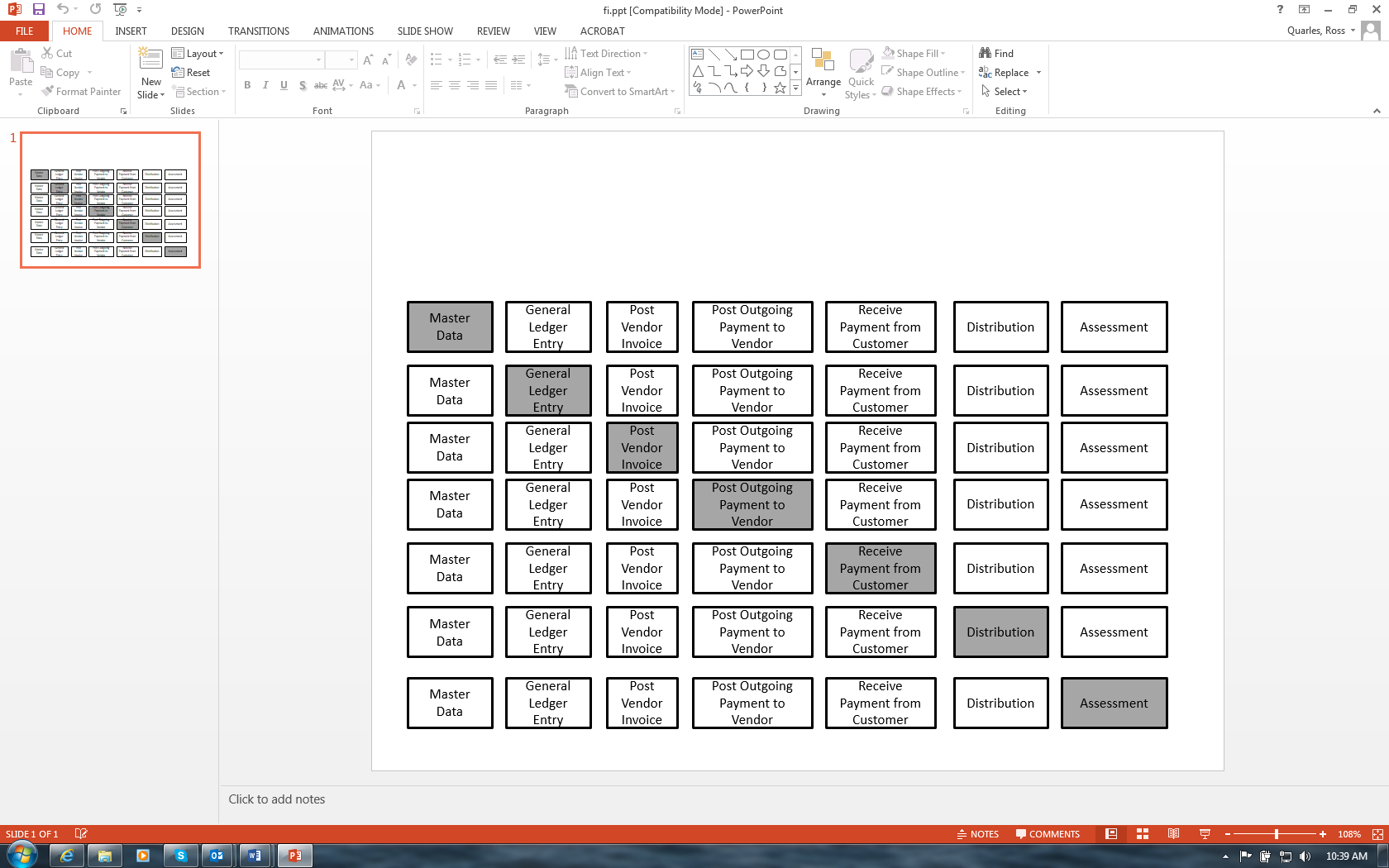
EXERCISE FI/CO11: POST OUTGOING PAYMENT
Bank data:
Account: Bank_ _ _ Value: ______________
All other settings remain unchanged
Select
Go back to the other session you have open (Alt + Tab) or open one if
you do not have another one open by clicking 
Accounting ⇒ Financial Accounting ⇒ Accounts Payable ⇒ Account ⇒ Display/Change Line Items
(EXECUTE)
Your resulting screen should look similar to that shown on the next page
PRINT THE SCREEN (IF REQUIRED BY YOUR INSTRUCTOR)
In second session, back three times to close the session
Accounting ⇒ Financial Accounting ⇒ Accounts Payable ⇒ Document Entry ⇒
Outgoing Payment ⇒ Post
Text: Invoice #??? from MM12
Open item selection:
(SAVE)
Record the document no._______________________
Company code: C_ _ _
Select Cleared items
Back twice to SAP Easy Access menu
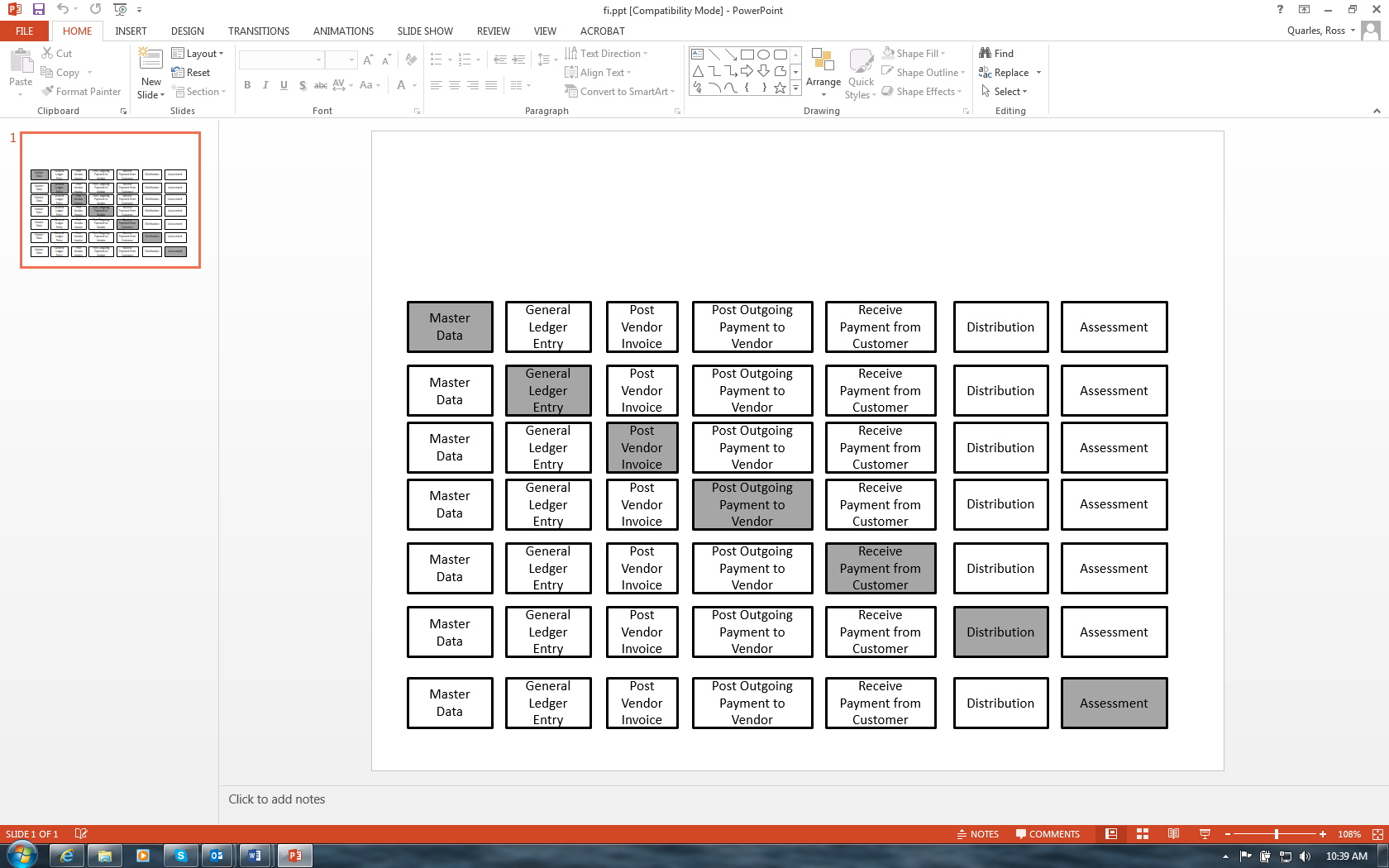
Document Date: Today’s date Value: ______________
Company Code: C_ _ _
Account: Sunny Porch Pastimes_ _ _ Value: ______________
Select
Logistics ⇒ Sales and Distribution ⇒ Sales ⇒ Inquiry ⇒ Display
Enter your inquiry number (from SD11 to Sunny Porch Pastimes_ _ _)
Go back and compare your screen to the screenshot you took when performing Exercise SD18, step 2. That screenshot shows the accounting document for the invoice as “Not cleared”. The second bullet arrow under SD18, step 13 states that “Not cleared” means collection has not occurred.
PRINT THE SCREEN (IF REQUIRED BY YOUR INSTRUCTOR)
Exercise FI/CO14: Create Distribution Cycle
Distribution accomplishes the charging of primary costs from a collection cost center to all of the cost centers that benefit from the incurrence of that primary cost. Periodically, usually at the end of the month, the primary cost element will be allocated (charged) to the receiving cost objects. The distribution process distributes the balance(s) from the original sender(s) to the receivers. The original sender account is credited, and the original receiver account is debited by the distribution. In this manner the distributed primary cost retains its identity in the receiving cost object’s expense list.
Fiscal Year: Current year Value: ______________
Extras⇒ Cycle⇒ Create
NOTE: Make sure Indicators does NOT have “Iterative” checked!
Select
Cost Center: Administration Value: ______________
Cost Element: Rent Expense_ _ _ Value: ______________
Var. portion type: Actual Statistical Key Figures
Click on to acknowledge message to maintain fields for statistical key figures
(SAVE)
Back three times to the “Execute Actual Distribution: Initial Screen”
Double click on the red Warning indicator
NOTE: IF THIS IS NOT THE FIRST MONTH OF THE YEAR, you should expect warning messages indicating that the system cannot find input data for the months previous to the current month
A010 Finance
A020 Human Resources
The reason it is proposed at this time is because you just performed a test run of the allocation.
If the top part of the screen is showing an error message of “This program cannot display the webpage”, please disregard. It will not interfere with the exercise being performed.
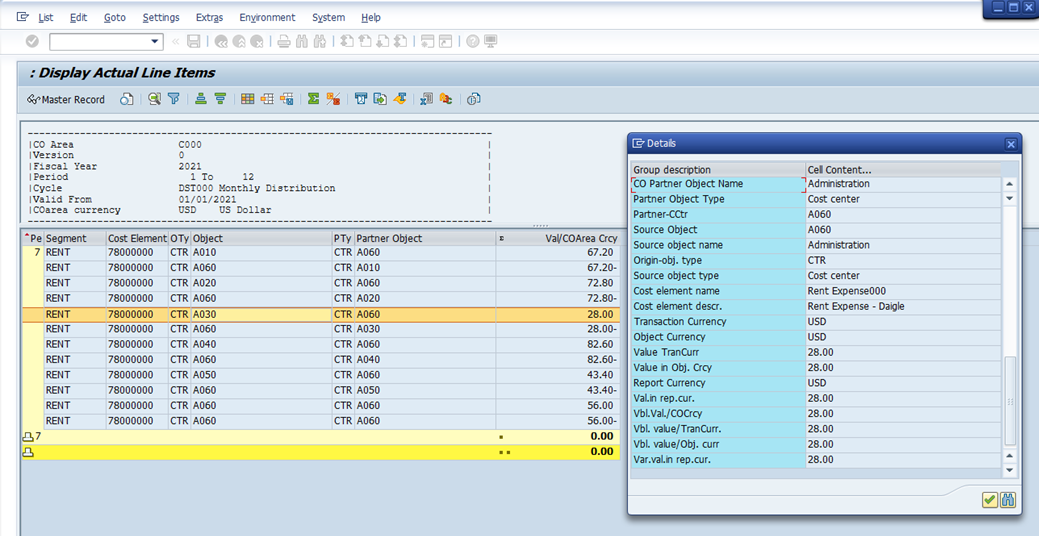
PRINT THE SCREEN (IF REQUIRED BY YOUR INSTRUCTOR) (FIRST MOVE THE POP-UP SCREEN TO THE BOTTOM SO THE SCREEN BEHIND CAN BE VIEWED IN YOUR SCREEN CAPTURE. Make sure BOTH your USER name is showing in the POP-UP screen As well.)
NOTE: The first time in the system may trip an error indicating that you must execute report RX811XST. This can be accomplished from the Error dialog box by double clicking on the proceed button (red lettering at bottom of error message). Click on the line item message and drop down in error message until highlighted red run report visible.
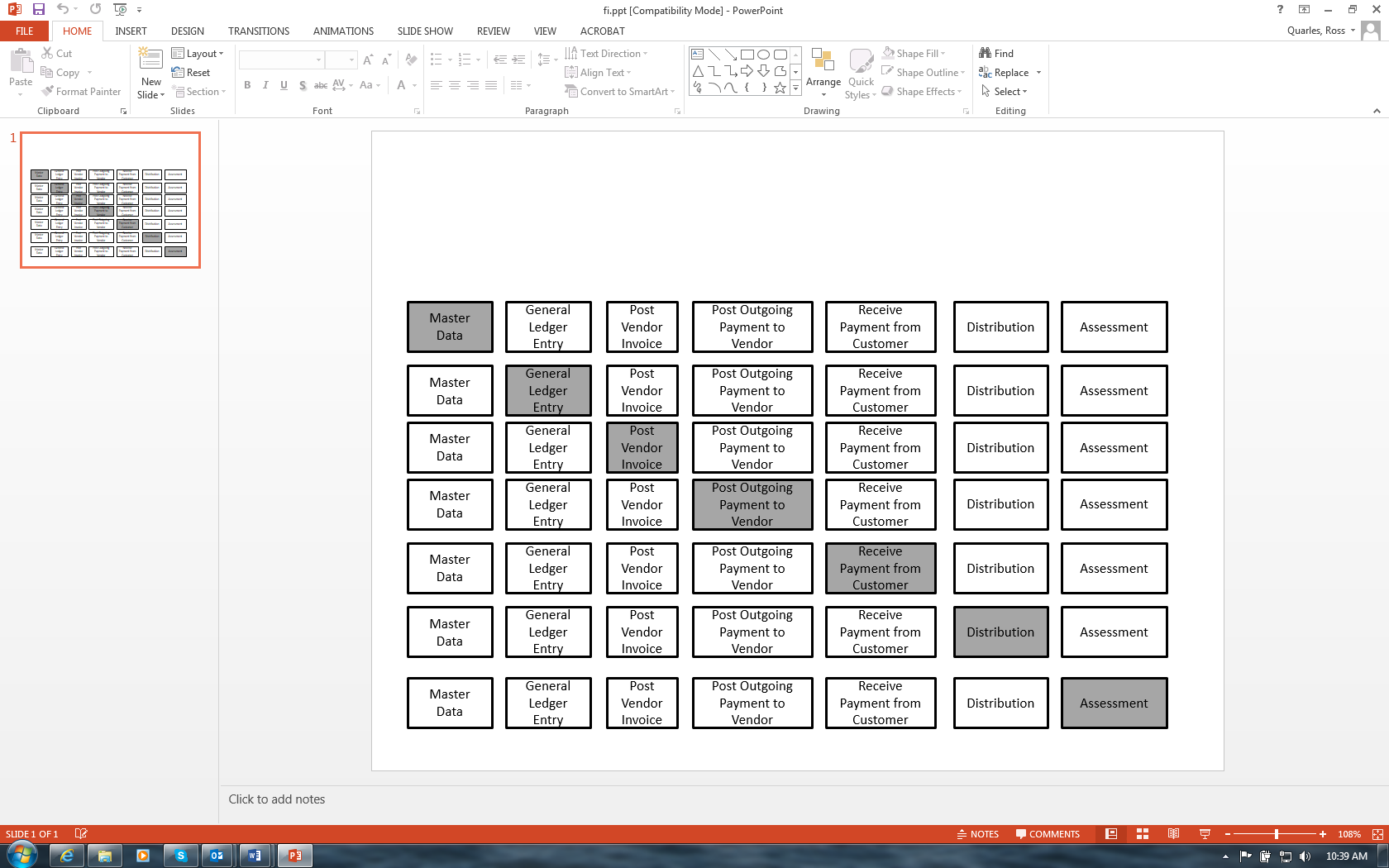
Cost Center: Finance to Administration Value: ______________
Cost Element: Rent Expense_ _ _ Value: ______________
Continued on next page
If the top part of the screen is showing an error message of “This program cannot display the webpage”, please disregard. It will not interfere with the exercise being performed.
Exit from the pop-up screen and back three times to SAP Easy Access Menu
Single Functions ⇒ Allocations ⇒ Assessment
If requested, set controlling area to C_ _ _ and SELECT
Start Date: 01/01/20yy
(ENTER)
Text: Assessment of Utilities
Segment Header TAB:
Senders/Receivers TAB:
Sender (under From column):
Receiver Tracing Factor TAB:
Cost Ctr Portion/percent
Back three times to the “Execute Actual Distribution: Initial Screen”
Save when asked whether to save cycle
Double Click on the Monthly Assessments line
The resulting screen (see next page for example) shows the proposed allocation of utilities expense on the plant to the following manufacturing cost centers, based on the percentages entered in step 12:
Compare your screen to that on the next page for agreement. If the top part of the screen is showing an error message of “This program cannot display the webpage”, please disregard. It will not interfere with the exercise being performed.
Continued on next page
Remove the check from the Test Run indicator
(EXECUTE) the distribution cycle again and review by repeating the reviewing steps above beginning with step 15.
Accounting⇒ Controlling⇒ Cost Center Accounting ⇒ Information System⇒
Reports for Cost Center Accounting⇒ Line items ⇒ Cost Centers: Actual Line Items
Open Documents/Objects folder, scroll down list to find User Name
Select User Name and click
P010 Assembly Line
P020 Warehouse
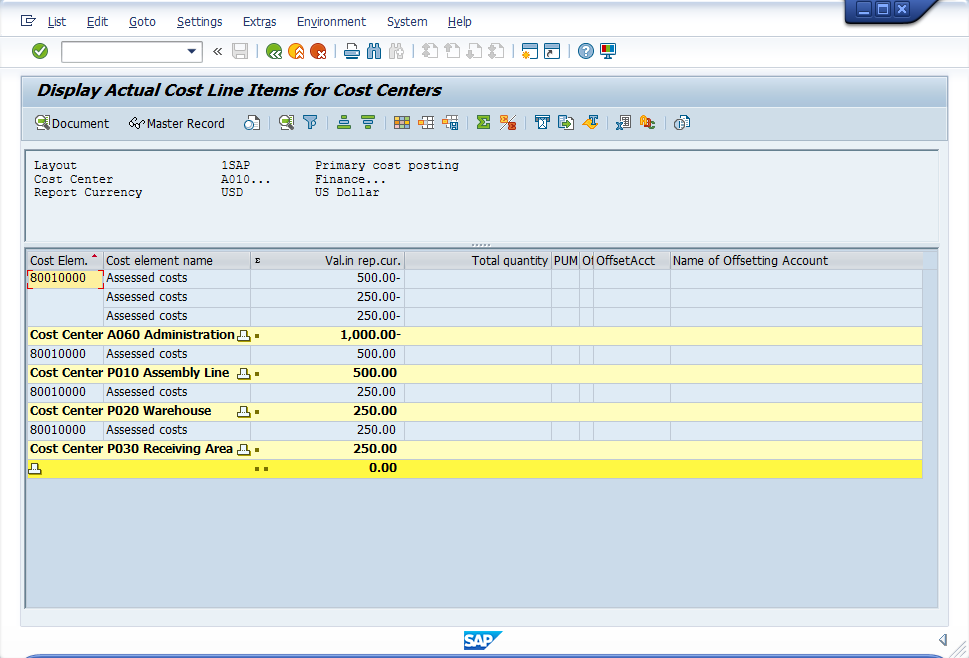
PRINT THE SCREEN (IF REQUIRED BY YOUR INSTRUCTOR)


